Fujitsu Client Computing WB0100 Fujitsu LIFEBOOK P727 User Manual
Fujitsu Limited Fujitsu LIFEBOOK P727
User Manual

System
Operating Manual
FUJITSU LIFEBOOK P727

Contact address in North America
FUJITSU AMERICA INC.
1250 East Arques Avenue, Sunnyvale,
CA 94085-3470, U.S.A.
Telephone: 800 831 3183 or 408 746 6000
"http://solutions.us.fujitsu.com"
"http://solutions.us.fujitsu.com/contact"
Have a question? Email us at: "AskFujitsu@us.fujitsu.com"
Copyright
©2017Fujitsu America, Inc. All rights reserved
B5FK-6481-01ENZ0-01
FUJITSU LIFEBOOK P727
Operating Manual
Declarations of conformity 9
Fujitsu Contact Information 10
Ports and controls 12
Important notes 15
First-time setup of your device 20
Working with the notebook 23
Security functions 67
Connecting external devices 75
Removing and installing components
during servicing 81
Settings in BIOS Setup Utility 89
Troubleshooting and tips 92
Technical data 101
Manufacturer’s notes 106
Declarations of conformity 109
FCC Regulatory Information 110
Canada, Industry Canada (IC) 113
Appendix 115
Index 133
Copyright and Trademark Information
Fujitsu America, Incorporated has made every effort to ensure the accuracy and completeness
of this document; however, as ongoing development efforts are continually improving the
capabilities of our products, we cannot guarantee the accuracy of the contents of this
document. We disclaim liability for errors, omissions, or future changes.
Fujitsu, the Fujitsu logo and LIFEBOOK are registered trademarks of Fujitsu Limited
or its subsidiaries in the United States and other countries.
Intel and Intel Core are trademarks or registered trademarks of Intel Corporation or
its subsidiaries in the United States and other countries.
Microsoft and Windows are either registered trademarks or trademarks of Microsoft
Corporation in the United States and/or other countries.
Bluetooth is a trademark of Bluetooth SIG, Inc., USA.
OmniPass is a trademark of Softex, Inc.
Roxio is a trademark of Roxio, a division of Sonic Solutions.
YouCam is a trademark of CyberLink Corp.
Adobe, Acrobat, and Adobe Reader are either a registered trademarks or trademarks of
Adobe Systems Incorporated in the United States and/or other countries.
The DVD player found in some models of the LIFEBOOK notebook incorporates copyright
protection technology that is protected by method claims of certain U.S. patents and other
intellectual property rights owned by Macrovision Corporation and other rights users. Use
of this copyright protection technology must be authorized by Macrovision Corporation, and
is intended for home and other limited viewing uses only unless authorized by Macrovision
Corporation. Reverse engineering or disassembly is prohibited.
All other trademarks specified here are the property of their respective owners.

Contents
Contents
Declarations of conformity ............................................................. 9
Fujitsu Contact Information ............................................................ 10
Notational conventions .................................................................. 11
Portsandcontrols ..................................................................... 12
Importantnotes ........................................................................ 15
Safetyinstructions ...................................................................... 15
Additional safety notes for devices with radio components . . . . . ............................. 16
Energysaving .......................................................................... 16
Energy saving under Windows ....................................................... 16
Traveling with your notebook . . ........................................................... 17
Beforeyoutravel ................................................................... 17
Transporting the notebook ........................................................... 18
Storing the notebook .................................................................... 18
Cleaning the notebook .................................................................. 19
Further informationoncleaningthenotebook .......................................... 19
First-timesetup ofyourdevice ......................................................... 20
Unpacking and checking the device . . . ................................................... 20
Choose a location . ...................................................................... 21
Connecting the AC adapter . . . ........................................................... 21
Switching on the device for the firsttime .................................................. 22
Installing Bonus Apps . . . . . ........................................................... 22
Working with thenotebook ............................................................ 23
Status indicators ........................................................................ 23
Opening the notebook ................................................................... 25
Switching the notebook on . . . . ........................................................... 26
ProgrammingtheON/OFFbutton ..................................................... 26
Different ways to use your notebook . . . ................................................... 27
From notebooktoTabletPC .......................................................... 27
Select displayorientation(portraitorlandscapeformat) ................................. 29
From TabletPCtonotebook .......................................................... 30
Switching off the notebook . . . . ........................................................... 31
Closing the notebook . . .................................................................. 32
Handwriting recognition .................................................................. 32
LCD screen ............................................................................ 33
Ambientlightsensor ................................................................. 33
Using thedeviceasaTabletPC .......................................................... 33
Using fingers ....................................................................... 33
Using thestylus(onlydeviceswithDualDigitizer) ...................................... 34
Using thedeviceasanotebook .......................................................... 38
Touchpadandtouchpadbuttons ...................................................... 38
Keyboard ............................................................................... 39
Virtualnumberkeys ................................................................. 42
Countryandkeyboardsettings ....................................................... 42
Key combinations ................................................................... 43
Tabletbuttons .......................................................................... 45
Webcam ............................................................................... 46
Rechargeablebattery ................................................................... 47
Fujitsu 3

Contents
Charging,caringforandmaintainingthebattery ....................................... 47
Removingandinstallingthebattery ................................................... 47
Batterychargingstatusindicator ...................................................... 50
Modules ............................................................................... 51
Removing a modular bay device . . . . . ................................................. 51
Installing a modular bay device . . . . . . ................................................. 52
Opticaldrive ............................................................................ 52
Handling optical disks . . . ............................................................ 52
CD/DVDindicator ................................................................... 53
Insertingorremovinganopticaldisk .................................................. 53
Manual removal (emergency removal) . . . ............................................. 54
Usingtheenergysavingfunctions ........................................................ 55
Memorycards .......................................................................... 56
Supportedformat .................................................................... 56
Insertingthememorycard ........................................................... 56
Removingthememorycard .......................................................... 56
Speaker and microphone ................................................................ 57
SIMcard ............................................................................... 58
InsertingaSIMcard ................................................................. 58
RemovingaSIMcard ............................................................... 59
Optional wireless LAN/Bluetooth components . . . .................................. 59
Switching the wireless components on and off ......................................... 59
ConfiguringWLANaccess ........................................................... 60
FurtherinformationonWLANandBluetooth ........................................... 60
Eth
ernetandLAN ....................................................................... 62
Notes ............................................................. . . . . . . . . . . 63
Connecting the AC adapter to the port replicator . . . . .................................. 65
Switching on the notebook via the port replicator . . . . . .................................. 65
Disconnecting the notebook from the port replicator . .................................. 66
Sec
urityfunctions ..................................................................... 67
Briefoverviewofthesecurityfunctions .................................................... 68
Configuring the fingerprint sensor ........................................................ 69
UsingtheSecurityLock ................................................................. 70
ConfiguringpasswordprotectioninBIOSSetupUtility ...................................... 70
Protecting BIOS Setup Utility (supervisor password and user password) . . ............... 71
Password protection for booting the operating system .................................. 72
Passwordprotectionfortheharddisk ................................................. 72
Smart Card reader . . . . . . ................................................................ 73
InsertingtheSmartCard ............................................................. 73
Trusted Platform Module - TPM (device dependent) . . . . . . .................................. 74
EnablingTPM ....................................................................... 74
DisablingTPM ...................................................................... 74
Connectingexternaldevices ........................................................... 75
Connecting an external monitor . . ........................................................ 76
HDMIport .......................................................................... 77
Connecting USB devices ................................................................ 77
USBportwithchargingfunction(AnytimeUSBcharge) ................................. 78
4Fujitsu

Contents
Connecting an external SATA hard drive (eSATA) (port replicator only) . . . . . .............. 79
SaferemovalofeSATAandUSBdevices ............................................. 79
Connecting external audio devices ....................................................... 80
Microphone port/Line In . . . ........................................................... 80
Headphones port . . .................................................................. 80
Removing and installing components during servicing . . . . ............................. 81
Notesoninstallingandremovingboardsandcomponents .................................. 81
Preparing to remove components . ....................................................... 82
Removing and installing memory expansion . . . ............................................ 82
Removethecover ................................................................... 83
Removingamemorymodule ......................................................... 83
Installingamemorymodule .......................................................... 84
Attachingthecover .................................................................. 84
Removingandinstallingtheharddisk .................................................... 85
Removethecover ................................................................... 85
Removingtheharddisk .............................................................. 86
Installingaharddisk ................................................................. 87
Attachingthecover .................................................................. 88
Finishing component removal . ........................................................... 88
Settings in BIOS Setup Utility . . . ....................................................... 89
StartingtheBIOSSetupUtility ........................................................... 89
BIOSSetupUtilityoperation ............................................................. 90
ExitingBIOSSetupUtility ................................................................ 91
Exit Saving Changes - save changes and exit BIOS Setup Utility . . ..................... 91
Exit Discarding Changes - Reject changes and exit BIOS Setup Utility . . . . . .............. 91
Load Setup Defaults – load default values . ............................................ 91
Discard Changes - Discard Changes without exiting BIOS Setup Utility . . . . .............. 91
Save Changes - save changes without exiting the BIOS Setup Utility . . . . . . .............. 91
Savechangesandpoweroff ........................................................ 91
Troubleshooting and tips .............................................................. 92
Helpifproblemsoccur ................................................................... 92
RecoveringyourFactoryImage .......................................................... 92
The notebook’s date or time is incorrect ................................................... 93
Battery indicator does not illuminate . . . ................................................... 93
Whencertaincharactersareenteredonthekeyboard,onlynumeralsarewritten ............. 93
The notebook’s LCD screen remains blank . . . . ............................................ 93
The LCD screen of the notebook is difficulttoread ......................................... 93
Theexternalmonitorremainsblank ...................................................... 94
Theexternalmonitorisblankortheimageisunstable ..................................... 94
The cursor does not correctly follow the stylus movements . . . . ............................. 95
Stylusinputnotworking ................................................................. 95
The notebook does not start after switching it on . . . ........................................ 95
The notebook stops working . . ........................................................... 96
The printer does not print . . . . . ........................................................... 96
The wireless connection to a network does not work . . . .................................... 96
Thebatterydischargestooquickly ........................................................ 97
Smart Card reader is not recognized . . . ................................................... 97
SmartCardPINforgotten ................................................................ 97
SmartCardlost ......................................................................... 97
User and/or supervisor Smart Card lost . . . . . . ............................................ 98
Acousticwarning ........................................................................ 98
Fujitsu 5

Contents
Error messages on the screen . . . ........................................................ 99
Technical data ......................................................................... 101
Notebook . . . . ........................................................................... 101
WLAN specifications .................................................................... 102
Portreplicator(optional) ................................................................. 104
Rechargeable battery . . . ................................................................ 104
AC adapter for use with notebook and port replicator . . . . . .................................. 105
Manufacturer’snotes .................................................................. 106
Disposalandrecycling .................................................................. 106
Recyclingyourbattery ............................................................... 106
DOC (Industry CANADA) Notices ........................................................ 106
ULNotice ........................................................................... 107
ENERGYSTARCompliance ............................................................. 108
Declarations of conformity ............................................................. 109
FCC RegulatoryInformation ........................................................... 110
RegulatoryNotesandStatements ........................................................ 110
WirelessLAN,HealthandAuthorizationforuse ........................................ 110
Regulatory Information/Disclaimers . . ................................................. 111
Federal Communications Commission and Industry Canada statement: . . . ............... 111
FCCInterferenceStatement ......................................................... 111
FCC Radio Frequency Exposure statement . . . ......................................... 112
Exportrestrictions ................................................................... 112
Restrictions concernant l’exportation . ................................................. 112
Canada,Industry Canada(IC) .......................................................... 113
Canadian Notice . ....................................................................... 113
Avis pour le Canada . . . . . ................................................................ 114
Appendix .............................................................................. 115
Before Using the Optional Wireless LAN . ................................................. 115
WirelessLANDevicesCoveredbythisDocument ...................................... 115
CharacteristicsoftheWLANDevice .................................................. 115
Wireless LAN Modes Using this Device . . ............................................. 116
Deactivating/DisconnectingtheWLANDevice ......................................... 118
ConfiguringtheWirelessLAN ............................................................ 119
Configuring the WLAN Using Windows . . . ............................................. 119
Connection to the network . . . ........................................................ 119
TroubleshootingtheWLAN ........................................................... 120
UsingtheBluetoothDevice .............................................................. 122
Image Backup and Recovery Procedures ................................................. 123
Windows® 7 Procedures ................................................................ 123
Creating a Backup of Bootable Disc and Recovery Image for Windows 7 . ............... 123
Creating a backup of the System-SpecificSoftwareDrivers ............................. 124
WINDOWS 7 RECOVER YOUR SYSTEM WHEN THE HARD DRIVE IS STILL
ACCESSIBLE ....................................................................... 124
RECOVER YOUR SYSTEM WHEN THE HARD DRIVE IS NOT BOOTABLE FOR
WINDOWS7 ....................................................................... 126
Recovering Your Recovery Image Using Recovery and Utility (for new hard drive or
non-bootableharddrive) ............................................................. 127
InstallingtheSoftwareaftertheRecoveryImageisRestored ............................ 128
Windows® 10 Procedures . . . ............................................................ 129
6Fujitsu

Contents
Creatingarecoverydrive ............................................................ 129
Recovery options in Windows 10 . . ................................................... 129
Downloading driver updates . . ........................................................... 132
Index .................................................................................. 133
Fujitsu 7

Contents
8Fujitsu

Declarations of conformity
Declarations of conformity
DECLARATION OF CONFORMITY
according to FCC Part 15
Responsible Party Name:
Address:
Telephone:
Declares that product:
Fujitsu America, Inc.
1250 E. Arques Avenue
Sunnyvale, CA 94085
(408) 746-600
Base Model Configuration: LIFEBOOK P727 Notebook
Complies with Part 15 of the FCC Rules.
This device complies with Part 15 of the FCC rules. Operations are subject to the
following two conditions: (1) This device may not cause harmful interference. (2) This
device must accept any interference received, including interference that may cause
undesired operation.
Fujitsu 9

Fujitsu Contact Information
Fujitsu Contact Information
Service and Support
You can contact Fujitsu Service and Support in the following ways:
• Toll free phone: 1-800-8Fujitsu (1-800-838-5487)
• Website: "http://solutions.us.fujitsu.com/www/content/support/contact/index.php"
Before you place the call, have the following information ready so that the customer
support representative can provide you with the fastest possible solution:
• Product name
• Product configuration number
• Product serial number
• Purchase date
• Conditions under which the problem occurred
• Any error messages that have occurred
• Type of device connected, if any
Fujitsu Shopping Online
Please go to "http://www.shopfujitsu.com/store/ ".
Maintaining Latest Confguration
To ensure that you always have the most current driver updates related to your system, you should
occasionally access the Fujitsu Software Download Manager (FSDM) utility. The FSDM utility is
available from the Fujitsu Support site. FSDM will allow you to view a list of the most current
drivers, utilities and applications to determine whether you have the latest versions. If you have a
Windows 7 or Windows 10 operating system, you will need to go to the Support Site to download
the FSDM Utility: "http://support.fujitsupc.com/CS/Portal/support.do?srch=DOWNLOADS".
Limited Warranty
Your LIFEBOOK notebook is backed by a Fujitsu International Limited Warranty. Check the service
kit that came with your notebook for the Limited Warranty period and terms and conditions.
10 Fujitsu
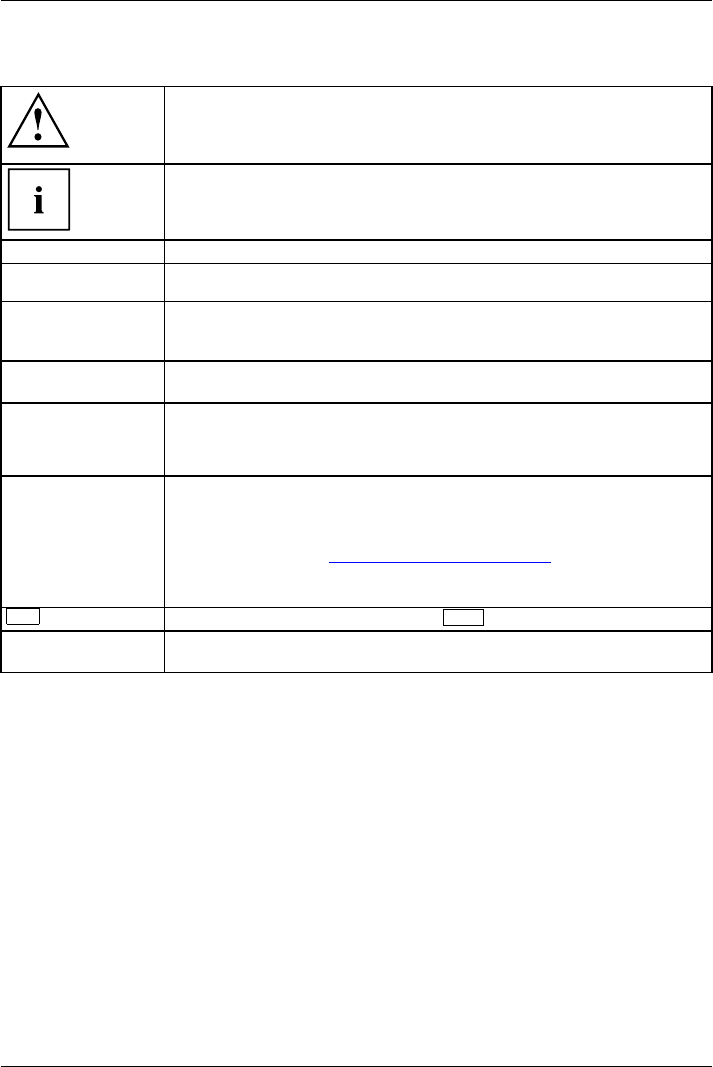
Fujitsu Contact Information
Notational conventions
Pay particular attention to text marked with this symbol. Failure to observe
this warning will endanger your life, will damage the device or lead to loss
of data. The warranty will be invalidated if the device becomes defective
through failure to observe these warnings.
Indicates important information which is required to use the device properly.
►indicates an activity that must be performed
indicates a result
This style indicates data entered using the keyboard in a program dialogue or at
the command line, e.g. your password (Name123)oracommandusedto
start a program (start.exe)
This style indicates information that is displayed on the screen by a program, e.g.:
Installation is complete.
This style indicates
• terms and texts used in a software interface, e.g.: Click on Save.
• names of programs or files, e.g. Windows or setup.exe.
"This style" indicates
• Cross-references to another section, e.g. "Safety information"
• cross-references to an external source, e.g. a web address: For more
information, go to "http://solutions.us.fujitsu.com/"
• names of CDs, DVDs and titles or designations of other materials, e.g.:
"CD/DVD Drivers & Utilities" or "Safety/Regulations" manual
Key indicates a key on the keyboard, e.g: F10
This style indicates terms and text that are emphasized or highlighted, e.g.: Do not
switch off the device
Fujitsu 11
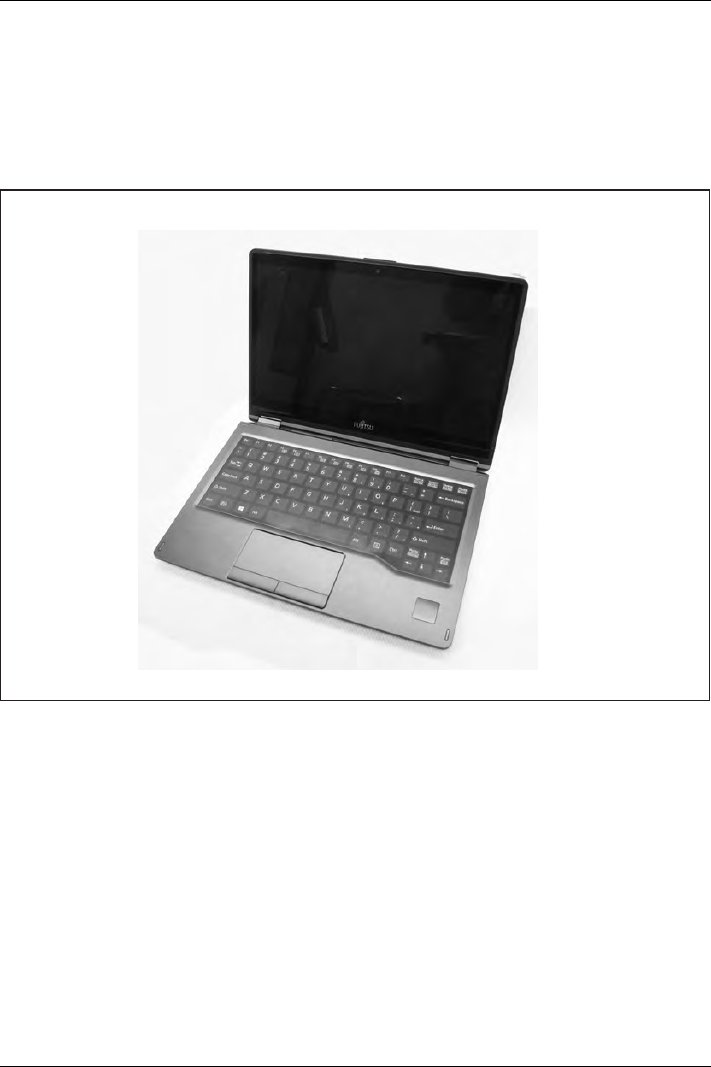
Ports and controls
Ports and controls
This chapter presents the individual hardware components of your device. It gives an
overview of the indicators and connections of the device. Please familiarize yourself
with these items before you start to work with the device.
Notebook open
1 = Microphone
2 = Webcam
3 = Webcam LED
4 = UMTS/LTE antenna
5 = Fingerprint sensor (device-dependent)
6 = Ambient light sensor
7 = Speaker
8 = Windows button
9 = ON/OFF switch
10 = Status indicators
11 = Keyboard
12 = Touchpad
13 = Touchpad buttons
14 = Pen slot
15 = Lock slot
16 = Memory card slot
12 Fujitsu
1 2 3 1
4
10
16
15
14
5
9
6 7
12
13
8
7
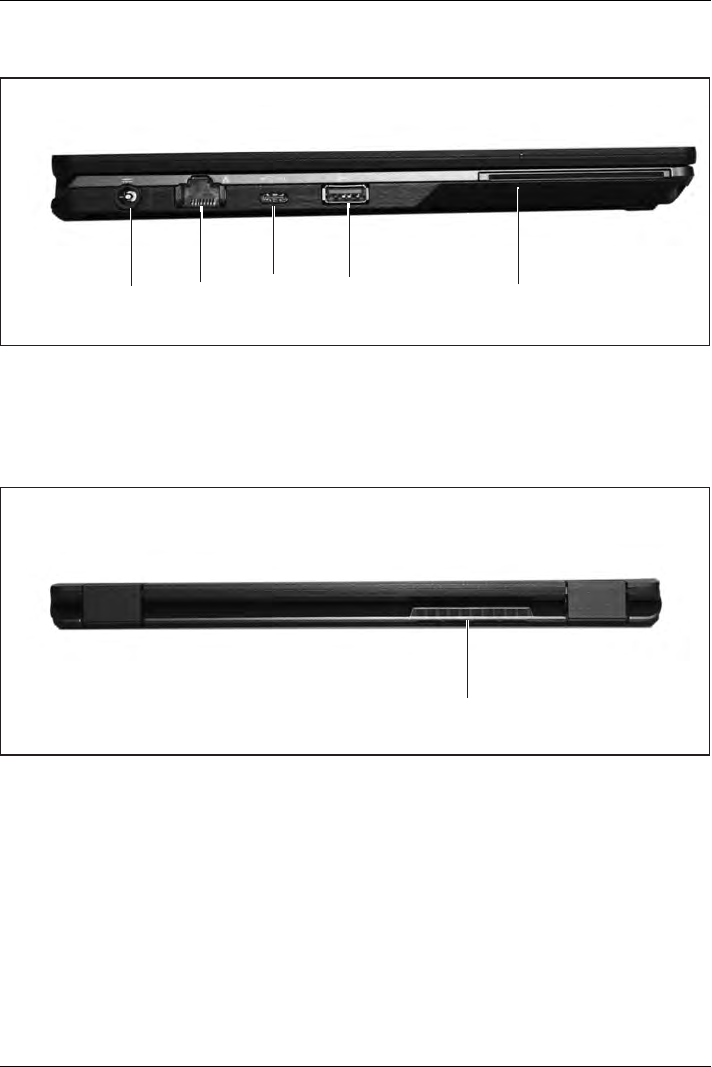
Ports and controls
Left-hand side
123 5
4
5 = Smart Card slot1 = Pen slot
2 = LAN
3 = USB-C
4 = USB 3.0
Rear
1 = Vent
Fujitsu 13
1
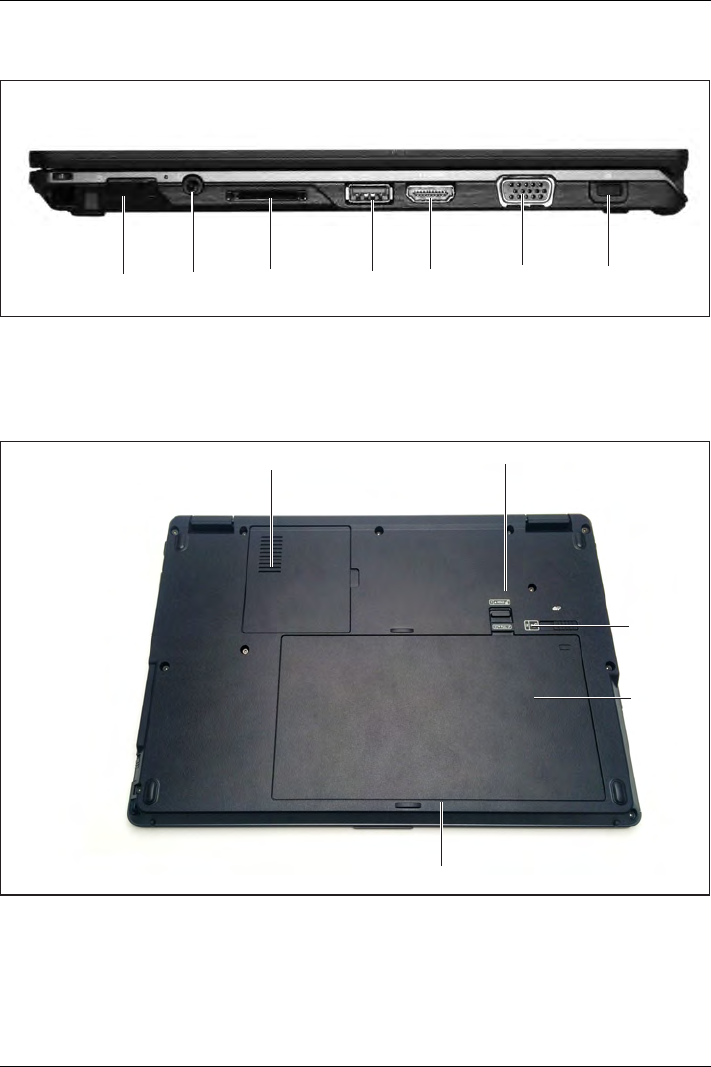
Ports and controls
Right-hand side
1234
4=USBport3.0
5 = DP
6 = VGA
7 = Lock slot
1 = Power switch
2 = Power port
3 = SD card slot
Bottom
1,2 3
4
5
6
1 = Hard disk service compartment
2 = Memory upgrade compartment
3 = Battery access door latch
4 = Battery lock slider
5 = Battery with SIM card slot under the battery
6 = Batter and SIM card access door
14 Fujitsu
7
56

Important notes
Important notes
ImportantnotesNotes
This chapter contains essential safety information which must be followed
when working with your notebook. Other notes also provide useful information
which will help you with your notebook.
Safety instructions
SafetyinformationInform ation,
Please observe the following safety information.
Please pay special attention to the sections in the manual marked
with the symbol on the left.
When connecting and disconnecting cables, observe the relevant
notes in this operating manual.
Read the information on the ambient conditions in the "Technical data", Page 101
chapter and the "First-time setup of your device", Page 20 chapter before preparing
your notebook for use and switching it on for the first time.
When cleaning the device, please observe the relevant notes in the
section "Cleaning the notebook", Page 19.
Pay attention to the additional safety notes for devices with radio components
provided in the "Safety/Regulations" manual.
Please refer to the notes in the chapter "Removing and installing
components during servicing", Page 81.
When handling this device, you will come into contact with lead, a chemical which in
California is held to be a possible cause of birth defects and other damage to fertility.
Wash your hands after using the device.
This notebook complies with the relevant safety regulations for data processing equipment.
If you have any questions about setting up your notebook in the intended environment,
please contact your sales outlet or our Hotline/Service Desk.
Fujitsu 15
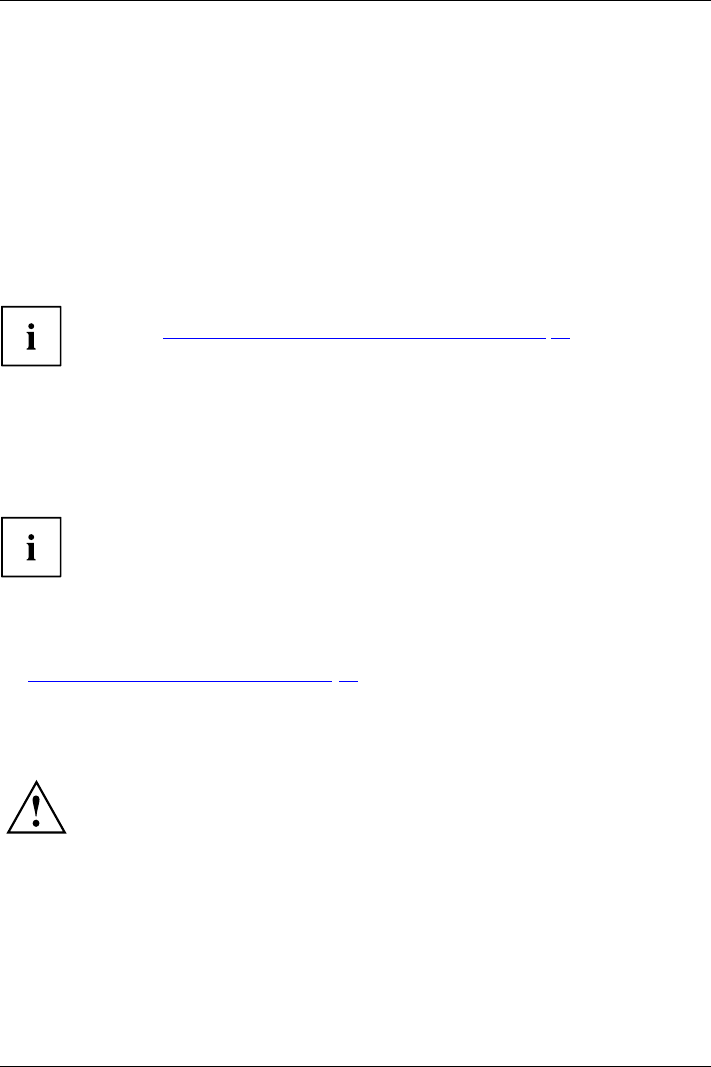
Important notes
Additional safety notes for devices with
radio components
BRWliuradieelotoecossthomL,ASponNafeenttynsotes
If a radio component (Wireless LAN, Bluetooth, UMTS) is incorporated in your notebook, you
must be sure to observe the following safety notes when using your notebook:
• Switch off the radio components when you are in an aircraft or driving in a car.
• Switch off the radio components when you are in a hospital, an operating room or near a medical
electronics system. The transmitted radio waves can impair the operation of medical devices.
• Switch off the radio components, when you let the device get near flammable gases
or into hazardous environments (e.g. gas station, paintshops), as the transmitted
radio waves can cause an explosion or a fire.
For further information on how to switch the radio components on and off, refer
to chapter "Switching the wireless components on and off", Page 59.
Energy saving
NotesEnergyPowersaving
Switch the notebook off when it is not in use. Switch off any connected external devices when
they are not in use. If you use the energy saving functions, the notebook uses less power. You
will then be able to work for longer before having to recharge the battery.
The energy efficiency is increased and environmental pollution is reduced.
You save money and help protect the environment.
Energy saving under Windows
►Make use of the available energy saving functions as described in chapter
"Using the energy saving functions", Page 55.
16 Fujitsu
Protecting the display screen
Depending on your device configuration, where applicable, your device is not
waterproof.
In this event, do not pour liquids into the device and do not wash it with a wet cloth.
Do not place items item on the top if the display or damage may occur.
The warranty does not cover a scratched screen.
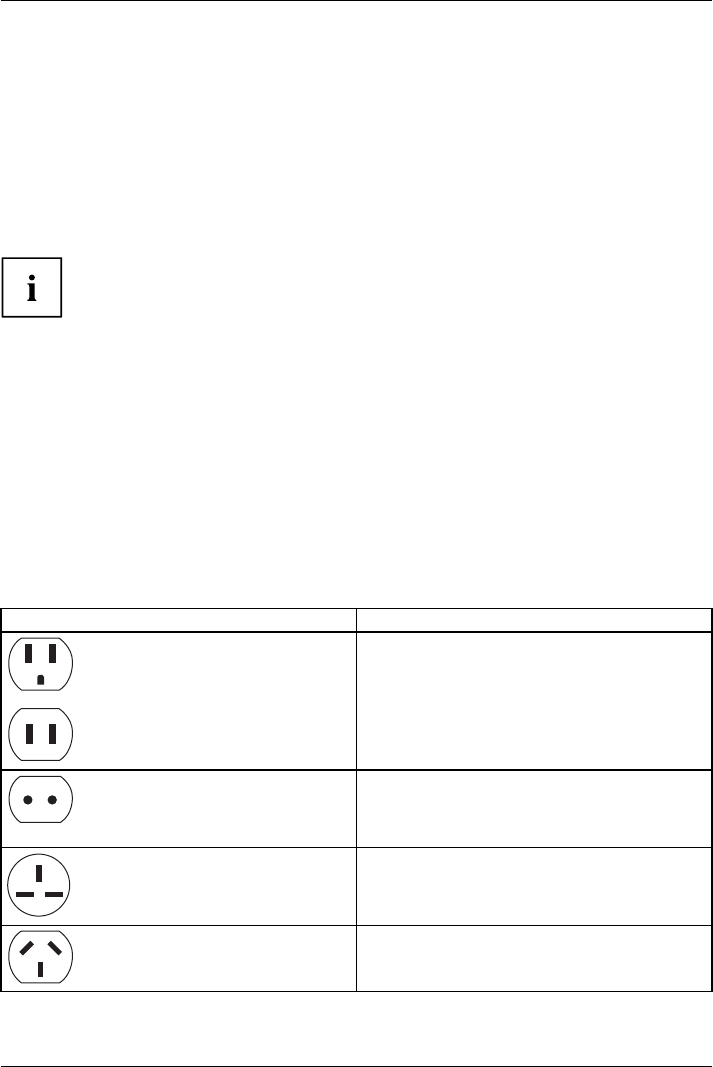
Important notes
Traveling with your notebook
MobileoperationNotesTr ansp ortNotebook
Please observe the points listed below when traveling with your notebook.
Before you travel
►Back up important data stored on your hard disk.
NotebookTraveling,notebook
►Switch off the radio component for data security reasons. With data traffic via a wireless
connection, it is also possible for unauthorized third parties to receive data.
Information on activating data encryption is provided in the documentation
for your radio component.
►If you wish to use your notebook during a flight, check with the flight attendants if its use is safe.
When traveling in other countries
►If you are traveling abroad, check that the AC adapter can be operated with the local AC
voltage. If this is not the case, obtain the appropriate AC adapter for your notebook.
Do not use any other converter!
►Check whether the local AC voltage and the AC cable are compatible. If this is not
the case, buy an AC cable that suits the local conditions.
►Enquire with the corresponding government office of the country you will be traveling to,
whether you may use your notebook with its integrated radio component there.
►Take the necessary travel adapters with you when traveling abroad. Check the following
table to see which travel adapters you will need, or ask your travel organizer.
Power connection Travel destination
United States, Canada, Mexico, parts of Latin
America, Japan, Korea, Philippines, Taiwan
Russia and the Commonwealth of Independent
States (CIS), much of Europe, parts of Latin
America, the Middle East, parts of Africa, Hong
Kong, India, much of south-east Asia
United Kingdom, Ireland, Malaya, Singapore,
parts of Africa
China, Australia, New Zealand
Fujitsu 17

Important notes
Transporting the notebook
Protect the notebook from severe shocks and extreme temperatures
(e.g. direct sunlight in a car).
►If your device has an optical drive, remove all optical disks from the drives (e.g. CD, DVD).
TransportNotebook
►Switch the notebook off.
►Unplug the AC plug of the AC adapter and all external devices from the power outlets.
►Disconnect the AC adapter cable and the data cables for all external devices.
►Close the LCD screen.
►To protect against damaging jolts and bumps, use a notebook carrying
case to transport your notebook.
Storing the notebook
• If storing your notebook for a month or longer, turn it off, fully charge the battery, then
remove and store all the Lithium Polymer batteries in a suitable location.
• Store your notebook in a cool dry location. Temperatures should remain
between 13 ºF / -25 ºC and 140 ºF / 60 ºC.
• Store your notebook and batteries separately. If you store your notebook with a
battery installed, the battery will discharge, and battery life will be reduced. In
addition, a faulty battery might damage your notebook.
• Always power off the notebook before transporting and/or packaging it.
After shutting down the notebook, wait until the status LED panel indicates
the power-off condition (i.e., no lights are illuminated).
• It is possible that the notebook may not automatically go to power-off or sleep mode
when you close the lid. This situation may occur due to pre-operating system boot
password security settings or some other application running on the notebook.
• Attempting to transport the notebook while power is on may damage
the notebook due to shock or overheating.
18 Fujitsu

Important notes
Cleaning the notebook
• Use of incorrect cleaners can result in optical impairment of the LCD and / or
damage to the notebook. Always refer to the cleaner manufacturer’s guidelines and
material safety data sheets for proper handling and use of the products.
• Never use ammonia, acidic, or alkaline cleaners or organic chemicals
such as paint thinner, acetone or kerosene. It may damage surface
finishes and the coating of the LCD screen.
• Never use compressed air for cleaning the notebook.
• If your notebook has a Smart Card slot, be very careful to avoid any liquid
entering the slot as this can damage the notebook.
Further information on cleaning the notebook
The notebook does not float.
If the notebook is exposed to water or other liquids with its connections open, liquid
can penetrate the notebook and cause a malfunction. Do not continue to use the
notebook. Switch it off and contact our hotline / our service desk (see enclosed list of
service desks or visit our website at: "http://www.fujitsu.com/us/support/").
Fujitsu 19

First-time setup of your device
First-time setup of your device
First- timese tupGettingstarted
Please read the chapter "Important notes", Page 15.
If your device is equipped with a Windows operating system, the necessary
hardware drivers and supplied software are already pre-installed.
Beforeswitchingitonforthefirst time, connect the device to the AC voltage using
the AC adapter, see "Connecting the AC adapter", Page 21. The AC adapter must
remain connected during the whole of the installation process.
A system test is performed when your device is first switched on. Various messages
can appear. The display may remain dark for a short time or may flicker.
Please follow the instructions on the screen.
NEVER switch off your device during the first-time setup process.
When the device is delivered, the battery is located in the battery compartment. The battery
must be charged if you want to operate your device using the battery.
When used on the move, the built-in battery provides the device with the necessary power. You
can increase the operating time by using the available energy saving functions.
For instructions on how to connect external devices (e.g. mouse, printer) to your
device, please refer to the operating manual for your device.
Unpacking and checking the device
If you find that damage has occurred during transport, please notify
your local sales outlet immediately!
►Unpack all the individual parts.
PackagingTransport
►Check your device for any visible damage which may have occurred during transportation.
You may need to reuse the packaging in the future, for example if
you need to ship your device.
20 Fujitsu
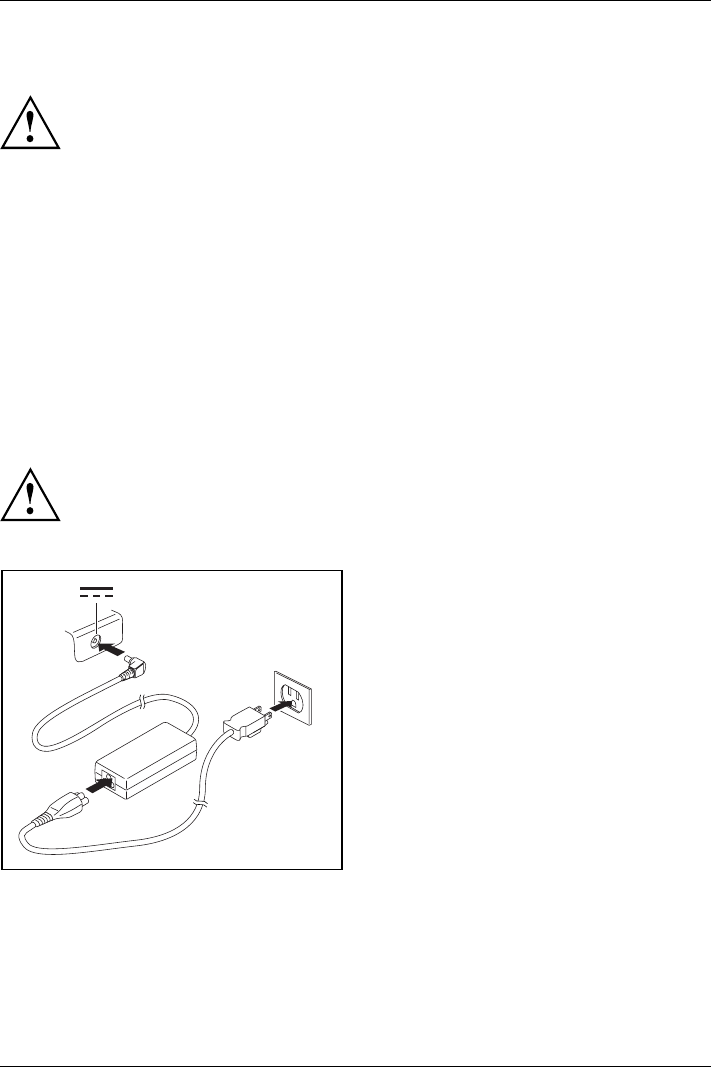
First-time setup of your device
Choosealocation
Choosealoc ationSetupACadapter
Choose a suitable location for the device before setting it up. In doing
so, please follow these instructions:
• Never place the device or the AC adapter on a heat-sensitive surface.
The surface could be damaged as a result.
• Never place the device on a soft surface (e.g. carpeting, upholstered furniture,
bed). This can block the air vents and cause overheating and damage.
• The underside of the device heats up during normal operation. Prolonged contact
with the skin can become unpleasant or even result in burns.
• Place the device on a stable, flat, non-slippery surface. Please note that the
rubber feet of the device may mark certain types of delicate surfaces.
• Keep other objects at least 100 mm / 3.97 inches away from the device
and its AC adapter to ensure adequate ventilation.
• Never cover the ventilation openings of the device.
• Do not expose the device to extreme environmental conditions.
Protect the device against dust, humidity and heat.
Connecting the AC adapter
MakingreadytouseACadapter
Observe the safety notes in the enclosed "Safety/Regulations" manual.
The supplied AC cable conforms to the requirements of the country in which
you purchased your device. Make sure that the AC cable is approved for
use in the country in which you intend to use it.
3
1
2
►Connect the AC cable (1) to the AC adapter.
►Plug the AC cable (2) into a power outlet.
►Connect the AC adapter cable (3) to the
DC jack (DC IN) of the device.
Fujitsu 21

First-time setup of your device
Switching on the device for the frst time
Switchingonforthefirstt ime
To make it easier to use your device for the first time, the operating system
is pre-installed on the hard disk.
►During the installation process, follow the on-screen instructions.
You can find information and help on the Windows operating system functions
on the Internet at "http://windows.microsoft.com".
Installing Bonus Apps
BonusApps
After you have started your system the first time, you will see a Bonus Apps icon on your desktop.
►Click on the icon to see which additional applications are available for you to install.
Applications that are already installed appear in grey, those that are
available for installation appear in blue.
►Select the applications you wish to install by selecting the checkbox adjacent to your selection.
or
►Click Select All if you would like to install all available applications.
►To confirm your selection, click Install.
Note that in some cases (depending upon which application was selected for
installation) after installation completes, the system will prompt you to reboot.
There are also cases in which if multiple applications are selected to install
but one of them needs a reboot, the system will reboot and continue
installing the rest of the selected applications.
22 Fujitsu
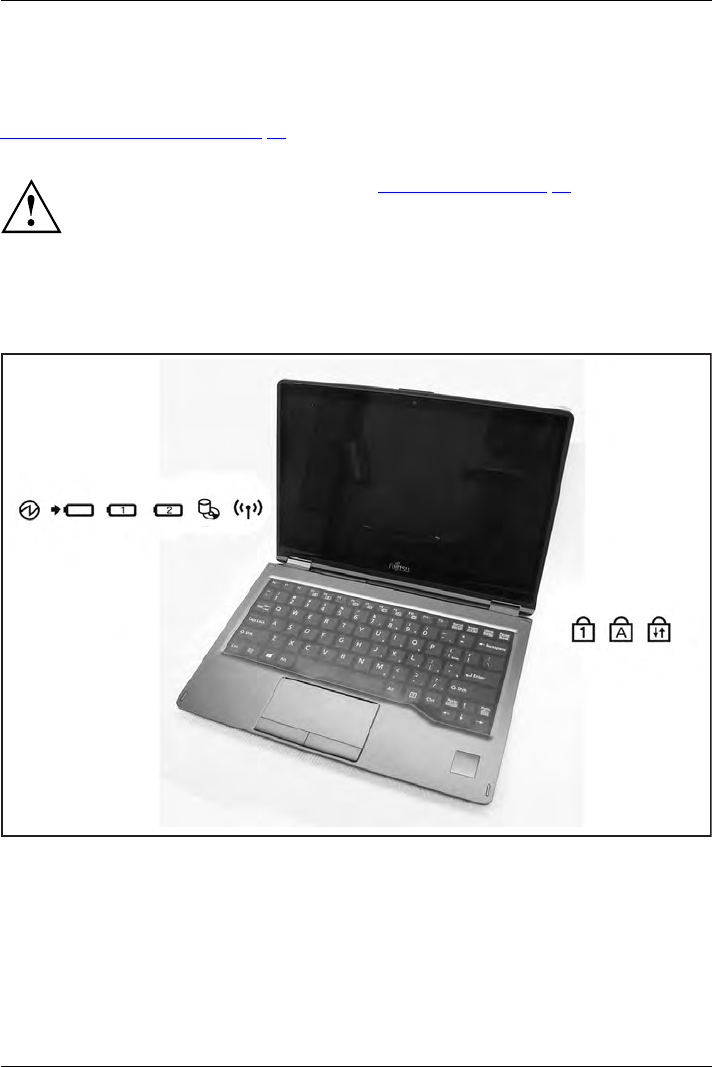
Working with the notebook
Working with the notebook
Operation,notebo okNotebook
This chapter describes the basics for operating your notebook. Please refer to
"Connecting external devices", Page 75 for instructions on how to connect external
devices such as a mouse and a printer to the notebook.
Please refer to the notes in the chapter "Important notes", Page 15.
Status indicators
StatusindicatorsSymbols
The status indicators provide information about the status of the power supply,
the drives and the keyboard functions, etc.
Fujitsu 23
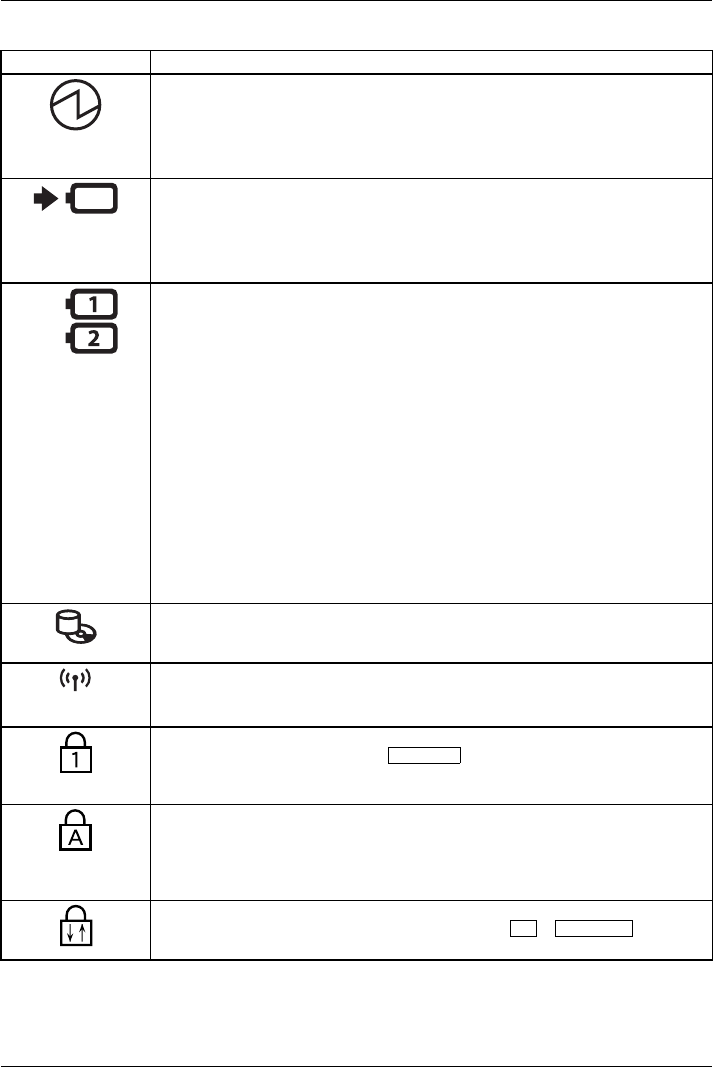
Working with the notebook
Status indicator Description
Power-on indicator
• The indicator is illuminated: The notebook is switched on.
• The indicator flashes: The notebook is in sleep mode (Save-to-RAM).
• The indicator is not lit up: The notebook is switched off or the notebook is
in Save-to-Disk mode.
Battery charging indicator
The battery charging indicator shows whether a battery is installed and being
charged.
Note: Battery charging will not start if the battery is already more than 90%
charged.
Battery indicator
This description applies for both batteries.
The battery indicator shows the battery charging level of the two installed
batteries.
• The indicator light is green: The battery is between 51 % and 100 %
charged.
• The indicator light is orange: The battery is between 13% and 50%
charged.
• The indicator lights up red: The battery is between 0 % and 12 % charged.
• The indicator is flashing orange: The battery charging level is being
checked (for four seconds after battery installation).
•Theindicatorisflashing red: The battery is faulty.
• The indicator is not lit up: There is no battery installed.
Note: You can also check the battery charging level directly on the main
battery.
Drive indicator
The indicator is illuminated: The hard disk drive or the CD/DVD in the optical
drive of the notebook is being accessed.
Wireless indicator
• The indicator is illuminated: The wireless components are switched on.
• Indicator is off: The wireless components are switched off.
Num Lock indicator
The indicator is illuminated: The Num Lock key has been pressed. The virtual
numeric keypad has been activated. You can output the characters indicated
on the upper right of the keys.
Caps Lock indicator
The indicator is illuminated: The Caps Lock key has been pressed. All
characters are displayed in upper case. In the case of overlay keys, the
character printed on the upper left of the key will appear when that key is
pressed.
Scroll Lock indicator
The indicator is illuminated: The key combination FN +Scroll Lock has been
pressed. The effect that this key has varies between applications.
24 Fujitsu
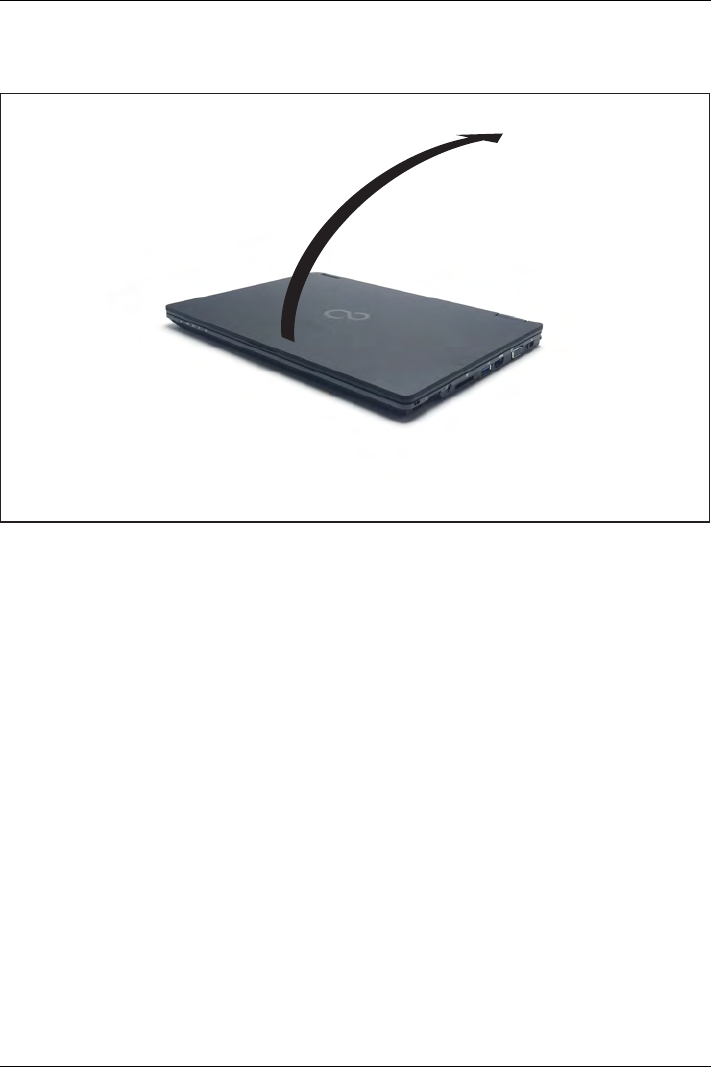
Working with the notebook
Opening the notebook
►Fold the LCD screen upwards.
Fujitsu 25
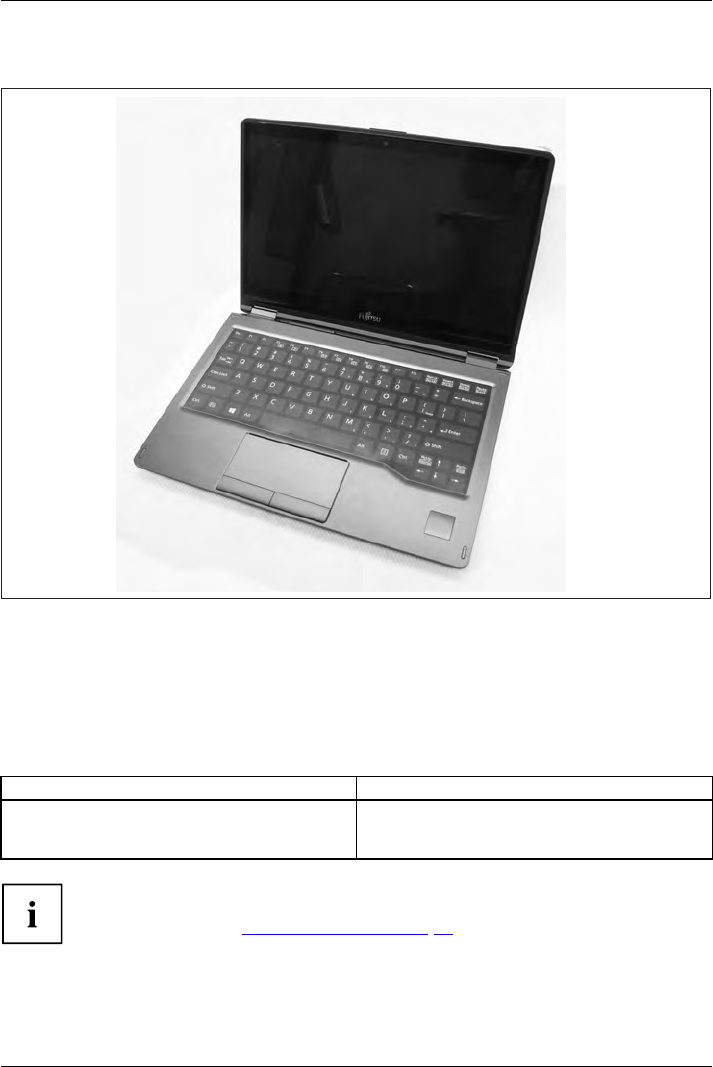
Working with the notebook
Switching the notebook on
Notebook:sw itchingonPower-onindicator
►Slide the ON/OFF switch (1) to the right to switch on the notebook.
The ON/OFF switch returns automatically to its original position.
The power-on indicator lights up.
Programming the ON/OFF button
You can program the ON/OFF button:
Operating system Menu
Windows 10 Windows 10 Start - Control Panel - (Search Control
Panel -) Power Options -Change what the power
buttons do
If you have assigned a password, you must enter this when requested to
do so, in order to start the operating system. Detailed information can be
found in the chapter "Security functions", Page 67.
26 Fujitsu
1
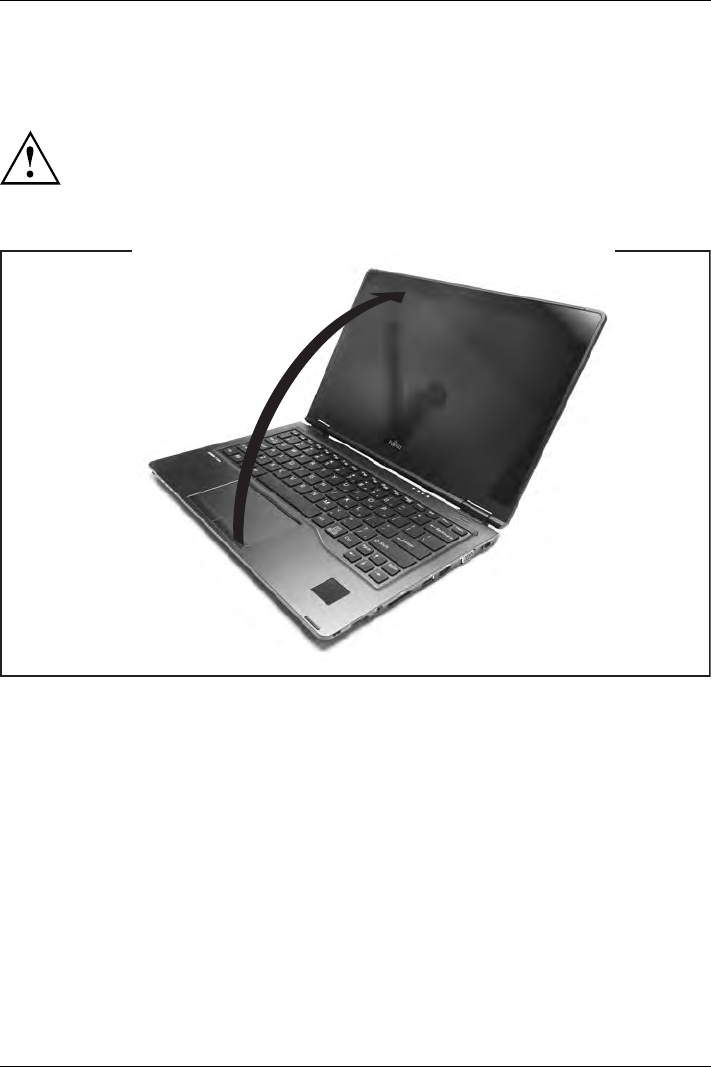
Working with the notebook
Different ways to use your notebook
During your daily work, you can use your notebook as a Tablet PC or as a notebook, just as you wish.
Note the direction of rotation in the following description! No guarantee claims
can be met for damage caused by turning in the wrong direction.
You must note that the screen cannot be turned completely on its own axis!
From notebook to Tablet PC
►Raise the LCD screen into a vertical position.
Fujitsu 27
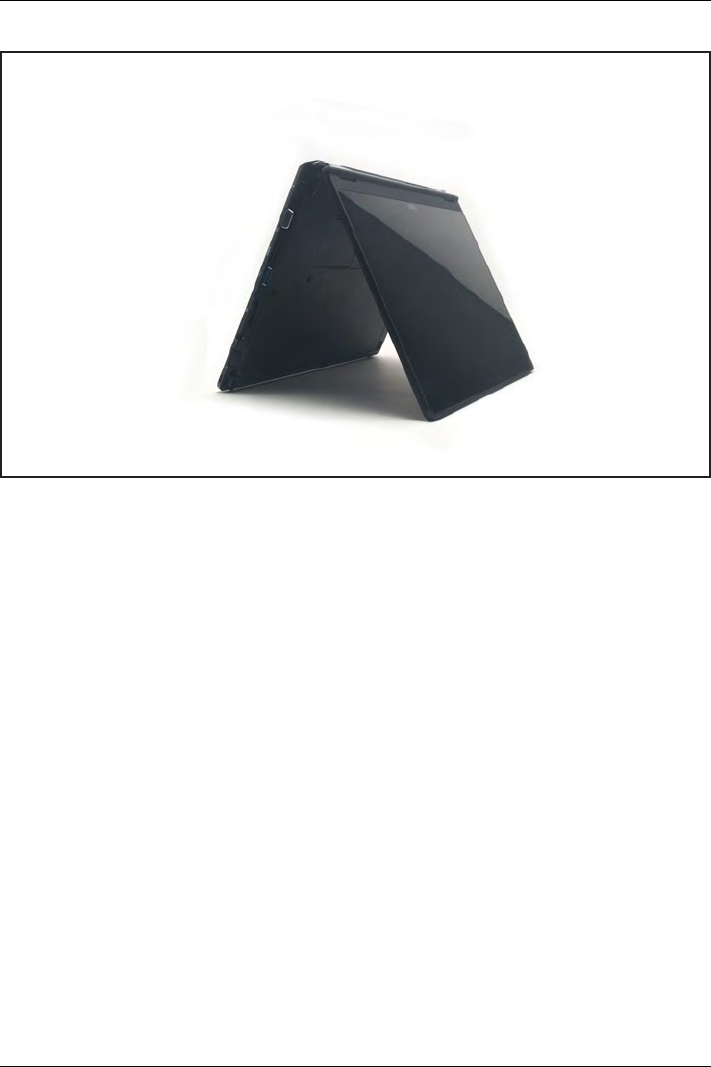
Working with the notebook
►Open the screen and carefully fold it all the way backwards until it touches
the back of the computer. You are now in tablet mode.
28 Fujitsu
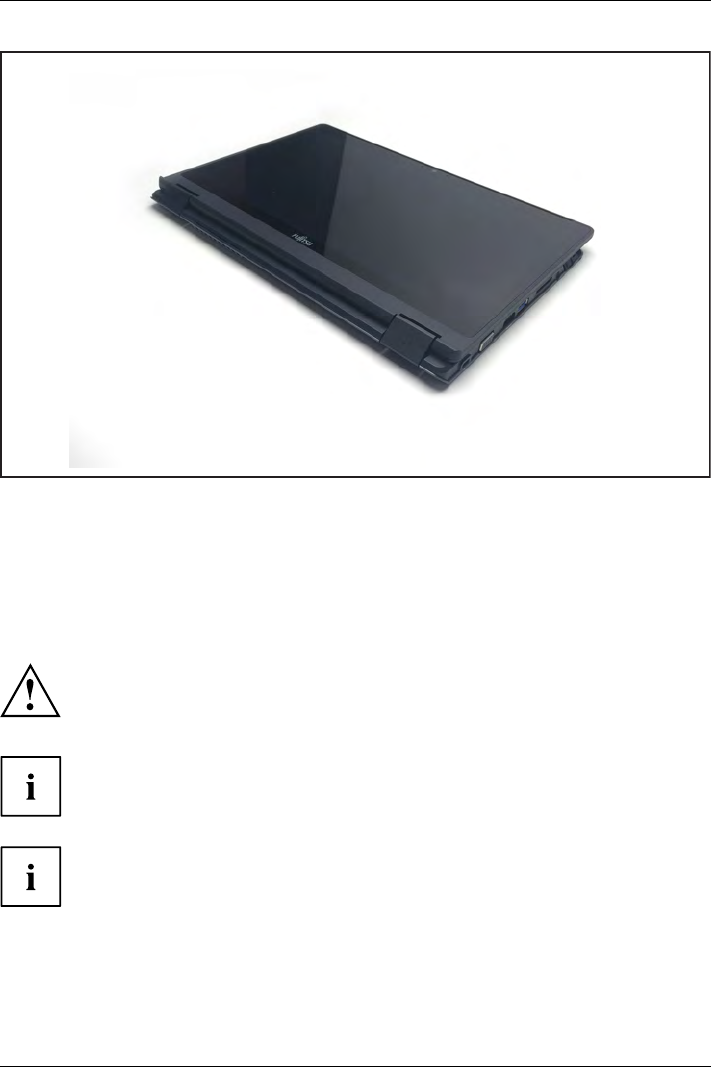
Working with the notebook
►Now fold the screen down until the back of the screen is almost flat on top of the keyboard.
The screen is now secured in the tablet position.
Select display orientation (portrait or landscape format)
Landscapeformat
Portraitformat
Displayorientation
You can choose to use either portrait or landscape for the display, or whether the screen
orientation should automatically adjust to the orientation of the tablet PC.
If you have a device with installed wireless WAN module, do not operate WWAN with
the antenna folded out when holding the device horizontally with the camera pointing
downwards (in the tablet position in landscape format (rotated) (secondary landscape)).
Operating the device in that position can result in damage to the antenna.
You can change these settings under Control Panel - Hardware and Sound
- Windows Mobility Center / Rotate screen.
In the settings there are profiles saved for operation with different screen orientations.
These profiles have preset standard configurations that can be modified as desired.
These settings do not just affect the screen settings on the Tablet PC, but
also on external monitors that are connected.
Fujitsu 29
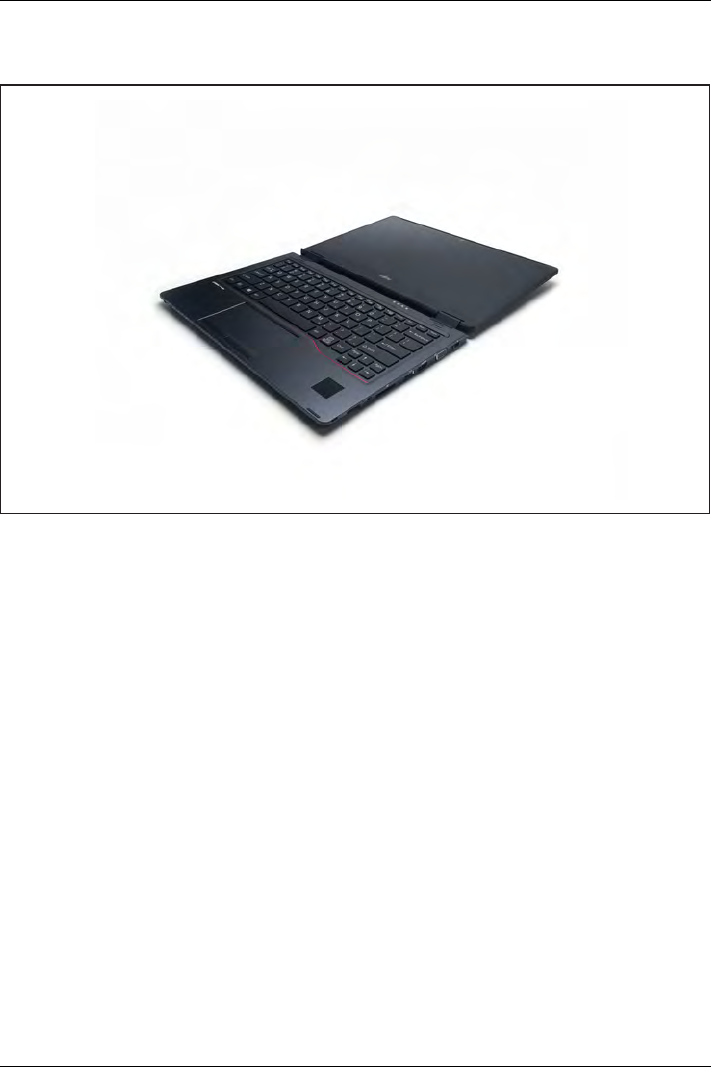
Working with the notebook
From Tablet PC to notebook
►Move the LCD screen until it is flat with the keyboard
30 Fujitsu
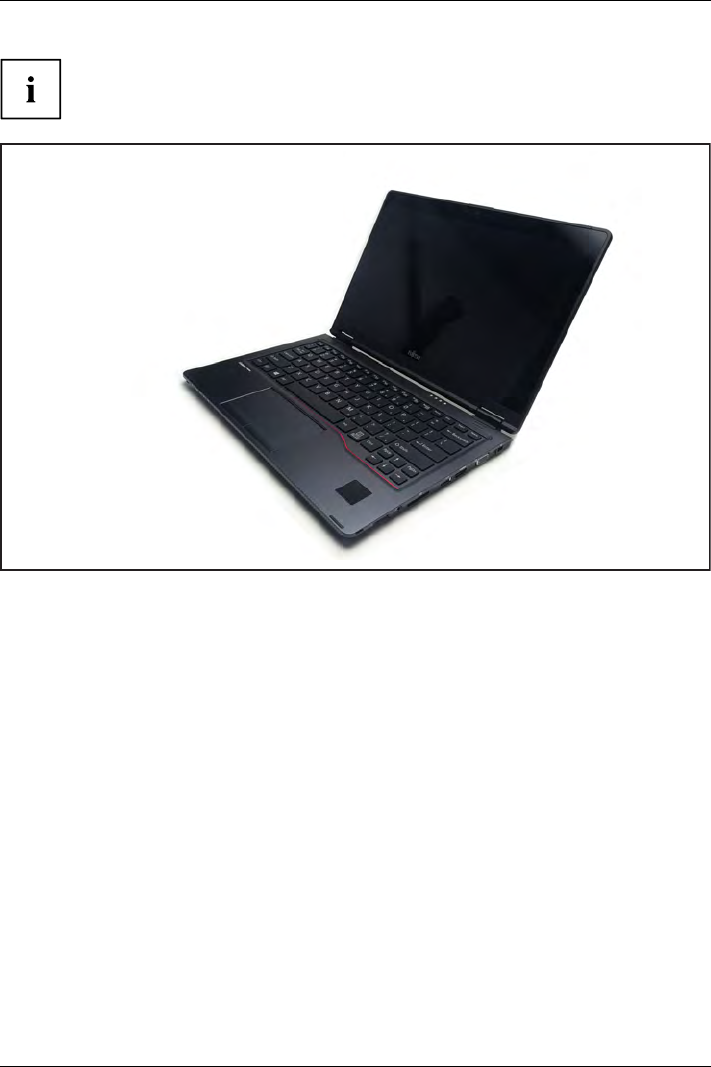
Working with the notebook
When folding the LCD screen ensure even pressure is applied to both hinges as
to not torque the screen and put undue pressure on one of the hinges.
►Hold the screen as near to the bottom as possible on both sides.
►Position the screen to a comfortable position.
Switching off the notebook
Notebook
►Close all applications and then shut down your operating system (please
refer to the "Operating system manual").
Fujitsu 31
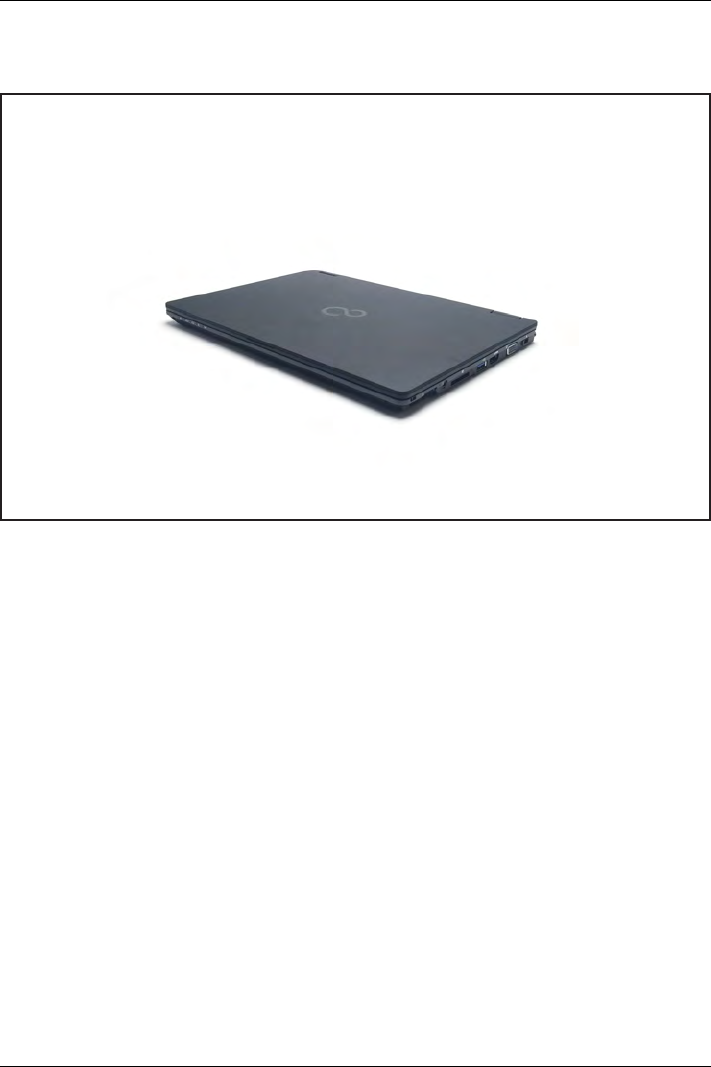
Working with the notebook
Closing the notebook
►Fold the LCD screen onto the bottom part of the notebook so that it locks into place.
Handwriting recognition
For detailed information on handwriting recognition, see the documentation for your operating system.
At present, handwriting recognition on Windows supports the following languages:
English, German, French, Italian, Japanese, Korean, Chinese (traditional and simplified), Dutch,
Portuguese, Spanish, Brazilian, Norwegian (Bokmål and Nynorsk), Swedish, Finnish, Danish,
Polish, Rumanian, Serbian (Cyrillic and Latin script), Catalan, Russian, Czech and Croatian.
On Windows you can set the required language under Control Panel – Time,
Language and Region – Language.
32 Fujitsu

Working with the notebook
LCD screen
LCDscreenNotes
Background lighting
LCD screens are operated with background lighting. The luminosity of the background
lighting can decrease during the period of use of the notebook. However, you can
set the brightness of your monitor individually.
Synchronizing the display on the LCD screen and an external monitor
For more information, please refer to Chapter "Key combinations", Page 43
under "Switching between display outputs".
Ambient light sensor
If your notebook was shipped with a Windows operating system, the screen brightness is
regulated by the ambient light sensor and is dependent on the particular light conditions.
This results in optimum readability and longer battery life at the same time.
Using the device as a Tablet PC
You can execute commands as follows:
• using the stylus (supplied with your device).
• using your finger
Using fngers
You can execute certain commands by using your finger tip on the touchscreen of your device.
Alternatively, everything which you can select or activate using your finger
tip can also be selected or activated using the stylus.
Calibrate the Dual Digitizer for fnger-based operation of the device.
To adjust the sensitivity of the screen when using the stylus or your finger:
►Swipe from the right edge of the screen towards the middle and tap Search.
or
►When using a mouse, point to the top right corner on the screen, move the
pointer downwards and then click on Search.
►In the search field, enter Calibrate, and tap or click on Calibrate screen for stylus
or finger input to open the tablet PC settings.
►Make sure that the monitor shown in the Display field corresponds to the
screen that you want to calibrate.
►Tap or click on Calibrate, and then follow the instructions on the screen.
Fujitsu 33
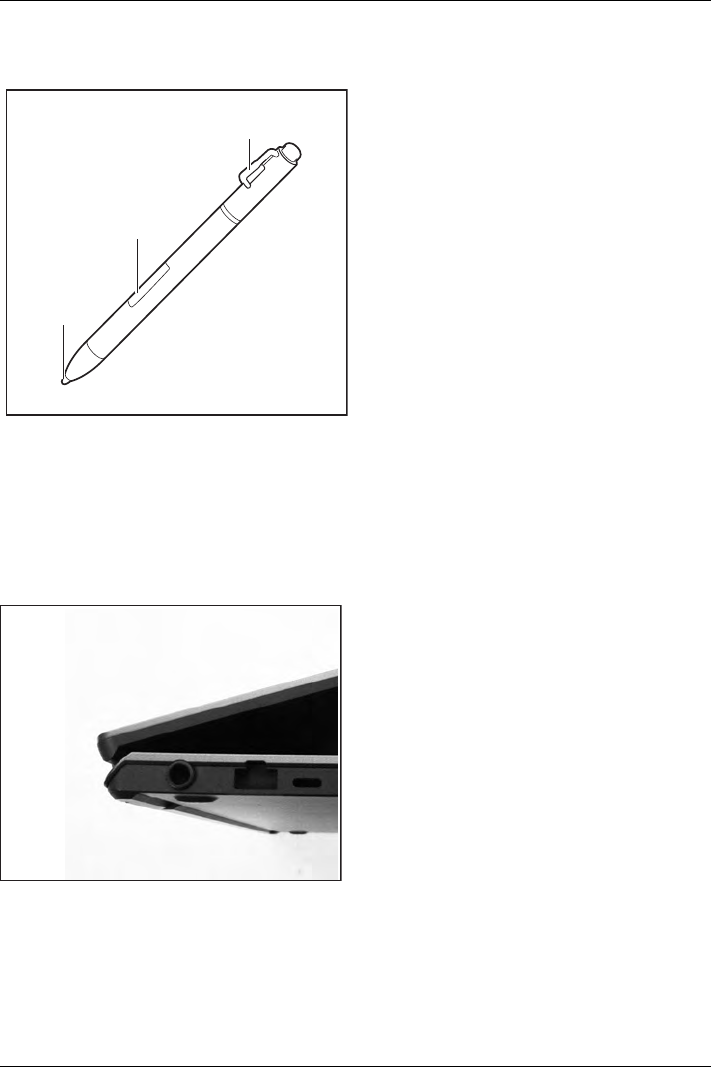
Working with the notebook
Using the stylus (only devices with Dual Digitizer)
3
1
2
1 = stylus tip
2 = stylus button
3 = eyelet for stylus tether
You can use the stylus on your notebook as an electronic writing implement to select
items and to navigate through menu options and programs. Programs that support
handwriting recognition also allow you to write characters directly on the screen with
thepen.Youcanalsousethestylusasadrawingtool.
The notebook stylus is retained securely in its slot. This ensures that the stylus cannot be
lost, regardless of whether you use the notebook as a Tablet PC or as a notebook, or carry it
while traveling. Always replace the stylus in the slot when you are not using it. To remove from
the slot, slide the stylus removal button at the front of the device to the right.
34 Fujitsu
Pen slot

Working with the notebook
Only use the stylus provided with your notebook. Do not use substitute stylus
tips that were not specially designed for your notebook. Replace the stylus tip
if it is worn. The warranty does not cover a scratched screen.
While writing, you should take care that you do not scratch the surface of
the display (e.g. with a wristwatch or bracelet).
The stylus of your notebook is an electronic instrument which can be damaged
if used improperly. Handle the stylus with care.
Our recommendations for proper handling of the stylus are as follows:
• Do not gesture with the stylus.
• Do not use the stylus as a pointer.
• Never use the stylus on any other surface than the screen of your notebook.
• Do not try to turn the grip of the stylus. The grip is used to put the
stylus into its slot or to take it out of its slot.
• Never store the stylus with its weight on the tip (e.g. with the tip down in a pen
container). If the stylus is stored with the tip pointing down, this may have an
adverse effect on the stylus mechanism (particularly at high temperatures). In this
case the stylus tip may react as though it is constantly being pressed down. To
avoid damage, the stylus should be stored in the slot when not in use.
The stylus can be influenced by electromagnetic fields (cursor quivers or
jumps). There may be a few areas on the screen where the cursor quivers
slightly in spite of pressing the stylus down firmly.
The screen responds to entries made with the tip of the finger or the stylus when the
tip of the finger or the stylus directly touches the screen.
You can use the stylus to perform all functions for which you would otherwise use a mouse.
In addition, you can conveniently delete hand-written stylus entries using the pen.
Action Mouse Stylus
Selecting menu
items Click with the left mouse button. Tap on the menu entry with the tip of
the stylus.
Starting programs Double-click with the left mouse
button. Tap on the program symbol twice in
rapid succession using the stylus tip.
Moving
objects/windows Drag with the left mouse button
pressed. Place the stylus tip directly on the
object or window. Keep the stylus tip
held against the screen. Drag the
desired object or window.
Opening a context
menu Click with the right mouse button. Tap the desired item with the stylus
and leave the stylus on the item for
a moment.
Moving the cursor -Place the tip of the stylus directly on
the screen.
Fujitsu 35
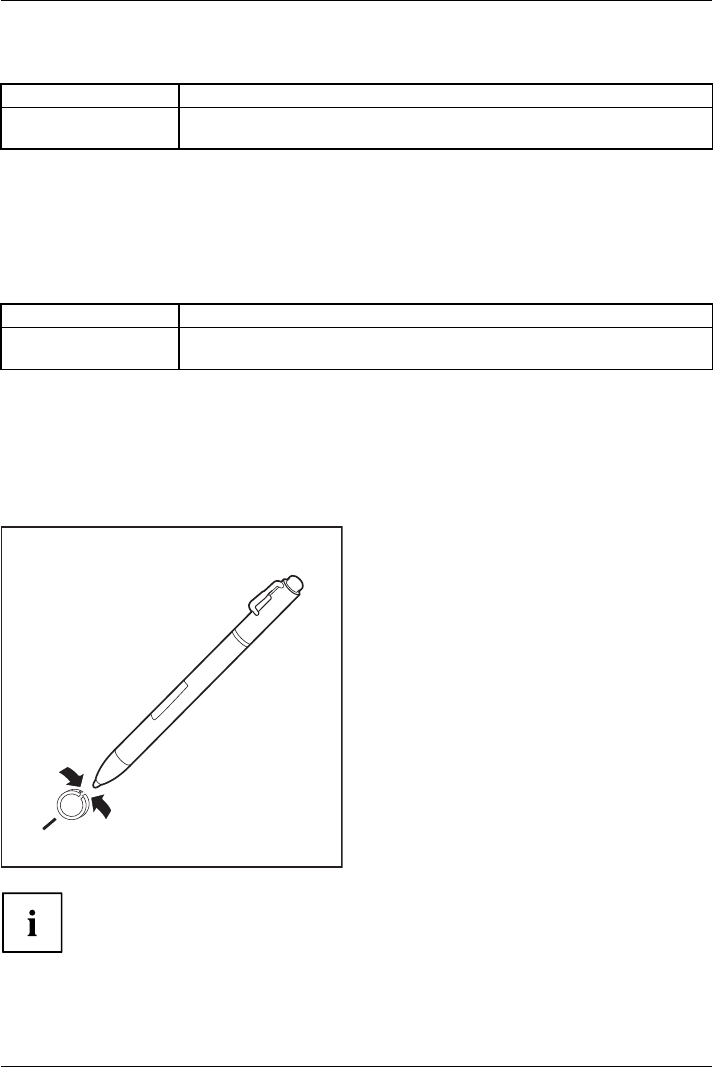
Working with the notebook
Adjusting the stylus
Operating system Menu
Windows 10 Under System Control - Hardware and Sound - Pen and Touch you can make
various settings for the stylus.
Calibrating the stylus
Before first use with the stylus, you must calibrate your Tablet PC via the operating
system, so that it recognizes the stylus as accurately as possible.
You should also always repeat the calibration if the co-ordination between the
stylus and the cursor movement deteriorates.
Operating system Menu
Windows 10 To calibrate, run the Hardware and Sound / Tablet PC Settings function in the
Control Panel. You need to calibrate both portrait and landscape formats.
Replacing the stylus tip
With use, the stylus tip may become worn or may pick up foreign particles that can scratch the screen.
A damaged or worn tip may not move freely, causing unpredictable results when using the stylus.
If your stylus exhibits these problems, you should replace the stylus tip. To
do this, use the supplied tool (1).
1
►To remove the tip, position it in the gap
between the two ends of the tool supplied.
►Pinch the two ends of the supplied tool
together so that the tip is firmly clasped,
then pull it from the barrel.
►Replace the tip with one of the new tips
that were supplied with your stylus. Insert
the flat end of the tip into the barrel
and exerting gentle pressure, push it
in until it is firmly in place.
If the tip is worn or damaged, discard it.
36 Fujitsu

Working with the notebook
Notes:
Fujitsu 37
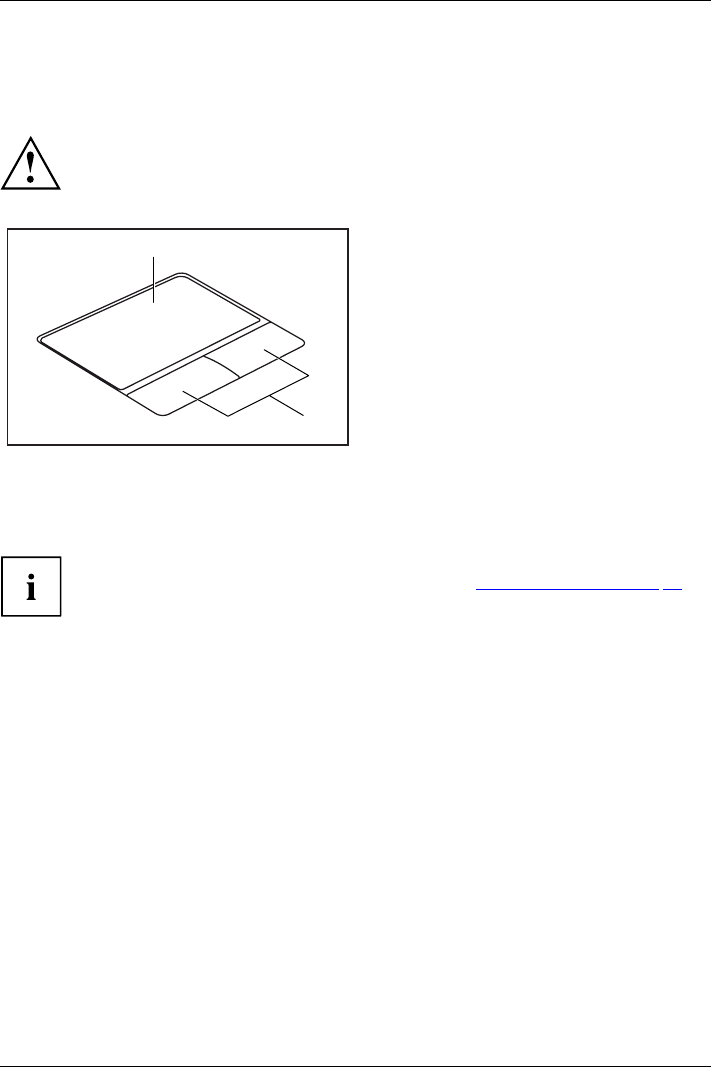
Working with the notebook
Using the device as a notebook
Touchpad and touchpad buttons
Keep the touchpad clean. Protect it from dirt, liquids and grease.
TouchpadTouchpad
Do not use the touchpad if your fingers are dirty.
Do not rest heavy objects (e.g. books) on the touchpad or the touchpad buttons.
1
2
1 = Touchpad
2 = Touchpad buttons
The touchpad enables you to move the mouse pointer on the monitor.
The touchpad buttons allow you to select and execute commands. They correspond
to the buttons on a conventional mouse.
You can also deactivate the touchpad via a key combination, so that you cannot move
the pointer on the monitor unintentionally (see chapter "Key combinations", Page 43).
Moving the pointer
►Move your finger on the touchpad.
Touchpad
The pointer will move.
Selecting anitem
►Move the pointer to the item you wish to select.
Touchpad
►Tap the touchpad once or press the left button once.
The item is selected.
Executing commands
►Move the pointer to the field you wish to select.
Tou chp ad
►Tap the touchpad twice or press the left button twice.
The command is executed.
38 Fujitsu
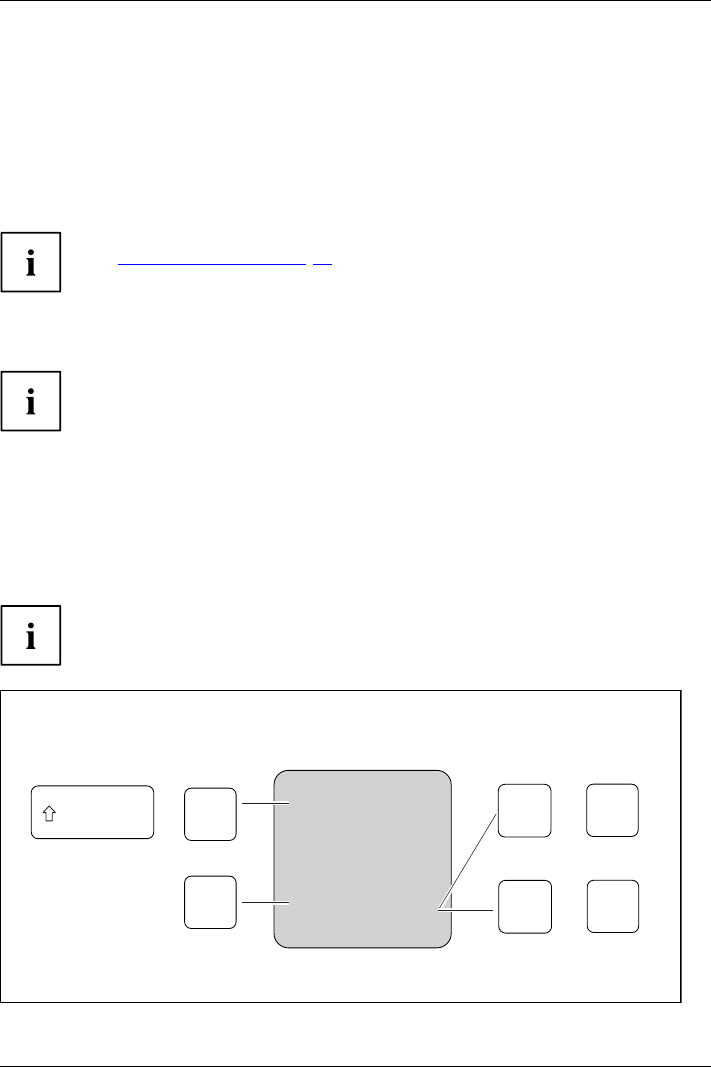
Working with the notebook
Dragging items
►Select the desired item.
Touchpad
►Press and hold the left button and drag the item to the desired position
with the finger on the touchpad.
The item will be moved.
Switching the Touchpad on and off
You can switch the Touchpad on and off using a key combination,
see "Key combinations", Page 43.
Keyboard
KeyboardNumerickey padNumberke ypadkeys
The keyboard of your notebook is subject to continuous wear through normal
use. The key markings are especially prone to wear. The key markings are
liable to wear away over the life of the notebook.
The keyboard has been designed to provide all the functions of an enhanced keyboard.
Some enhanced keyboard functions are mapped with key combinations.
The following description of the keys applies to the Windows operating system. Additional functions
supported by the keys are described in the relevant manuals supplied with your application programs.
The following illustration shows how to access the different characters on keys with overlaid
functions. The example applies when the Caps Lock key has not been activated.
The illustration may differ from your device.
0
=
}
++
Num
Lock
=
0}
=
0}
=
0}
+
Fn =
0}
Fujitsu 39
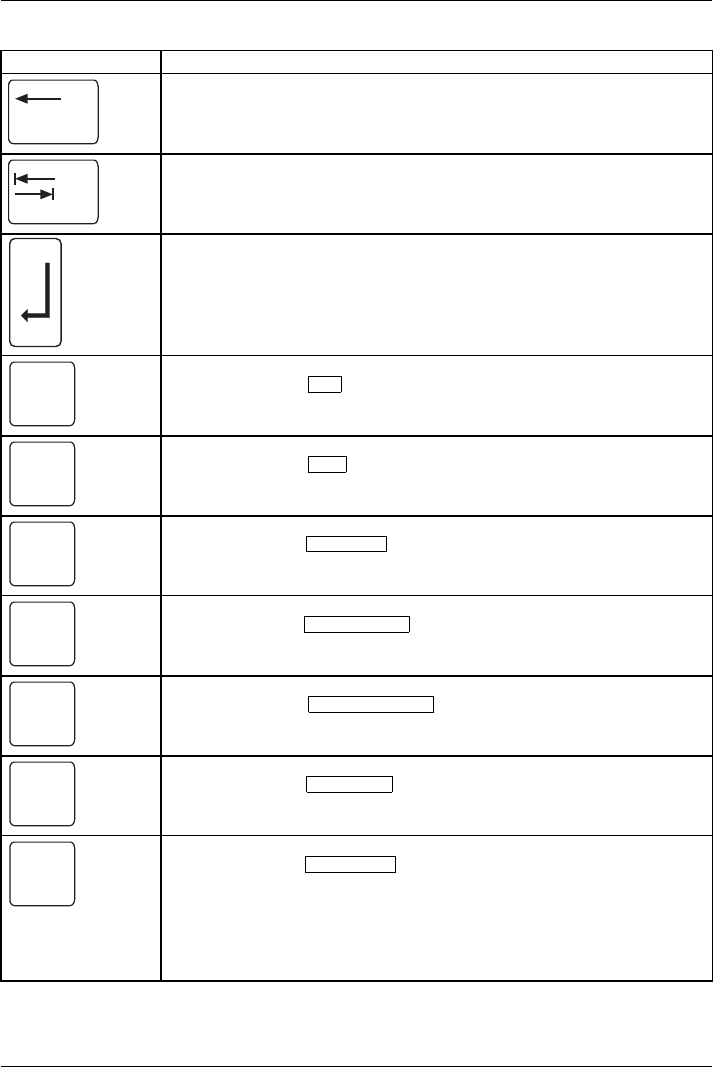
Working with the notebook
Key Description
Backspace key
The Backspace key deletes the character to the left of the cursor.
BackspacekeyBackspace
Tab key
The Tab key moves the cursor to the next tab stop.
Tabkey
Enter key (return)
The Enter key terminates a command line. The command you have entered
is executed when you press this key.
EnterkeyReturnEnterLinefeed
Alt
Alt key
When pressing the Alt key, special functions are activated when it is
pressed in combination with other keys.
Ctrl
Ctrl key
When pressing the Ctrl key, special functions are activated when it is
pressed in combination with other keys.
Num
Lock
Num Lock key
When pressing the Num Lock key, the virtual numeric keypad is activated.
Those characters are issued, which are located at the top right corner of
the respective keys.
Pause
Break
Pause | Break key
When pressing the Pause | Break key, the screen display in BIOS is paused
until another key is pressed (e.g. at system startup).
Prt Scr
Sys Rq
Prt Scrn | Sys Rq key
When pressing the Prt Scrn | Sys Rq key, a screenshot of the current
screen image is created and stored in the clipboard.
Scroll
Lock
Scroll Lock key
When pressing the Scroll Lock key, special functions are activated, which
differ from application to application.
Insert
Insert key
When pressing the Scroll Insert key, you change between two input modes:
1. Typeover mode: when typing, you overwrite the character at the current
cursor position.
2. Insert mode: while typing, another character at the current cursor
position is inserted, all characters right of the cursor will be shifted by
one position.
40 Fujitsu
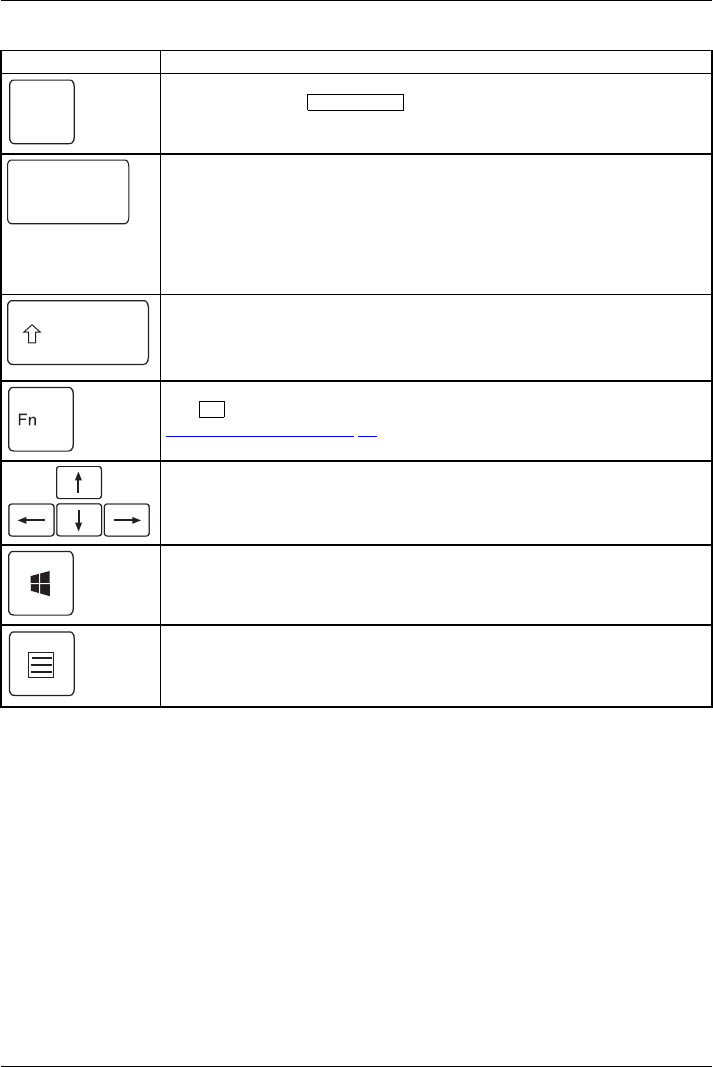
Working with the notebook
Key Description
Delete
Delete key
When pressing the Scroll Delete key, the character before the / right of
the cursor will be deleted.
Caps Lock Caps Lock key
The Caps Lock key activates the Caps Lock mode, and the corresponding
icon is displayed in the Windows information area. In Caps Lock mode, all
of the characters you type appear in upper case. In the case of overlay
keys, the character printed on the upper left of the key will appear when
that key is pressed. To cancel the Caps Lock function, simply press the
Caps Lock key again.
CapsLockkeyCapsLock
Shift
Shift key
The Shift key causes uppercase characters to appear. In the case of overlay
keys, the character printed on the upper left of the key will appear when
thatkeyispressed.
ShiftkeyShift
Fn key
The Fn key enables the special functions indicated on overlay keys (see
"Key combinations", Page 43).
Fnkey
Cursor keys
The cursor keys move the cursor in the direction of the arrow, i.e. up, down,
left, or right.
CursorkeysCursorcontrol
Windows key
The Windows key switches between the start screen and the last used
application.
Windowskey
Menu key
The Menu key opens the menu for the active application.
Fujitsu 41
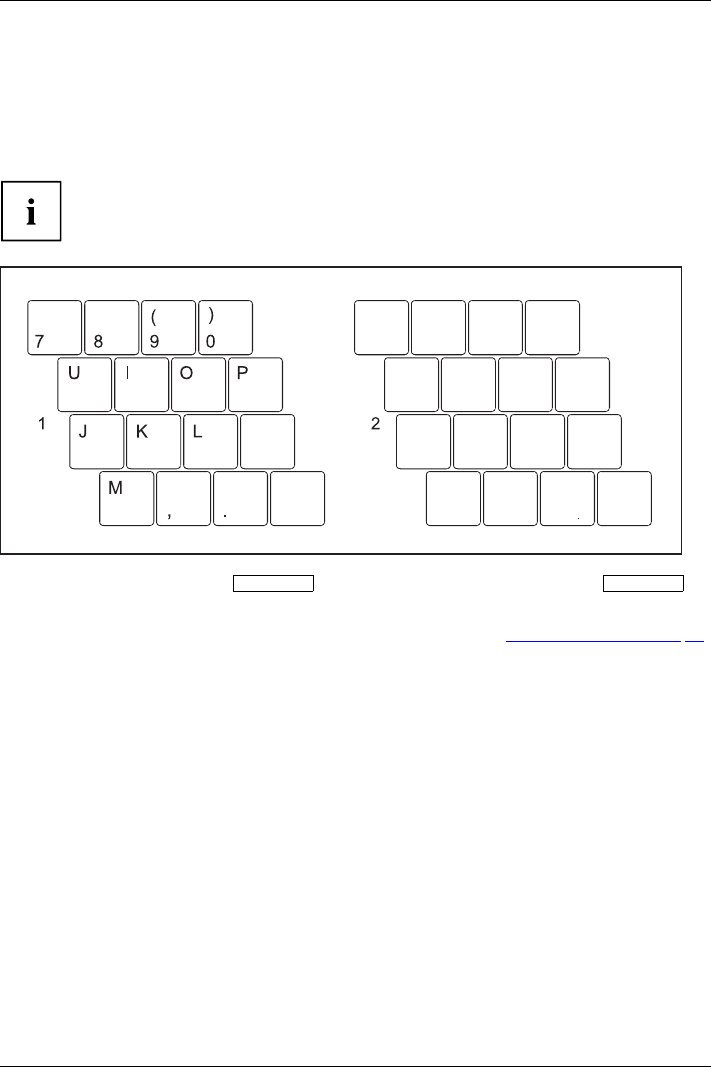
Working with the notebook
Virtual number keys
NumerickeypadVirtualnumbe rkeysNum Lock
Virtual number keys are provided so that the keys of a number keypad can be used for certain
applications. The virtual number keys are recognizable on the keyboard by the numbers and
symbols printed in the upper right corner of each key. If you have switched on the virtual number
keys, you can output the characters shown on the upper right of the keys.
The key assignment shown below may be different from the
keyboard layout of your device.
&*
:
;
<>?
/
789
456
123+
/
1 = Valid characters when the Num Lock
key is not enabled 2 = Valid characters when the Num Lock
key is enabled
Further information about the status indicators can be found in chapter "Status indicators", Page 23.
Country and keyboard settings
►Make the country and keyboard settings as described in the documentation for your operating
system.
42 Fujitsu
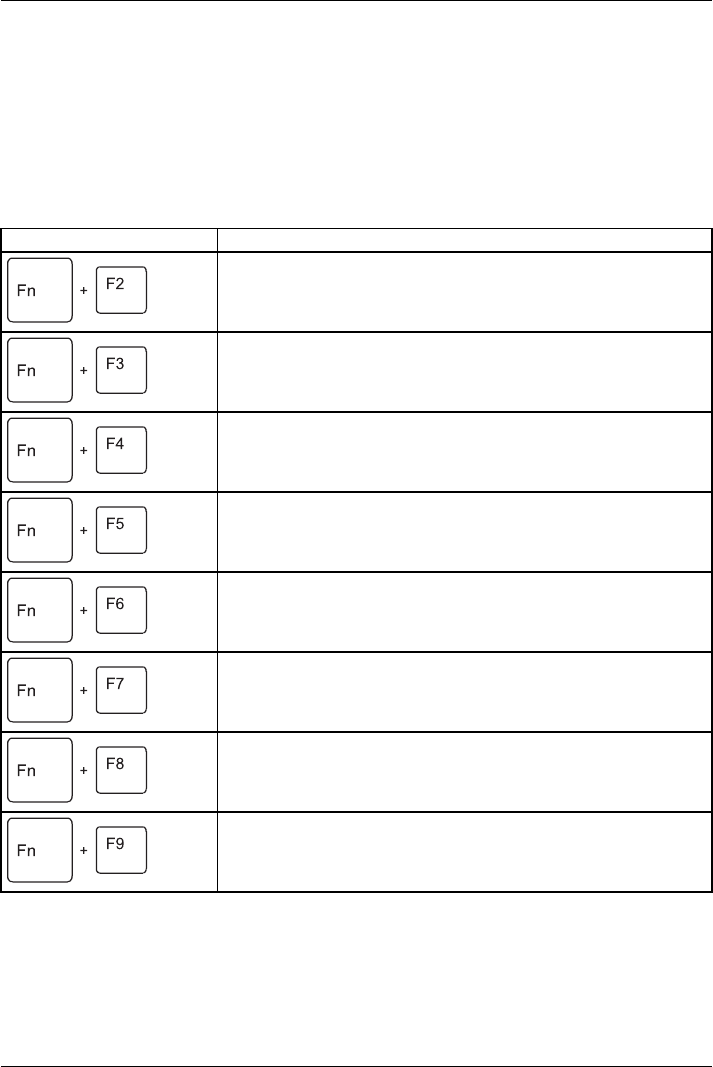
Working with the notebook
Key combinations
The key combinations described below apply when using Microsoft Windows
operating systems. Some of the following key combinations may not function in
other operating systems or with certain device drivers.
Key combinations are entered as follows:
►Press the first key in the combination and keep it pressed.
►While holding the first key down, press the other key or keys in the combination.
Combination Description
Activate/deactivate keyboard backlight
On backlit keyboards, this key combination activates or deactivates
the backlight.
Fn+F2ActivateDeactivate
Switch speaker off/on
This key combination switches your device’s integrated speakers
off and on.
Fn+F3SwitchonSwitchoff
Enable/disable touchpad
This key combination enables and disables the touchpad.
Fn+F4TouchpadTouchpadbuttonTouchpad
Switch the wireless components on / off
This key combination switches the wireless components off or on.
Fn+F5Wirelesscomponents
Decrease the screen brightness
This key combination decreases the brightness of the screen
Fn+F6LCD screenScreen brightness
Increase the screen brightness
This key combination increases the brightness of the screen.
Fn+F7Screen brightness
Decrease the volume
This key combination reduces the volume of the internal speakers.
Fn+F8Vol ume
Increase volume
This key combination increases the volume of the internal speakers.
Fn+F9Vol ume
Fujitsu 43
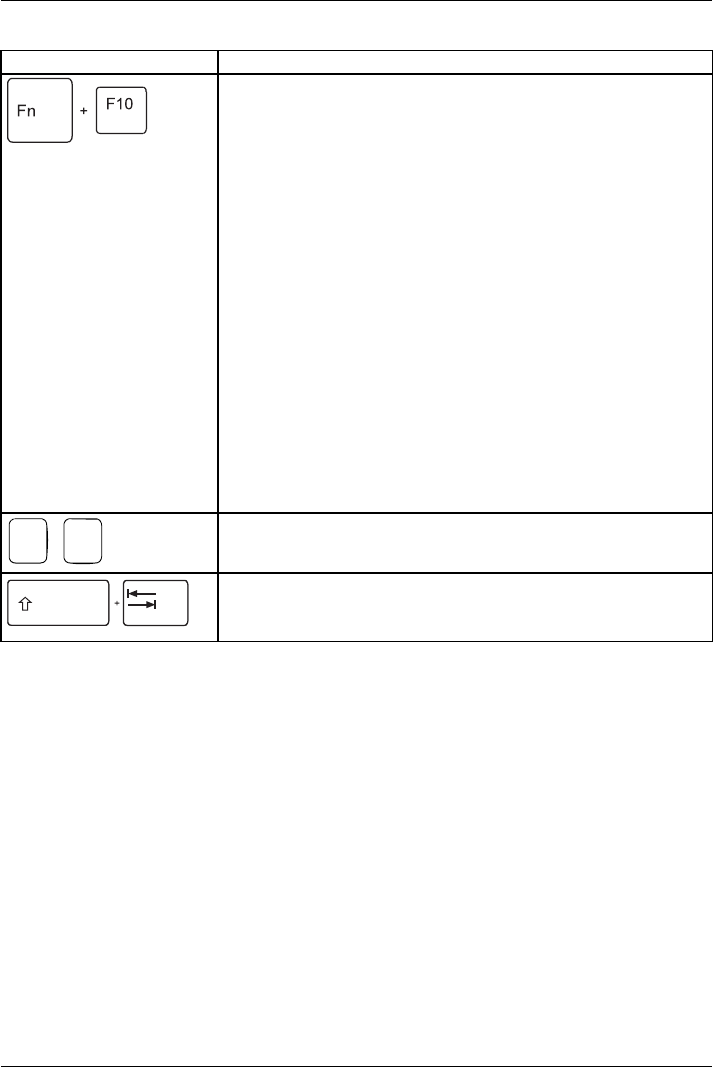
Working with the notebook
Combination Description
Switch between screen outputs
Fn+F10Switchbetweenscreenoutputs
Use this key combination to select which screen(s) is/are used for
display if an external monitor is connected.
Screen output is possible:
• only on the notebook’s LCD screen
• only on the external monitor
• both the LCD screen and the external monitor.
Press the key combination several times to switch through all
possible settings.
It is possible to display video on two screens simultaneously,
regardless of what type and number of external screens are
connected.
If you have connected two external monitors to the port replicator,
the following display outputs are possible:
• only on the notebook’s LCD screen
• just the external monitor (analogue)
• both the LCD screen of the notebook and the external monitor
(analogue)
You cannot switch output to both external monitors on the port
replicator via the key combination.
+
Ctrl CCancel current operation
This key combination can be used to halt an operation instantly
without clearing the keyboard buffer.
Shift
Back tab
This key combination moves the cursor back to the previous tab
stop.
Shift+TabBa cktab
44 Fujitsu
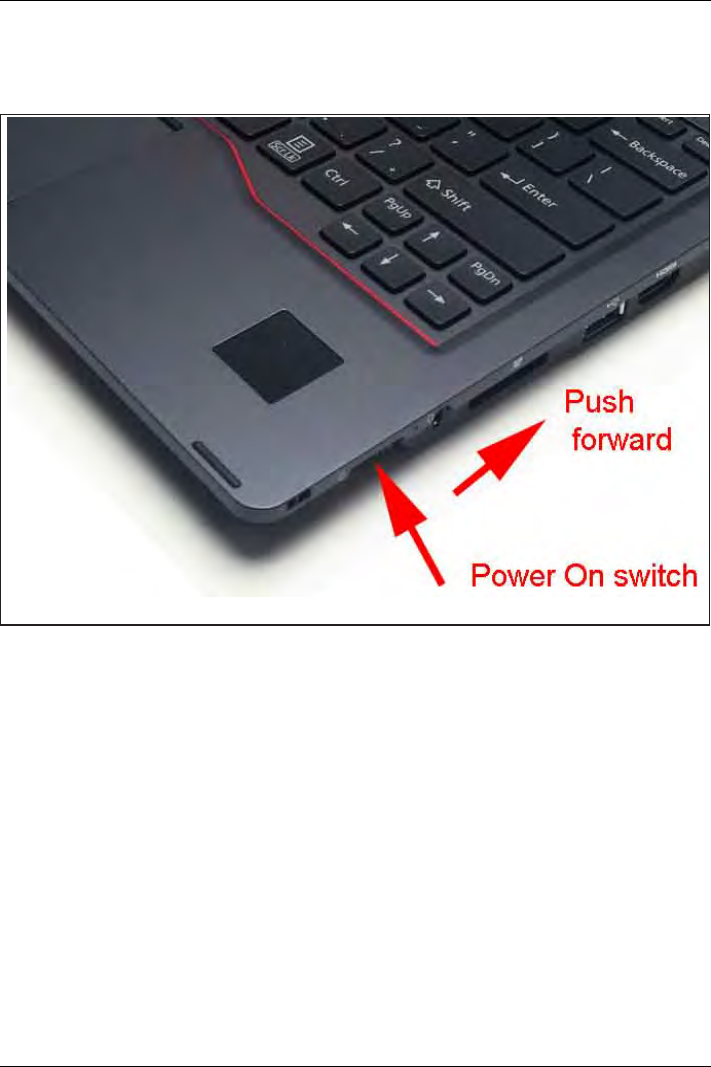
Working with the notebook
Tablet button
Your Tablet PC has a convenient power switch
Fujitsu 45

Working with the notebook
Webcam
Webcam
Depending on the software used, you can use your webcam to take pictures,
record video clips or take part in web chats.
• The picture quality depends on the lighting conditions and the software being used.
• You can only operate the webcam with a particular application (e.g. an Internet telephony
program or a video conferencing program which supports a webcam).
• When using the webcam, the notebook base must not wobble.
• The webcam automatically adjusts itself to the current light level. For this reason
the LCD display may flicker while the light level is adjusted.
Further information on use of the webcam and additional settings for your webcam
can be found in the help function of the program using the webcam.
46 Fujitsu

Working with the notebook
Rechargeable battery
BatteryBatteryServicelife,batteryRechargeablebatteryBattery
During use as a portable, the notebook runs on its built-in battery. You can increase
the service life of the battery by caring for the battery properly. The average battery
service life is around 500 charge/discharge cycles.
You can extend the battery service life by taking advantage of the available energy saving functions.
Charging, caring for and maintaining the battery
BatteryBattery
The notebook battery can only be charged if the ambient temperature is between
5°C / 41°F and a maximum of 35°C / 95°F.
You can charge the battery by connecting the notebook to the AC adapter
(see "Connecting the AC adapter", Page 21).
If the AC adapter is connected, charging will not begin if the battery is at least 90% charged. Once
the battery charge drops below 90%, and the AC adapter is connected, charging will begin.
If the battery is running low you will hear a warning alarm. If you do not connect the AC adapter
within five minutes of the warning alarm described above, your notebook will automatically switch off.
Monitoring the battery state of charge
Batterybatterychargemeter
Windows also has a "Battery charge meter" in the taskbar for monitoring the
battery capacity. When you place the mouse pointer on the battery symbol, the
system displays the state of charge of the battery.
Battery storage
BatteryBatterySelf-discharge,battery
Chargecapacity, batte ry
The battery should be stored in a dry environment at a temperature between 0°C / 32°F and
30°C / 86°F. The lower the storage temperature, the lower the rate of self-discharge.
If you will be storing batteries for a longer period (more than two months),
the battery charge level should be approx. 30%. To prevent exhaustive
discharge which would permanently damage the battery, check the level
of charge of the battery at regular intervals.
To be able to make use of the optimum capacity of the battery, you should allow
the battery to fully discharge and then recharge it.
If you will not use batteries for long periods, remove them from the
notebook. Never store batteries in the device.
Removing and installing the battery
Only use batteries approved by Fujitsu for your notebook.
Never use force when fitting or removing a battery.
Make sure that no foreign bodies get into the battery connections.
Never store a battery for long periods in the discharged state. This
can make it impossible to recharge.
Fujitsu 47
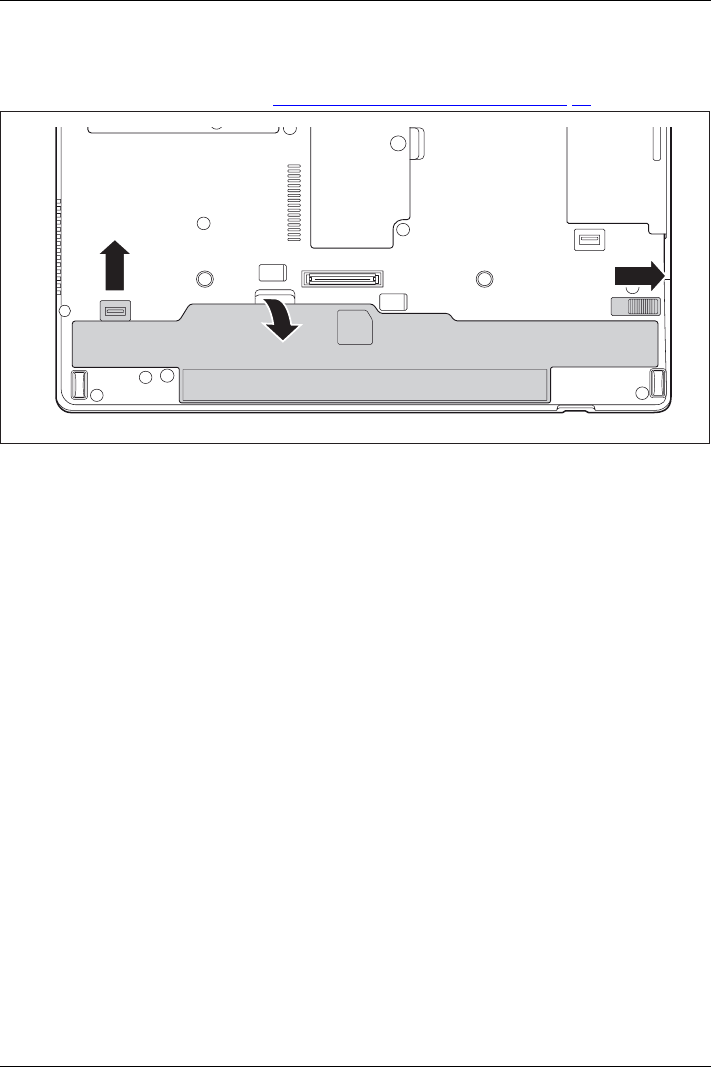
Working with the notebook
Removing a battery
►Prepare for removal, see chapter "Preparing to remove components", Page 82.
2
1
3
►Slide the locking device (1) in the direction of the arrow and hold it in place.
►Slide the locking device (2) in the direction of the arrow.
►Remove the battery from the battery compartment (3).
48 Fujitsu
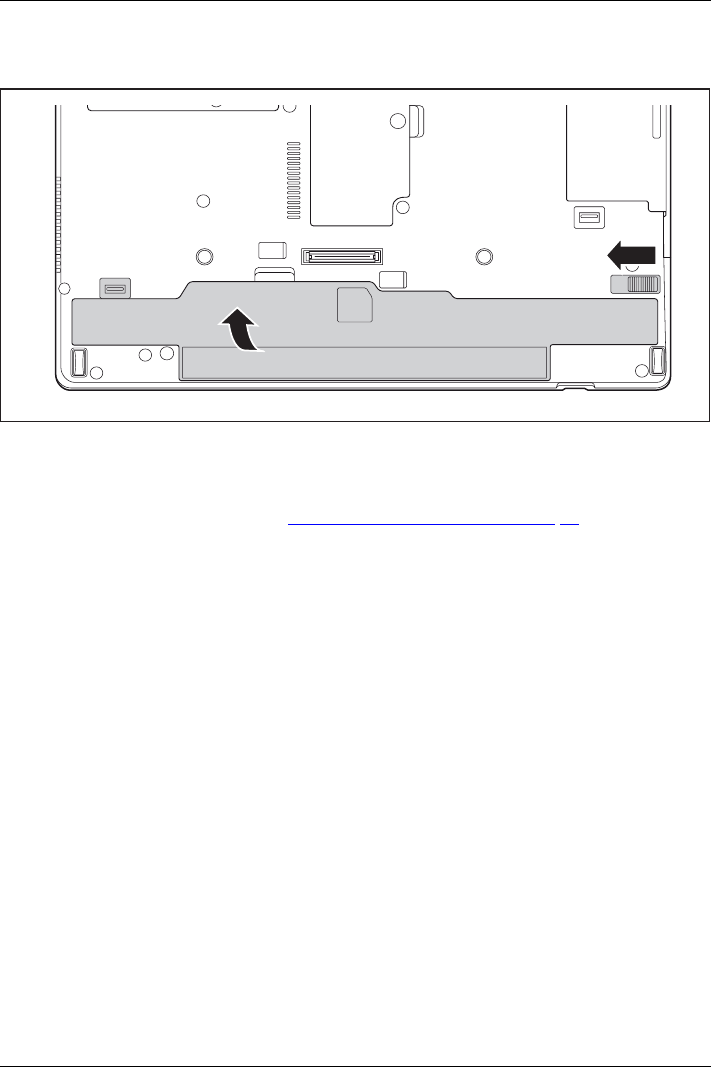
Working with the notebook
Installing a battery
1
2
►Place the battery on the lower edge of the battery compartment.
►Push the battery into the battery compartment until you feel it engage (1).
►Slide the release latch into its locking position (2).
►Complete the removal, see chapter "Finishing component removal", Page 88.
Fujitsu 49
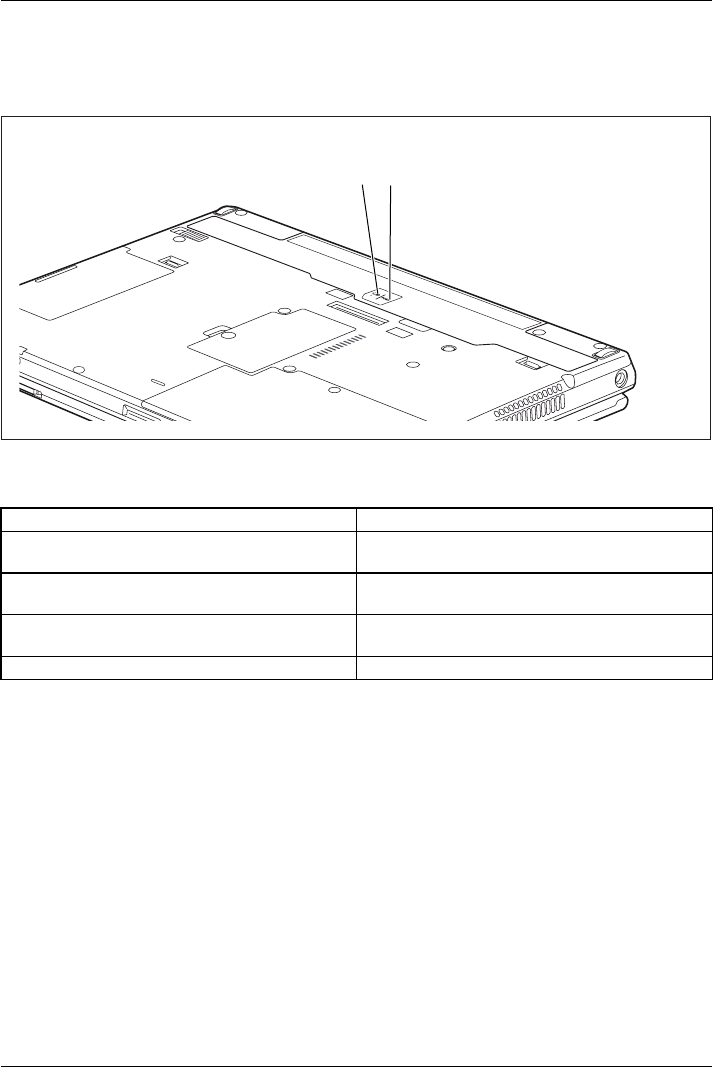
Working with the notebook
Battery charging status indicator
You can check the charging status directly on the battery itself.
11
a
►Press the key (1).
The LED (a) lights up in one of the following colors:
LED indicator charging level
Green The battery is charged somewhere between 50
% and 100 %.
Orange The battery is charged somewhere between 11
% and 49 %.
Red The battery is charged somewhere between 1
% and 10 %.
The LED is not lit The battery is discharged.
50 Fujitsu
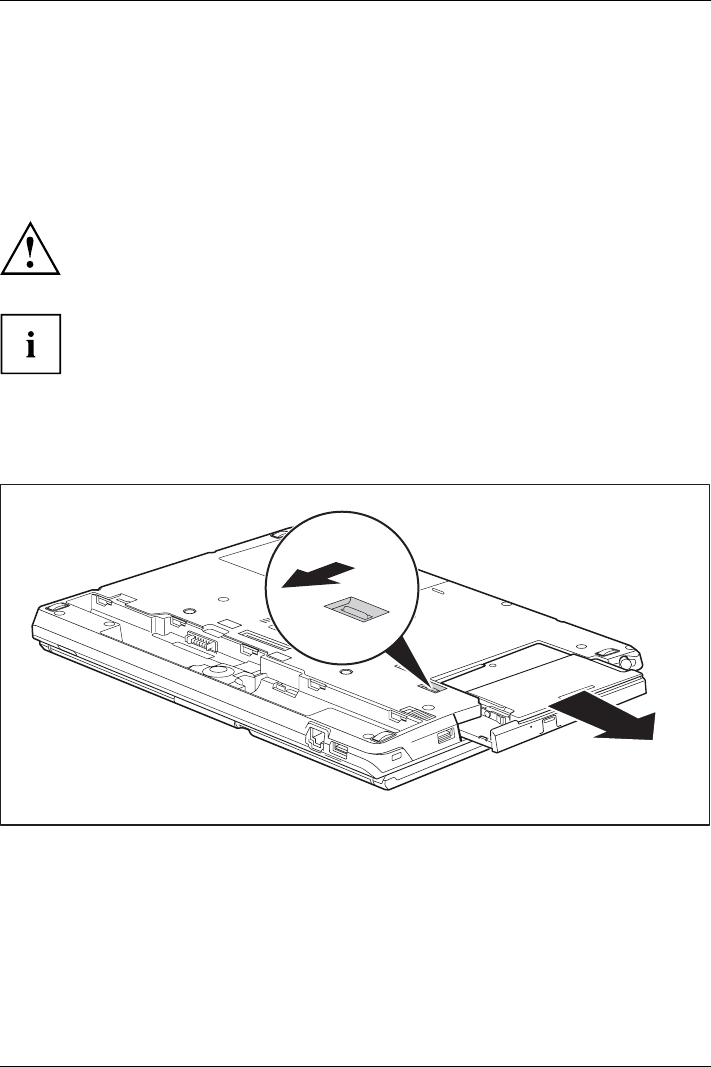
Working with the notebook
Modules
ModularbayModules
The design of your notebook enables the flexible use of notebook batteries and drives. The
following modules can be operated in the modular bay of your notebook:
• Modular bay battery
• Optical drive
• Empty plug-in unit (weight saver)
Only use modules designed for your notebook.
Do not use force when installing or removing the module.
Make sure that no foreign objects enter the modular bay.
You can swap modules during operation. This means you do not
need to switch off the notebook.
To replace a module, simply click on the corresponding icon in the
task bar and then on Exit or
The module can now be removed without any further actions being necessary.
Removing a modular bay device
2
1
Modularbay deviceDriveWei ghtsaver
►Slide the release mechanism (1) in the direction of the arrow and hold.
►Pull the modular bay device (2) out of the modular bay.
Fujitsu 51
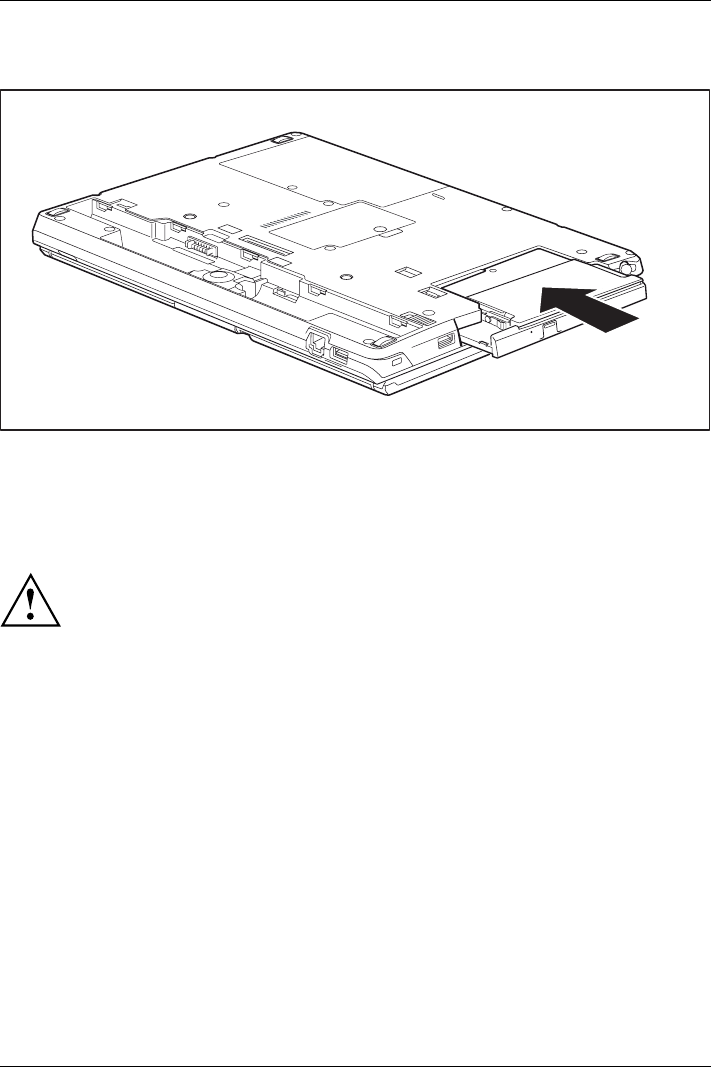
Working with the notebook
Installing a modular bay device
►Place the modular bay device into the modular bay so that the contacts enter first.
►Push the modular bay device into the modular bay until you feel it lock into place.
Optical drive
Opticaldrive
This product contains a light-emitting diode, classified in accordance with IEC
608251:2007: LASER CLASS 1, and therefore must not be opened.
Handling optical disks
Opticaldisks
Observe the following guidelines when handling optical disks:
• Avoid touching the surface of an optical disk. Only hold the optical disk at the edge.
• Always store the optical disk in its case. This will prevent the optical disk from
becoming dusty, scratched or damaged in any other way.
• Protect your optical disk against dust, mechanical vibrations and direct sunlight.
• Do not store an optical disk in areas subject to high temperatures or humidity.
You may use 8 cm / 3.15 inch or 12 cm / 4.7 inch diameter optical disks in the drive.
When using a poor quality optical disk, vibrations and read errors may occur.
52 Fujitsu
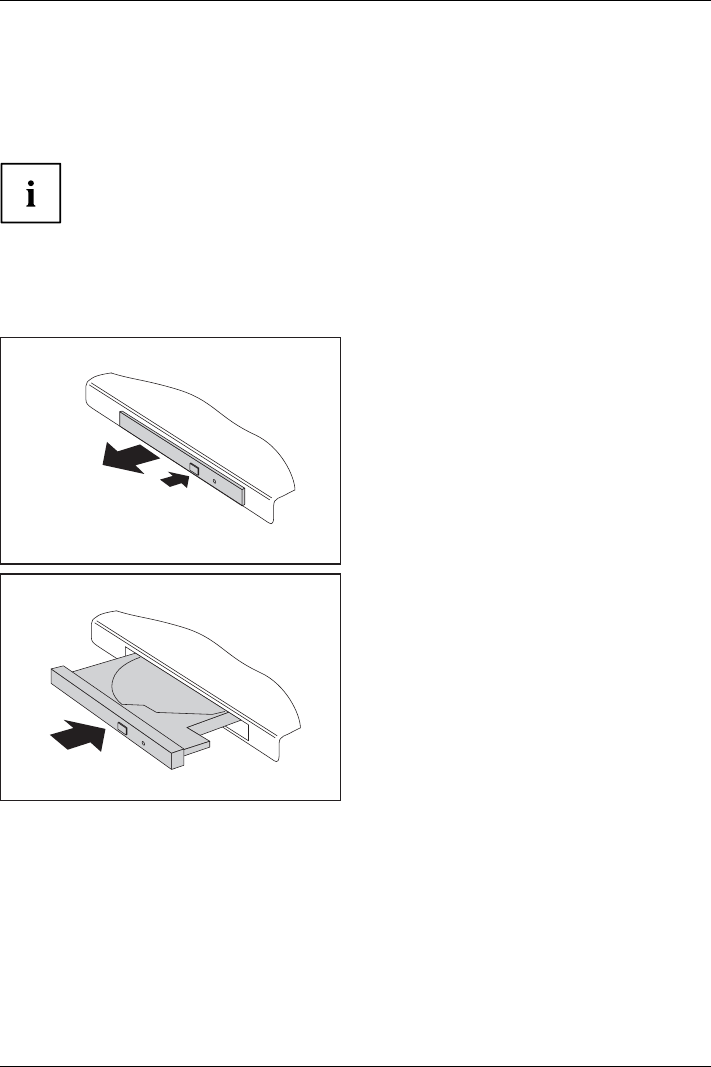
Working with the notebook
CD/DVD indicator
CD/DVDindicator
The CD/DVD indicator flashes when an optical disk is inserted. The indicator goes out when the
drive is ready for reading. The indicator lights up when the drive is being accessed. You must
never remove the optical disk under any circumstances while the indicator is lit.
If the CD/DVD indicator does not go out after inserting an optical disk, but instead
continues to flash, this means that the drive cannot access the optical disk.
Either the optical disk is damaged or dirty or you are using an optical
disk that the drive cannot read.
Inserting or removing an optical disk
OpticaldiskOpticaldisk
The notebook must be switched on.
2
1
►Push the insert/eject button (1).
The drive tray will open.
►Gently pull the drive tray (2) completely out.
►Place the optical disk in the drive tray with
the printed side facing upwards.
or
►Remove an inserted optical disk.
►Push in the drive tray again until
you feel it lock into place.
Fujitsu 53
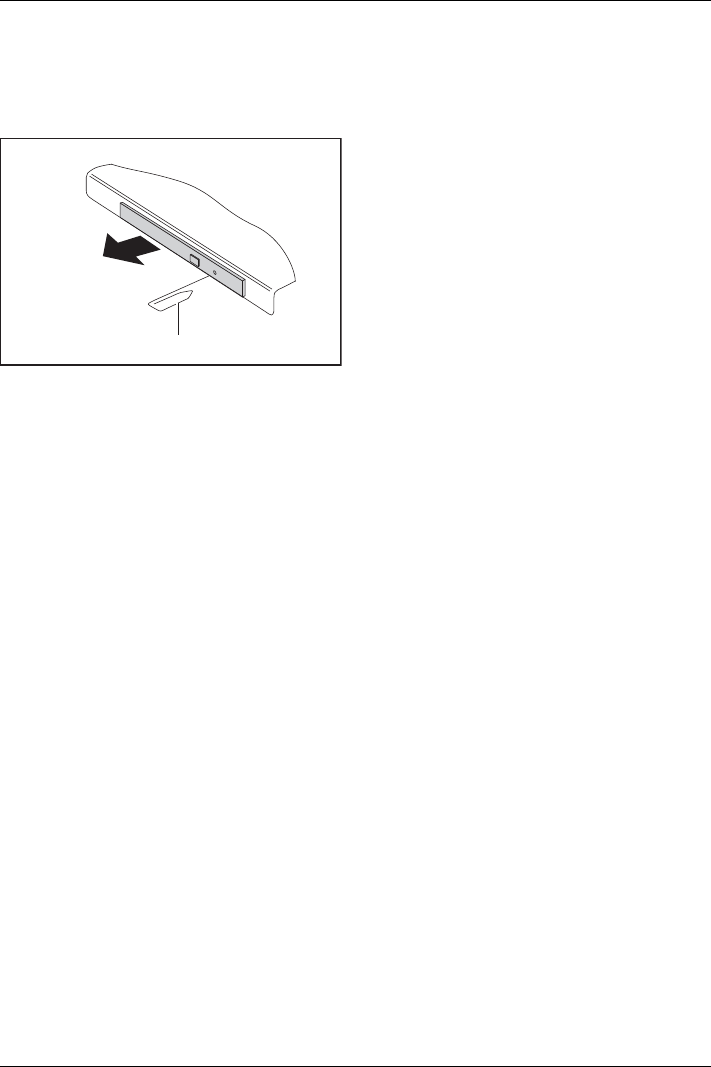
Working with the notebook
Manual removal (emergency removal)
CD/DVDManualremovalofopticaldiskEmergencyrem ovalofoptical disk
In the event of a power failure or damage to the drive, it may be necessary
to manually remove the optical disk.
1
2
►Switch your notebook off.
►Push a pen or a piece of wire (such as a
paper clip) firmly into the opening (1).
The drive tray will be ejected. You can now
pull the drive tray (2) out of the drive.
54 Fujitsu

Working with the notebook
Using the energy saving functions
EnergyEnergyBattery
The notebook uses less power when the available energy-saving functions are used. You will
then be able to work longer when using the battery before having to recharge it.
The energy efficiency is increased and environmental pollution is reduced.
By choosing the best power options, you can make significant savings and
at the same time help protect the environment.
When you fold down and close the LCD screen, depending on the setting in Windows,
the notebook automatically enters a power saving mode.
The recommended settings for the Windows energy saving functions are predefined as "Fujitsu
Computer EcoSettings" in the Power Options of the Control Panel and can be displayed there.
►Set the energy saving functions in your Control Panel.
If you need further information about an option, you can get help with most
settings by pressing F1 to open the Microsoft Help.
When the notebook is in energy saving mode, the following must be remembered:
During energy saving mode, open data is held in main memory or
in a swap file on the hard disk.
Never switch the notebook off while it is in an energy saving mode. If the built-in battery
is nearly flat, close all open files and do not go into energy saving mode.
If you do not intend to use your notebook for a long period of time:
►Exit energy saving mode if necessary by moving the mouse, making an entry at the keyboard
or by switching on the notebook.
►Close all opened programs and completely shut down the notebook.
Fujitsu 55
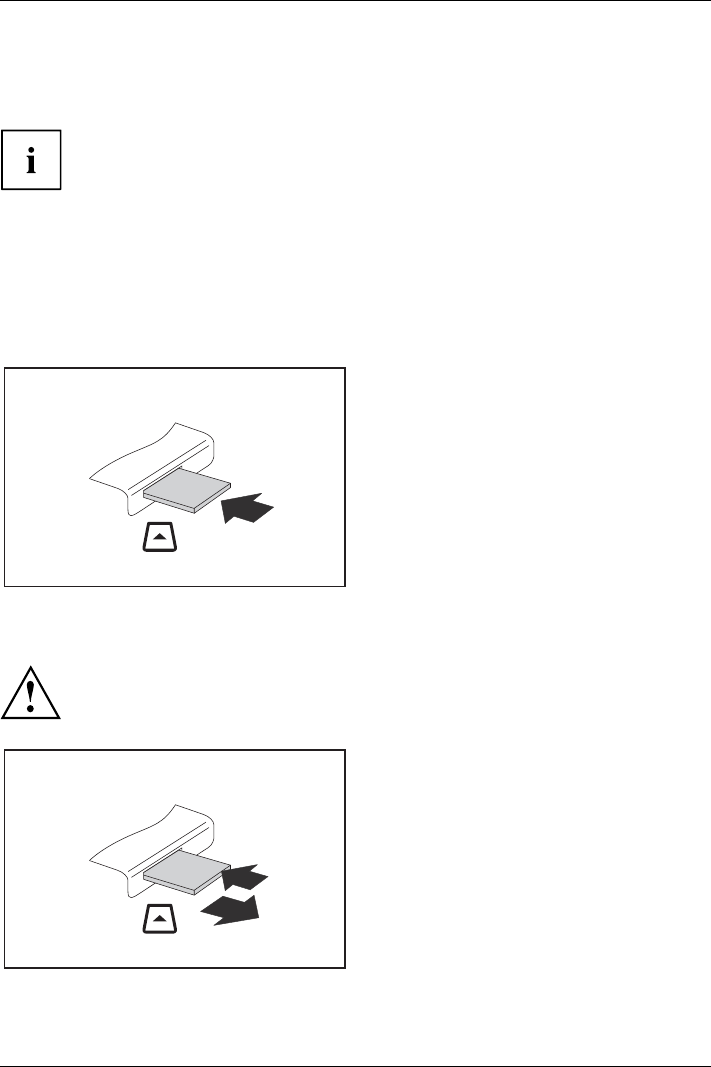
Working with the notebook
Memory cards
Slot
Your notebook is equipped with an integrated memory card reader.
Follow the manufacturer’s instructions when handling the memory cards.
Memorycard
Supported format
The memory card reader supports the following format:
• Secure Digital (SDTM Card)
Inserting the memory card
►Carefully slide the memory card into the
slot. The label should be facing upward. Do
not apply excessive force, as otherwise the
delicate contact surfaces could be damaged.
Memorycard
Depending on the particular type
used, the memory card may protrude
slightly from the slot.
Removing the memory card
Memorycard
To avoid any loss of data, always follow the correct procedure for removing the
card (see the documentation for your operating system).
1
2
►Press on the memory card (1).
Memorycard
The memory card is released and
can now be removed.
►Pull the memory card out of the slot (2).
56 Fujitsu

Working with the notebook
Speaker and microphone
MicrophoneSpeakerVolume con trol
You can find information about the exact position of speakers and microphones
in chapter "Ports and controls", Page 12.
Please refer to chapter "Key combinations", Page 43 for information on setting the volume
and also enabling/disabling the speakers using key combinations.
If you attach an external microphone, the built-in microphone is disabled.
When you connect headphones or external speakers, the built-in speakers are disabled.
You can find information on connecting headphones and a microphone in
chapter "Connecting external devices", Page 75.
Fujitsu 57

Working with the notebook
58 Fujitsu
Notes
SMVopilceuramopkeerchoneontrol

Working with the notebook
Optional wireless LAN/Bluetooth
The installation of radio components not approved by Fujitsu will invalidate
the certifications issued for this device.
Depending on the device configuration you ordered, your device will be
equipped with wireless LAN or Bluetooth.
Switching the wireless components on and off
►Press the key combination Fn +F5 to switch the wireless components on and off.
WirelessLANWirelessLANBluetoothBl uetooth
The wireless component indicator will illuminate when one or more wireless
components are switched on.
The Bluetooth modules and the wireless LAN transmission unit (antenna) will all
be switched off when you switch off the wireless components.
Pay attention to the additional safety notes for devices with wireless components
provided in the "Safety/Regulations" manual.
Details on using a wireless LAN can be found in the online help system
included in the wireless LAN software.
Fujitsu 59

Working with the notebook
Confguring WLAN access
• Requirement: A WLAN is available and you have the necessary access data to hand.
Informationonconfiguring WLAN access can be found in the
documentation for your operating system.
Further information on WLAN and Bluetooth
For further information about WLAN or Bluetooth, please refer to the
appendix of this Operating Manual.
For WLAN specifications, see chapter "WLAN specifications", Page 102.
60 Fujitsu

Working with the notebook
Notes:
Fujitsu 61
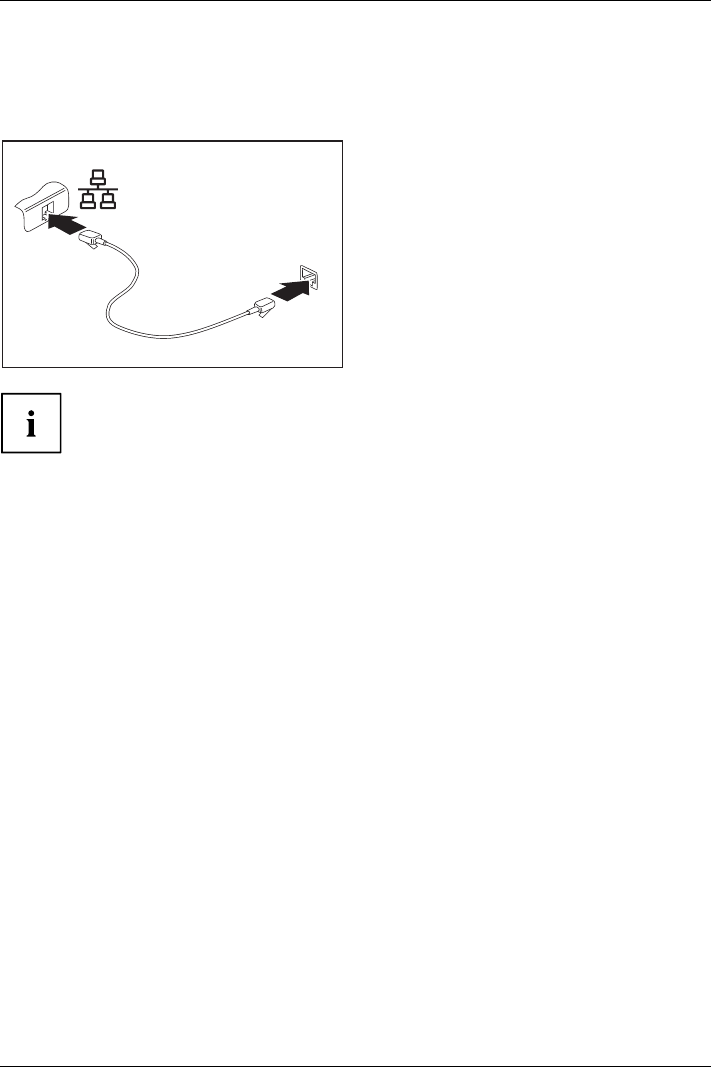
Working with the notebook
Ethernet and LAN
EthernetLAN
The internal network module of your notebook supports Ethernet LAN. You can use it to
establish a connection to a local network (LAN = Local Area Network).
2
1
►Connect the network cable to the LAN
port of the notebook (1).
►Connect the network cable to your
network connection (2).
Your network administrator can help you to configure and use the LAN connections.
The network cable is not included in the delivery scope. This type of
cable can be obtained from a specialist dealer.
62 Fujitsu

Working with the notebook
Notes:
PPoorrttrseplicator
Fujitsu 63

Working with the notebook
64 Fujitsu
More notes:
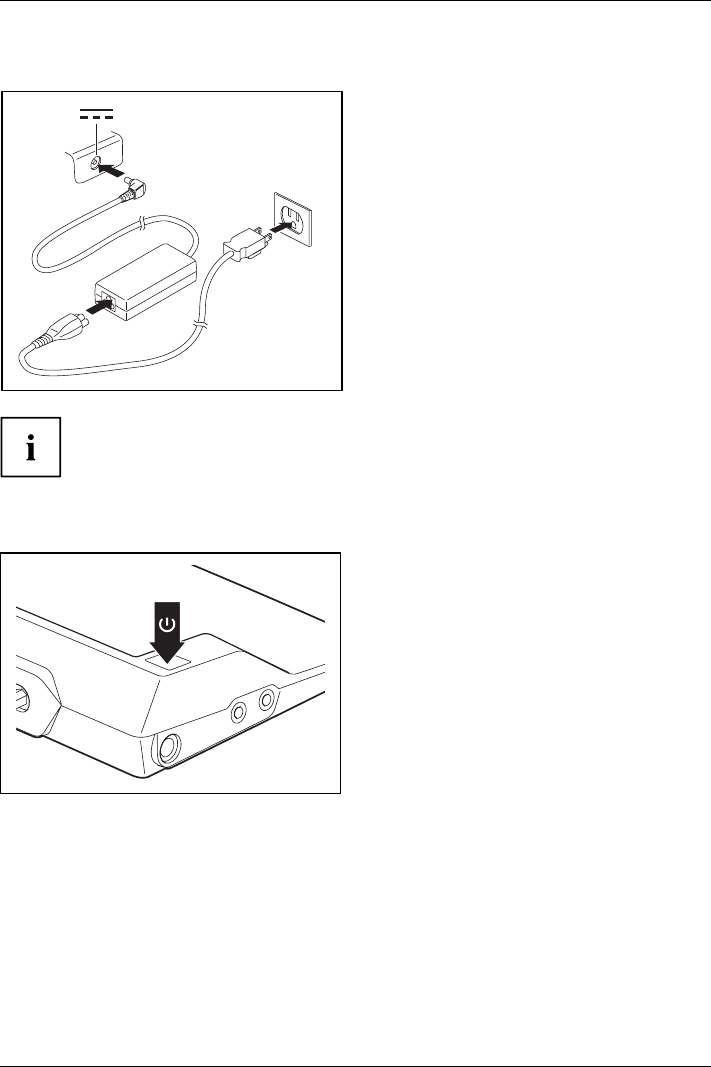
Working with the notebook
Connecting the AC adapter to the port replicator
3
1
2
►Connect the AC cable to the AC adapter (1).
►Plug the AC cable into the power outlet (2).
►Connect the AC adapter cable to the DC
jack (DC IN) of the port replicator (3).
When the notebook is connected to a port replicator, the operating system creates
a hardware profile for the "Docked" mode. In this profile, for example, the monitor
which was last used for output is saved as a setting. This profile will be loaded as
soon as the notebook is connected to a port replicator of the same type.
Switching on the notebook via the port replicator
►Press the ON/OFF button on the port
replicator to switch on the notebook.
The power-on indicator of the port
replicator lights up.
Fujitsu 65
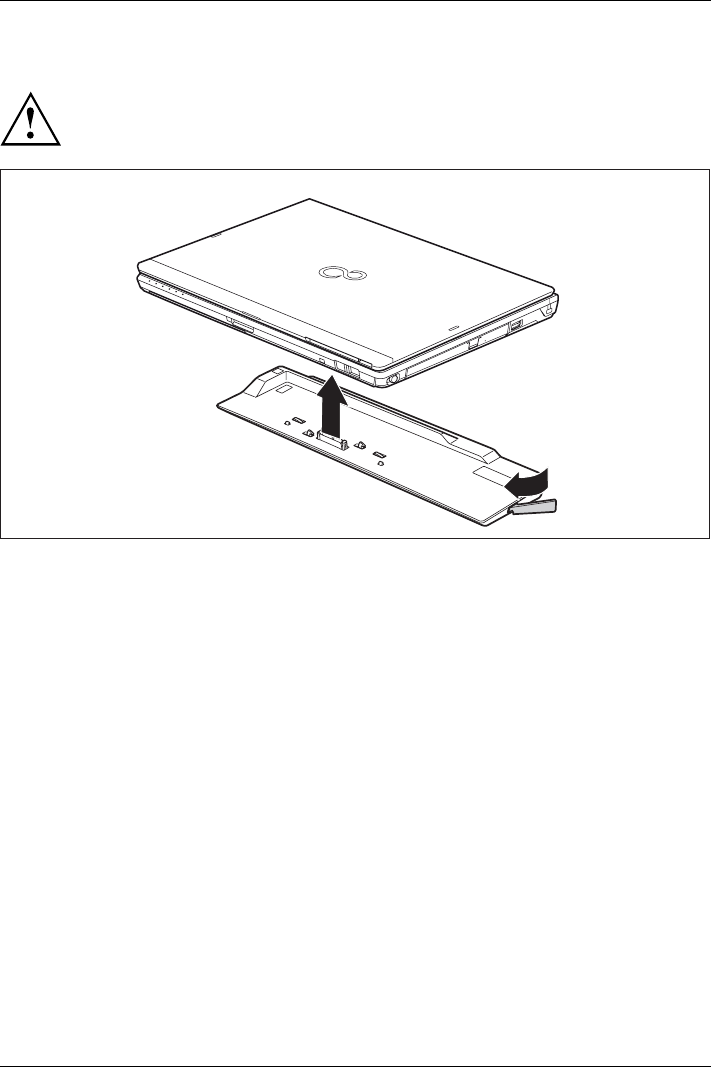
Working with the notebook
Disconnecting the notebook from the port replicator
Problems may occur if the notebook is removed from the port replicator during
operation. We recommend that the notebook is switched off or that the appropriate
undocking function provided by the operating system is executed.
2
1
►Pull the unlocking lever in the direction of the arrow (1), until you hear the notebook unlatch.
►Lift off the notebook (2).
66 Fujitsu

Security functions
Security functions
Securityfunctions
Your notebook has a variety of security functions that you can use to protect your
system and your personal data from unauthorized access.
This chapter explains how to use these functions, and what the benefits are.
Please remember that in some cases, for example, forgetting your password,
you may be locked out of the system and unable to access your data.
Therefore, please note the following information:
• Make regular backups to external optical disks such as external hard
drives, CDs, DVDs or Blu-ray Discs.
• Some security functions need you to choose passwords. Make a note
of the passwords and keeptheminasafeplace.
If you forget your passwords you will need to contact our Service Desk.
Deletion or resetting of passwords are not covered by your warranty
and a charge will be made for assistance.
Fujitsu 67

Security functions
Brief overview of the security functions
Detailed information about the security equipment of your system can be found
in the "Professional Notebook" manual, on the "Drivers & Utilities" CD/DVD
or on our website at "http://www.fujitsu.com/us/support/".
Security function Type of protection Preparation
Security Lock Mechanical Fit and lock the Kensington
Lock Cable (accessory).
Fingerprint sensor (device
dependent) Biometric Install the supplied fingerprint
software.
BIOS password protection Password protection for
the BIOS Setup, operating
system and hard disk with
supervisor and user password.
The passwords consist of a
maximum of eight alphanumeric
characters.
Specify at least one supervisor
password in the BIOS Setup
and activate the password
protection for the operating
system and hard disk as
desired.
Boot from Removable Media Prevents unauthorized booting
of an operating system from
external media (e.g. USB stick,
USB CD-ROM drive, etc.).
In the BIOS Setup, go to the
Security menu and edit the Boot
from Removable Media option.
Owner Information Display service desk or owner
information during the boot
process.
In the BIOS Setup, go to the
Security menu and edit the
Owner Information option.
SmartCard reader (device
dependent) PIN and SmartCard protection
for the operating system To use the SmartCard reader
functions, install the supplied
(or other suitable) software.
Trusted Platform Module
(device dependent) Identification and authentication
of the notebook Define a supervisor password
in the BIOS Setup and enable
the TPM (Security Chip).
68 Fujitsu
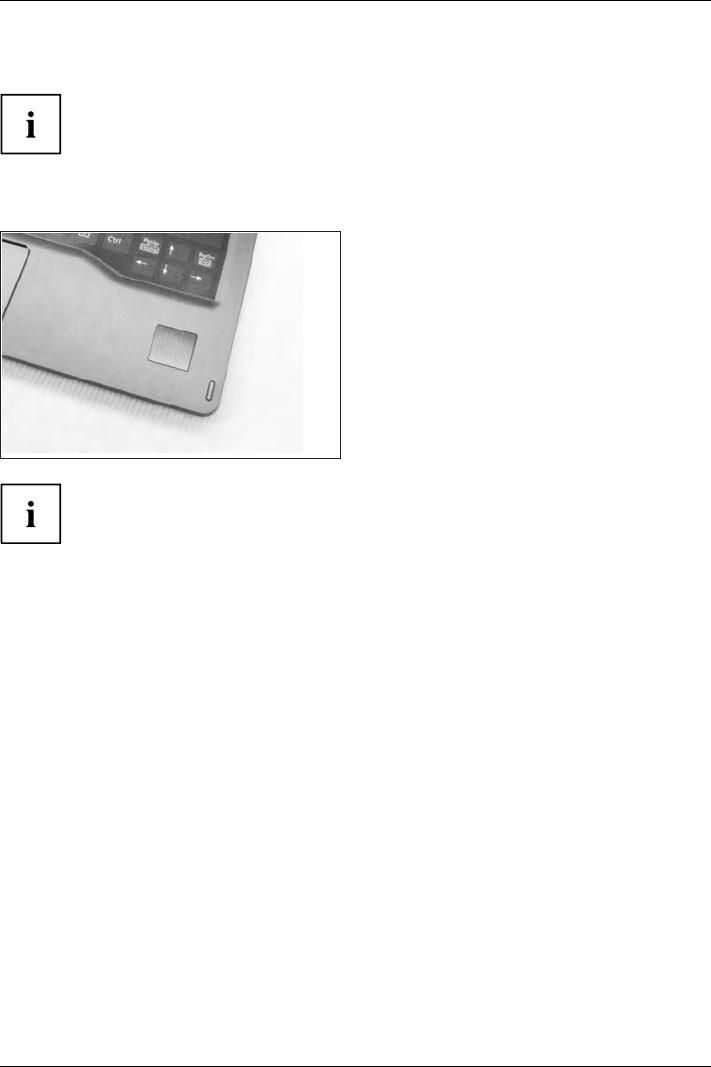
Security functions
Configuring the fingerprint sensor
Fingerprintsens orFingerpr intsensor
Whether your device has a fingerprint sensor or not depends on the
device configuration which you ordered.
The fingerprint sensor can record the image of a fingerprint. With additional fingerprint
software, this image can be processed and used instead of a password.
►Install the fingerprint software to be able
to use the fingerprint sensor (1).
You can obtain further information on the fingerprint sensor in the
"appendix: Miscellaneous Information".
Fujitsu 69
1
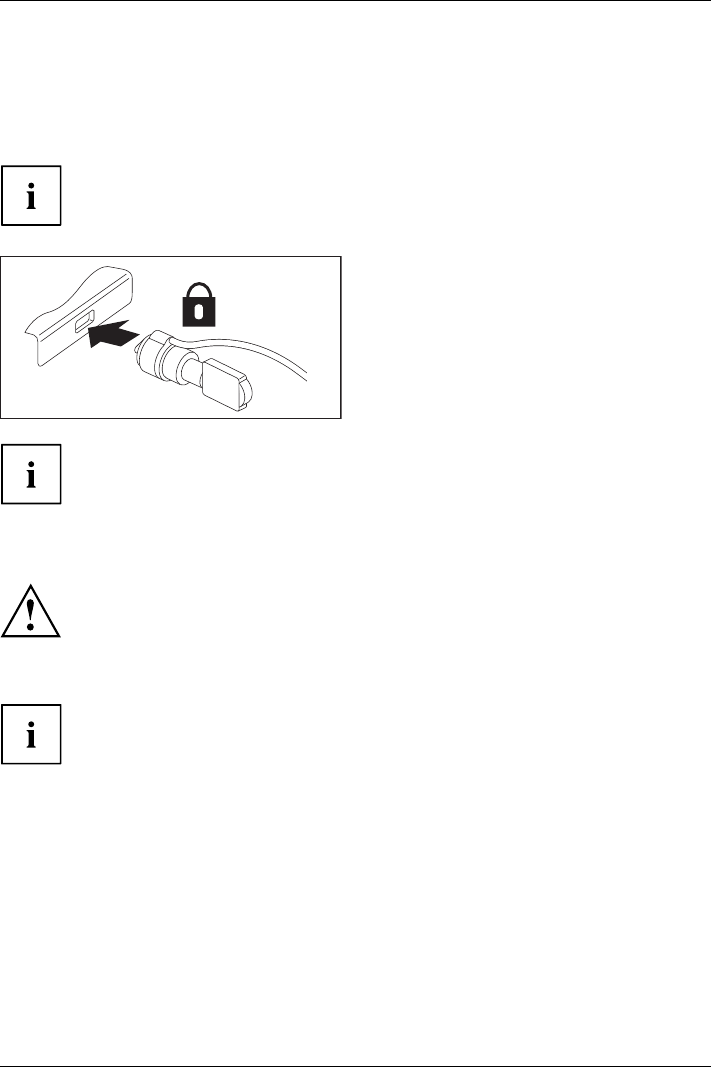
Security functions
Using the Security Lock
Your device comes with a Security Lock mechanism for the Kensington Lock Cable. You
can use the Kensington Lock Cable, a sturdy steel cable, to help protect your notebook
from theft. The Kensington Lock Cable is available as an accessory.
Fujitsu recommends the use of a combination lock.
►Fit the Kensington Lock Cable to the
mechanism on your notebook.
KensingtonLoc kCableUsingt hesecurity lock
Mechanicalsec urityAnti-theftprotection
Attach another Kensington Lock Cable to your port replicator to protect
your port replicator from theft as well.
Confguring passwordprotectioninBIOSSetupUtility
Before using the various options for password protection in the BIOS Setup
Utility, please proceed as follows to increase data security:
Make a note of the passwords and keep them in a safe place. If you forget your
supervisor password you will not be able to access your notebook. Passwords are
not covered by your warranty and a charge will be made for assistance.
Password protection
Your password can be up to 32 characters long and can contain letters, numbers and
special characters. A distinction is made between upper and lower case.
When using special characters, please note that these are dependent on
the country-specific variant of the keyboard used.
70 Fujitsu

Security functions
Protecting BIOS Setup Utility (supervisor password
and user password)
If you have opened these operating instructions on the screen, we recommend
that you print them out. You cannot call up the instructions on the screen
while you are setting up the password.
BIOSSetupUtility
The supervisor password and the user password both prevent unauthorized use of the BIOS
Setup Utility. The supervisor password allows you to access all of the functions of the BIOS Setup
Utility, while the user password will only give you access to some of the functions. You can
only set up a user password if a supervisor password has already been assigned.
Calling and using the BIOS Setup Utility is described in the chapter
"Settings in BIOS Setup Utility", Page 89.
Assigning the supervisor and user passwords
►Start the BIOS Setup Utility and go to the Security menu.
►Select the Set Supervisor Password field and press the Enter key.
With Enter new Password: you are asked to enter a password.
►Enter the password and press the Enter key.
Confirm new Password requires you to confirm the password.
►Enter the password again and press the Enter key.
Changes have been saved is displayed as a confirmation that the new password has been saved.
►To set the user password, select Set User Password and proceed exactly as
when configuring the supervisor password.
If you do not want to change any other settings, you can exit BIOS Setup Utility.
►In the Exit menu, select the option Save Changes & Exit.
►Select Yes and press the Enter key.
PasswordSupervisorpasswor dUserpassword
The notebook is then rebooted and the new password comes into effect. It will now be necessary
to first enter your supervisor or user password in order to open the BIOS Setup Utility. Please
note that the user password only provides access to a few of the BIOS settings.
Changing the supervisor password or user password
You can only change the supervisor password when you have logged into the
BIOS Setup Utility with the supervisor password.
PasswordSupervisorpasswordUser password
►Start the BIOS Setup Utility and go to the Security menu.
►When changing the password, proceed exactly as when assigning a password.
Fujitsu 71

Security functions
Removing passwords
To remove a password (without setting a new password) perform the following steps:
PasswordSupervisorpasswordUser password
►Start the BIOS Setup Utility and go to the Security menu.
►Highlight the Set Supervisor Password or Set User Password field and press the Enter key.
You will be requested to enter the current password by the Enter Current Password prompt.
Enter New Password will appear and you will be requested to enter a new password.
►Press the Enter key twice at this request.
►In the Exit menu, select the option Save Changes & Exit.
►Select Yes and press the Enter key.
The notebook will now reboot with the password removed.
With the supervisor password, you simultaneously deactivate the user password.
Password protection for booting the operating system
With the supervisor password you have set in the BIOS Setup Utility (see
section "Assigning the supervisor and user passwords", Page 71), you can
also prevent booting of the operating system.
Operating system
Activating system protection
►Start the BIOS Setup Utility and go to the Security menu.
Operatingsystem
►Select the Password on Boot option and press the Enter key.
►Select the option you require (Disabled,First Boot or Every Boot) and press the enter key
►Select the Save Changes & Exit option under Exit.
The notebook will reboot. You will be prompted to enter your password (the supervisor password).
Deactivating system protection
►Start the BIOS Setup Utility and go to the Security menu.
Operatingsystem
►Select the Password on Boot option and press the Enter key.
►Select the Disabled option and press the Enter key.
If you do not want to change any other settings, you can exit BIOS Setup Utility.
►Select the Save Changes & Exit option under Exit.
The notebook will reboot. The system is no longer password-protected.
Password protection for the hard disk
If a supervisor password was set, an additional password for the hard disk
can be set in the Hard Disk Security menu.
The hard disk is protected by this password. Data on this hard disk can then only be
read in another system if the correct password is entered.
72 Fujitsu
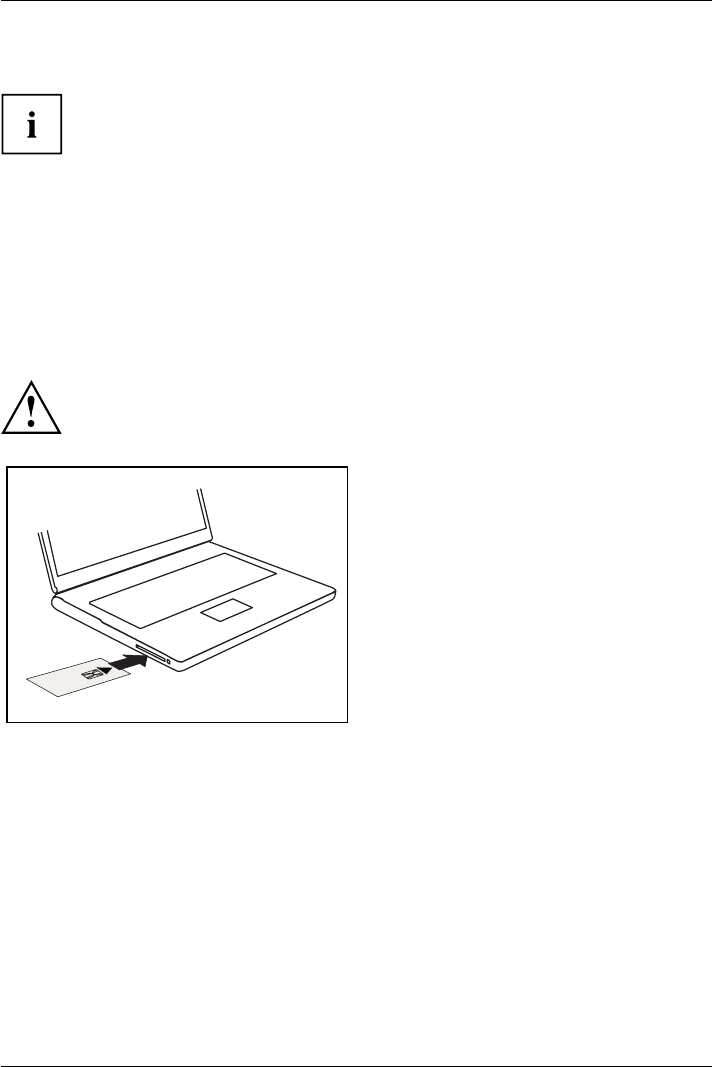
Security functions
Smart Card reader
SecurityfunctionsSecurityfunctions
Depending on the device configuration, your notebook is equipped
with a Smart Card reader.
Smart Cards are not supplied as standard equipment. You can use all Smart Cards that comply with
the ISO standard 7816-1, -2 or -3. These Smart Cards are available from various manufacturers.
With the appropriate software you can use your Smart Card as an alternative to password
protection, but also as a digital signature, for encrypting your e-mails or for home banking.
We recommend that you always use two Smart Cards. Always keep one of the Smart Cards
in a safe place if you are carrying the other Smart Card with you.
Inserting the Smart Card
Do not use force when inserting and removing the Smart Card.
Make sure that foreign objects do not fall into the Smart Card reader.
►Slide the Smart Card into the Smart
Card reader with the chip facing upwards
(or downwards depending on the
device) and to the front.
Fujitsu 73

Security functions
Trusted Platform Module - TPM (device dependent)
TPMTrusted PlatformM odule
To use the TPM, you must enable the TPM in the BIOS-Setup before the software is
installed. The requirement for this is that you have assigned at least the supervisor
password (see "Security functions", Page 67).
Enabling TPM
• Requirement: You have assigned a supervisor password (see "Security functions", Page 67).
►Call BIOS Setup and select the Security menu.
►Mark the TPM Security Chip Setting field and press the Enter key.
►Select the entry Enabled to enable the TPM
Once you have enabled the TPM the Clear Security Chip menu item appears.
You can clear the holder in the TPM using Clear Security Chip.WithEnabled,
all secret keys (e.g. SRK - Storage Root Keys, AIK - Attestation Identity Keys
etc.) generated by applications are deleted.
Take note that you can then no longer access the data you have
encrypted on the holder-based keys!
►From the Exit menu, select the option Exit Saving Changes.
►Press the Enter key and select Yes.
The notebook restarts and the TPM is switched on after the reboot.
Disabling TPM
• Requirement: You have assigned a supervisor password (see "Security functions", Page 67).
►Call BIOS Setup and select the Security menu.
►Mark the TPM Security Chip Setting field and press the Enter key.
►Select the entry Disabled to disable the TPM.
►From the Exit menu, choose the option Exit Saving Changes.
►Press the Enter key and select Yes.
The notebook will now reboot with TPM deactivated.
74 Fujitsu

Connecting external devices
Connecting external devices
Under all circumstances, please observe the safety notes provided in the
"Important notes", Page 15 chapter before connecting or disconnecting
any devices to or from your notebook.
Always read the documentation supplied with the device you wish to connect.
Never connect or disconnect cables during a thunderstorm.
Never pull at a cable when disconnecting it. Always grasp the plug.
With some devices such as USB devices, it is not necessary to switch off
the notebook and the device before connecting/disconnecting. For more
information about whether or not devices need to be switched off, please refer
to the documentation supplied with the external device.
Some of the external devices require special drivers (see the operating
system and external device documentation).
Fujitsu 75
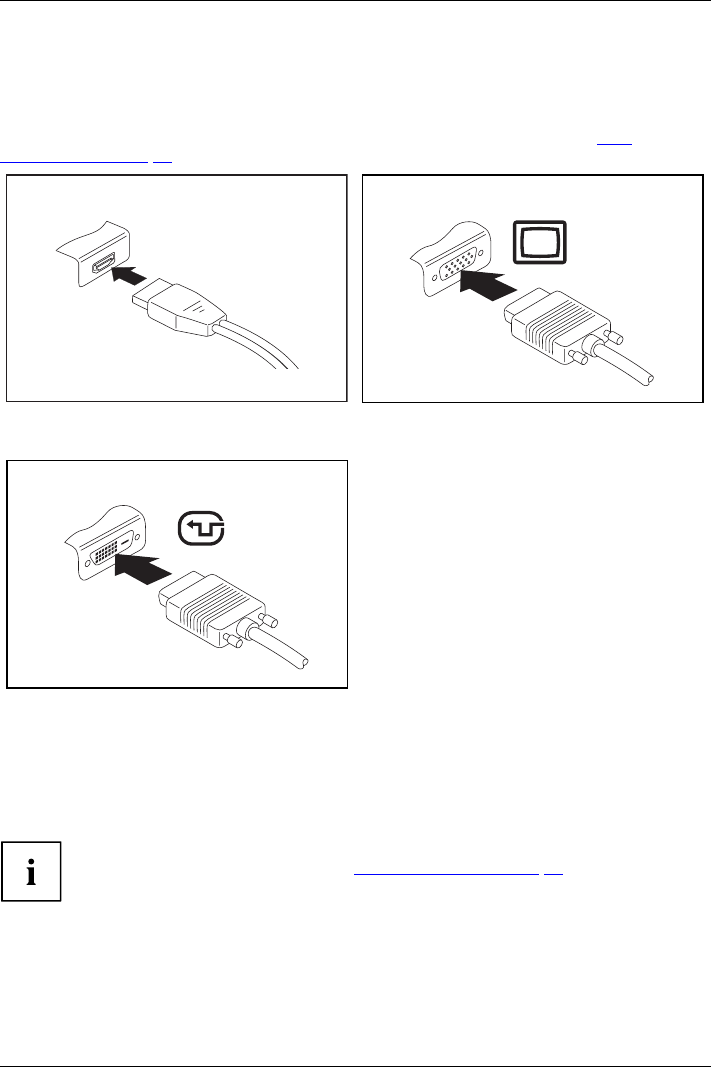
Connecting external devices
Connecting an external monitor
An analog monitor is connected to the analog external monitor port (VGA), a digital
monitor to the Display Port or to the DVI-D monitor port on the optional port replicator.
The display output is limited to a maximum of two monitors at any one time (see "Key
combinations", Page 43, section "Toggle display output").
MonitorVGAsocketMonitorportMonitorport
Digital Display Port (on notebook or on optional
port replicator) Analog external monitor port (VGA) (on
notebook or on optional port replicator)
Digital DVI-D monitor port (on optional port
replicator)
►Switch off the notebook and the external monitor.
►Plug the data cable of the external monitor into the monitor port.
►First switch on the external monitor and then the notebook.
You can also switch back and forth between the external monitor and the LCD
screen of the notebook, see chapter "Key combinations", Page 43.
You can display the same picture on the external monitor and the
notebook LCD screen simultaneously.
76 Fujitsu
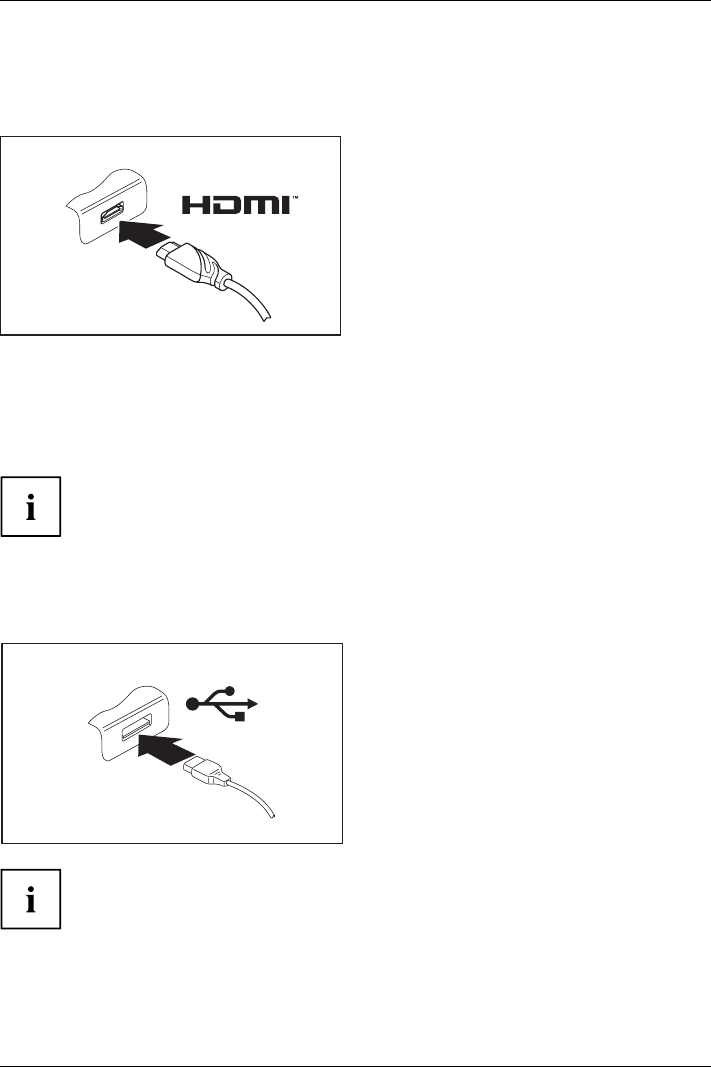
Connecting external devices
HDMI port
HDMIport
The HDMI port on your notebook can be used to connect an external amplifier,
LCD TV or a plasma TV with an HDMI connection.
►Connect the data cable to the
external device.
►Connect the data cable to the HDMI
port of the notebook.
Connecting USB devices
USBports
On the USB ports you can connect external devices that also have a USB port
(e.g. a DVD drive, a printer, a scanner or a modem).
USB devices are hot-pluggable. This means you can connect and disconnect the
cables of USB devices while the operating system is running.
USB 1.x has a maximum data transfer rate of 12 Mbps.
USB 2.0 has a data transfer rate of up to 480 Mbps.
USB 3.0 has a data transfer rate of up to 5 Gbps.
Additional information can be found in the documentation for the USB devices.
►Connect the data cable to the
external device.
►Connect the data cable to a USB
port of the notebook.
Device drivers
USB devices will be automatically recognized and installed by your operating system.
Fujitsu 77
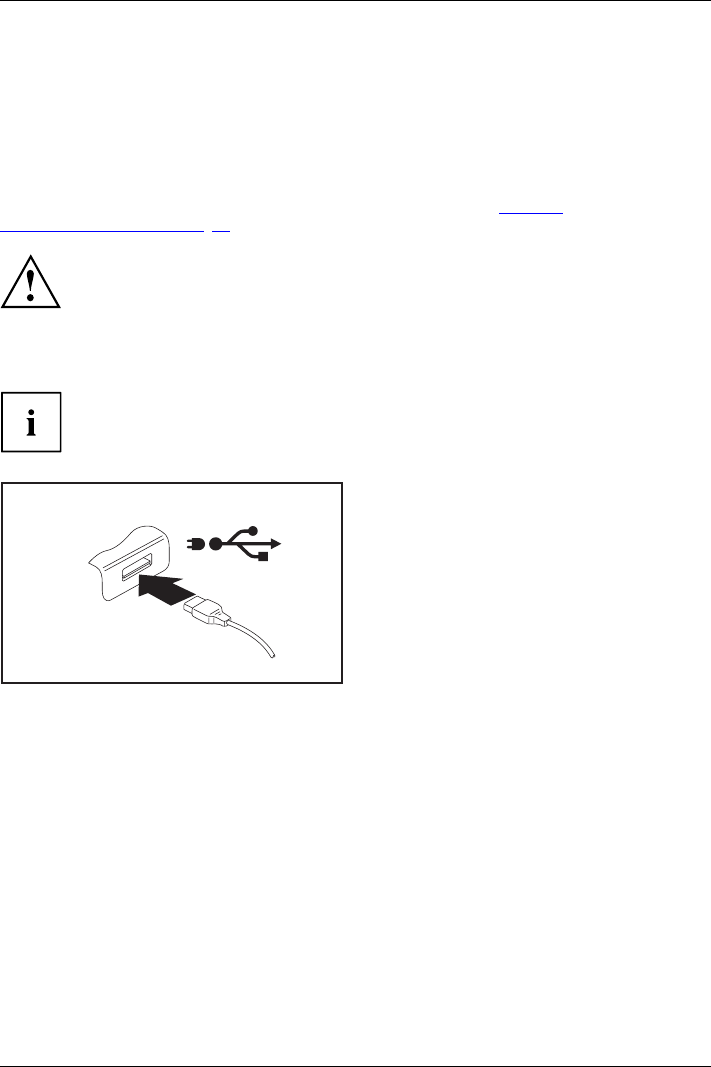
Connecting external devices
USB port with charging function (Anytime USB charge)
USBchargingfunction
You can use this USB port to charge or supply power to a USB device (e.g. to charge
a PDA or a mobile phone or to connect a USB lamp).
This is possible even when the notebook is switched off; in the BIOS-Setup-Utility in the Advanced
menu the function Anytime USB Charge must be activated. If the setting AC is selected thereby,
the device will only be charged when the mains adapter is connected.
Calling and using the BIOS-Setup-Utility is described in the section "Settings
in BIOS Setup Utility", Page 89.
It is recommended that the notebook be operated with the AC adapter connected
whenever the USB port with charging function is in use, as this function will drain
the battery more quickly if an external USB device is being charged.
The AC adapter must already be connected when the notebook is switched
off, as otherwise the USB charging function will be disabled and the
connected USB devices will not be charged.
Some USB devices (e.g. mobile telephony) require a driver in order to utilize the USB
charging function. In this case the USB charging function will not work when the
notebook is switched off, as no drivers are active when the notebook is switched off.
►Connect the data cable to the
external device.
►Connect the data cable to a USB port
(Antime USB charge) of the notebook.
78 Fujitsu
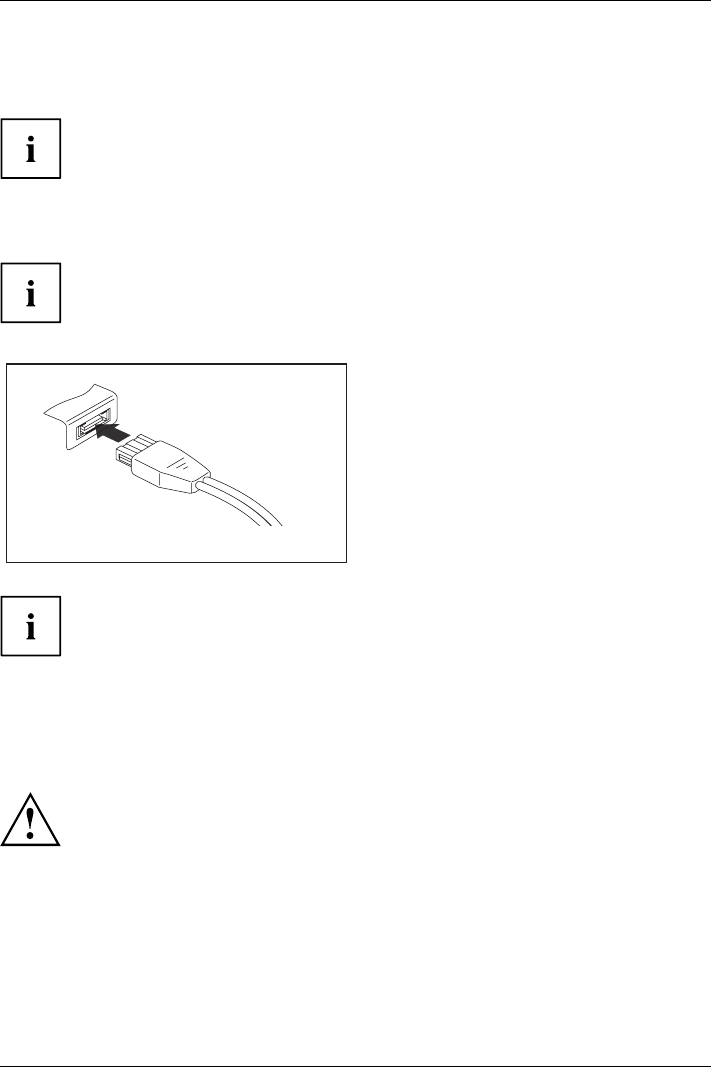
Connecting external devices
Connecting an external SATA hard drive (eSATA)
(port replicator only)
The notebook itself does not have an eSATA port. The port replicator which is
available as an option for your notebook offers you this type of port.
An external SATA hard disk can be connected at the eSATA port. This allows you
to expand the internal hard disk capacity as you wish.
The length of the eSATA cable must not exceed 2 meters. Seek advice from a specialty
store as to which eSATA data cable is suitable for your external eSATA hard disk.
Note that the hard drive has its own external power supply available.
The data transfer rate is up to 2,400 Mbps.
eSATA
►Connect the data cable to the external
device.
►Connect the data cable to the eSATA port.
Device drivers
The eSATA hard disk is automatically recognized by your operating system and installed.
You will find more information in the documentation for the external SATA
hard disk and the operating system.
Safe removal of eSATA and USB devices
Always correctly remove the device according to the rules described below,
to ensure that none of your data is lost.
►Click on the symbol for safe removal of hardware with the left mouse button.
►Select the device you wish to shut down and remove.
►Press the "Enter" key.
Wait for the dialog box which tells you that it is now safe to remove the device.
Fujitsu 79
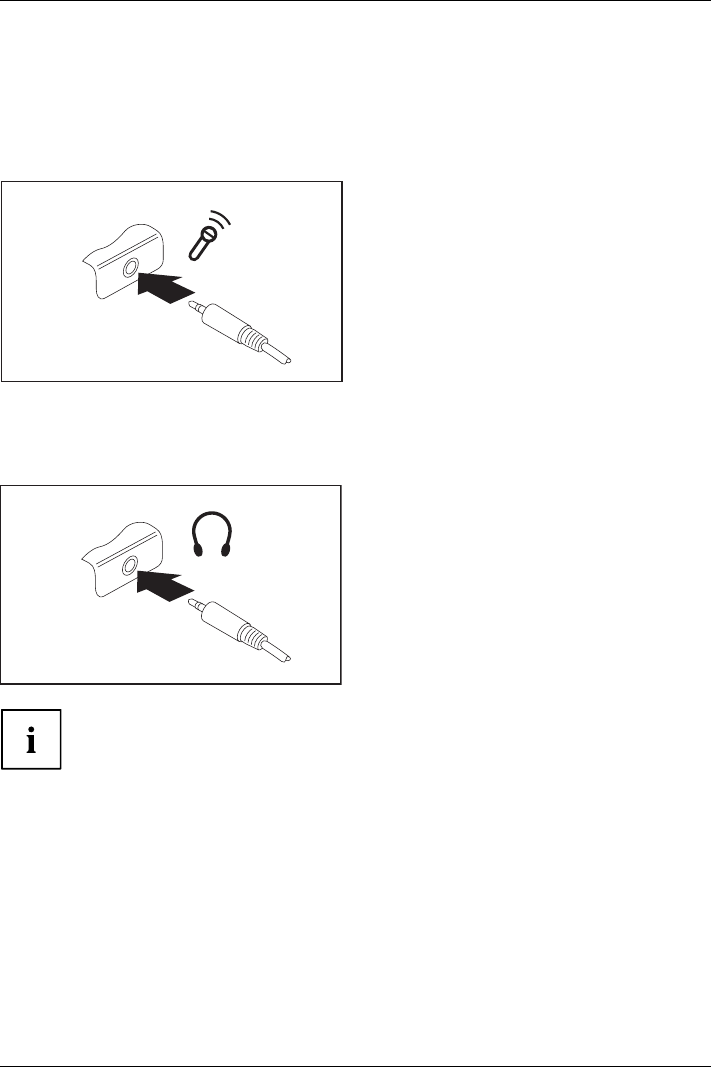
Connecting external devices
Connecting external audio devices
Microphone port/Line In
Connectingaudio devicesAudioconnectionsConnectingmicrophone
The microphone port/Line In allows you to connect an external microphone, a MiniDisc
player, MP3 player, CD player or a tape deck to your notebook.
►Connect the audio cable to the
external device.
►Connect the audio cable to the microphone
port/Line In of the notebook.
Headphones port
Connectingaudiodevices
Audioconnections
Connectingheadphones
You can connect headphones or external speakers to your notebook via the headphones port.
►Connect the audio cable to the
external device.
►Connect the audio cable to the headphones
port of the notebook.
The internal speakers are disabled.
If you buy a cable from a retailer, please note the following information:
The headphones port on your notebook is a "3.5 mm jack".
If you want to connect headphones or speakers you will need a "3.5 mm jack plug".
80 Fujitsu

Removing and installing components during servicing
Removing and installing components
during servicing
Only qualified technicians should repair your notebook. Unauthorized
opening or incorrect repair may greatly endanger the user (electric shock,
fire risk) and will invalidate your warranty.
Components
Incaseofservice
You may remove and install the components described in this chapter yourself
after consulting the Hotline/Service Desk.
If you remove and install components without consulting the Hotline/Service
Desk, then the warranty of your notebook will be voided.
Notes on installing and removing boards
and components
• Switch off your notebook and remove the AC plug from the power outlet.
• Always remove the battery.
• Take care when you use the locking mechanisms for the battery and any other component.
• Never use sharp objects such as screwdrivers, scissors or knives as a lever to remove covers.
InstructionsBoardsESD Boards with electrostatic sensitive devices (ESD) are marked with the label
shown.
When handling boards fitted with ESDs, you must always observe the following
points:
• You must always discharge static build up (e.g. by touching a grounded
object) before working with boards.
• The equipment and tools you use must be free of static charge.
• Remove the AC plug from the power outlet before inserting or removing
boards.
• Always hold boards by their edges.
• Never touch connector pins or conductors on the board.
Fujitsu 81
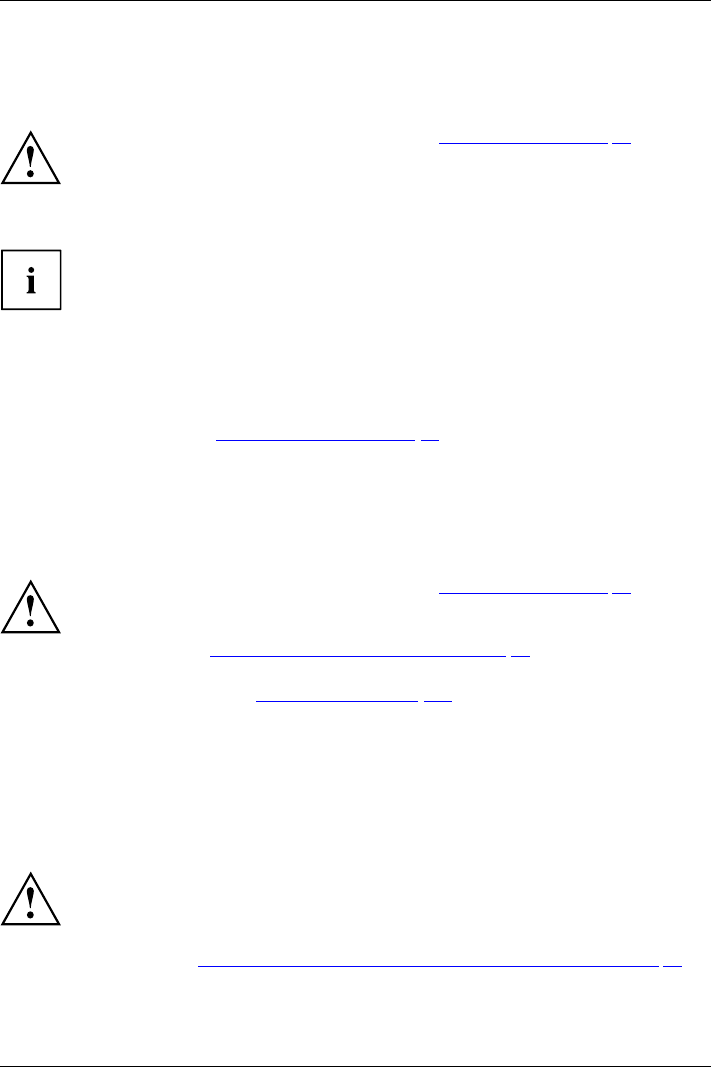
Removing and installing components during servicing
Preparing to remove components
If you are going to remove or change system components, prepare for the removal as follows:
Please observe the safety information in chapter "Important notes", Page 15.
Remove the AC plug from the power outlet!
►Switch the device off.
The device must not be in energy saving mode.
►Close the LCD screen.
►Remove all the cables from the device.
►Turn the device over and place it on a stable, flat and clean surface. If necessary, lay an
anti-slip cloth on this surface to prevent the device from being scratched.
►Remove the battery,see"Removing a battery", Page 48.
Removing and installing memory expansion
MemorymoduleMainmemoryMemoryremovalSystemexpansion
Systemexpansi on
If you are asked by the Hotline/Service Desk to remove or install a memory
expansion module yourself, proceed as follows:
Please observe the safety information in chapter "Important notes", Page 15.
During installation/removal of memory modules, the battery must remain
removed from the notebook and the notebook must not be connected to the
AC adapter, see "Preparing to remove components", Page 82.
Only use memory modules that have been approved for use in your
notebook (see chapter "Technical data", Page 101).
Never use force when installing or removing a memory module.
Make sure that no foreign objects fall into the memory upgrade compartment.
You must open the memory upgrade compartment to remove or install a memory
module. On some devices, it is possible that opening the compartment exposes various
components. Only authorized specialists are permitted to remove or change these
components. Therefore, be sure to observe the following:
Individual components can become very hot during operation. Therefore, we
recommend that you wait one hour after switching the notebook off before removing
or installing memory modules. Otherwise, there is a risk of suffering burns!
As some components are exposed that are sensitive to static electricity, please take
note of chapter "Notes on installing and removing boards and components", Page 81.
82 Fujitsu
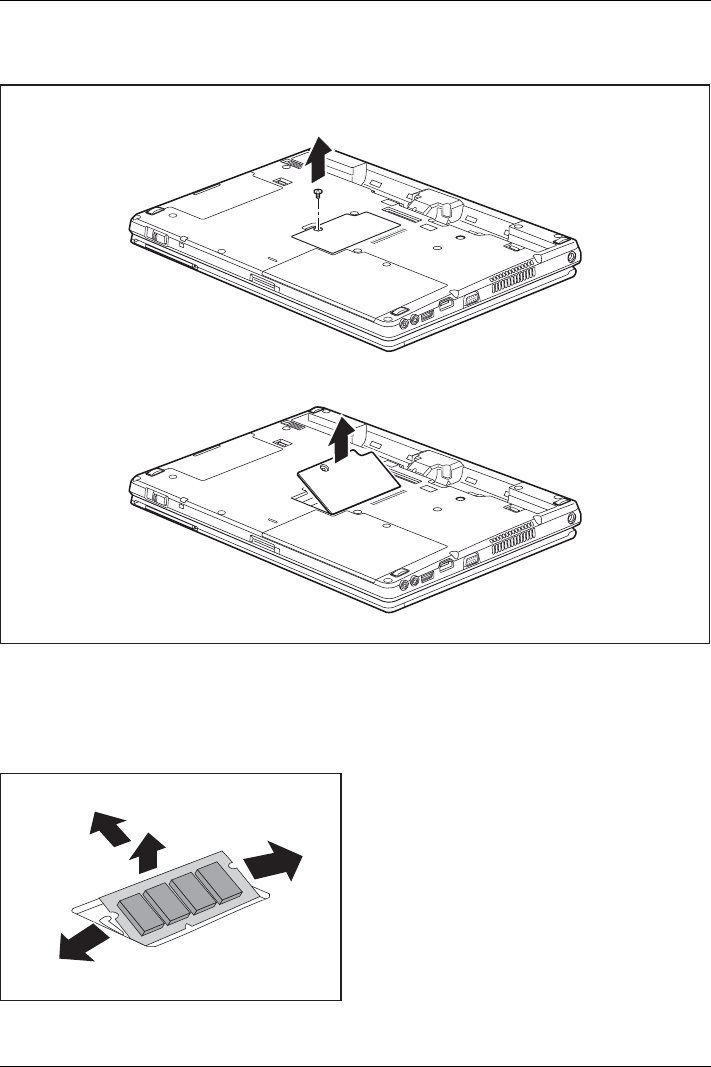
Removing and installing components during servicing
Remove the cover
1
2
►Remove the screw (1).
►Lift the cover off the notebook in the direction of the arrow (2).
Removing a memory module
3
2
1
1
►Carefully push the two mounting
clips outwards (1).
MemoryexpansionMemorymodule
The memory module will fold upwards (2).
►Pull the memory module out of its slot
in the direction of the arrow (3).
Fujitsu 83
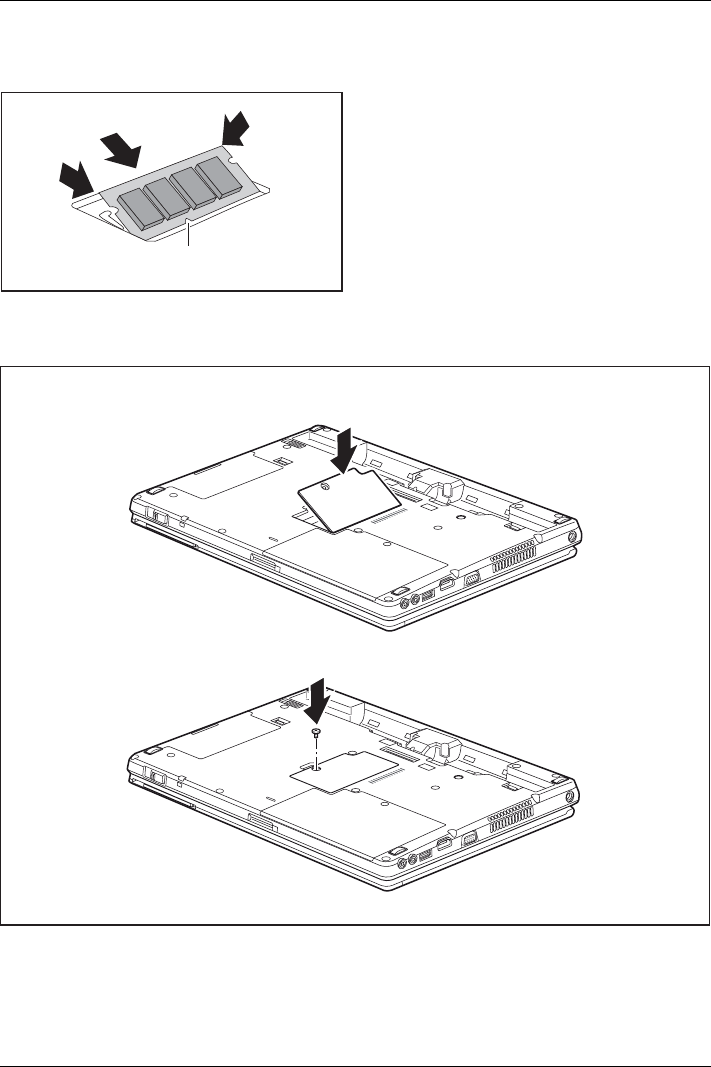
Removing and installing components during servicing
Installing a memory module
2
a
1
2
►Insert the memory module with the contacts
and the recess (a) forward in the slot (1).
MemoryexpansionMemorymodule
►Carefully push the memory module
downwards until you feel it click
into place (2).
Attaching the cover
1
2
►Place the cover into position, following the direction of the arrow (1).
►Fasten the cover in place with the screw (2).
84 Fujitsu
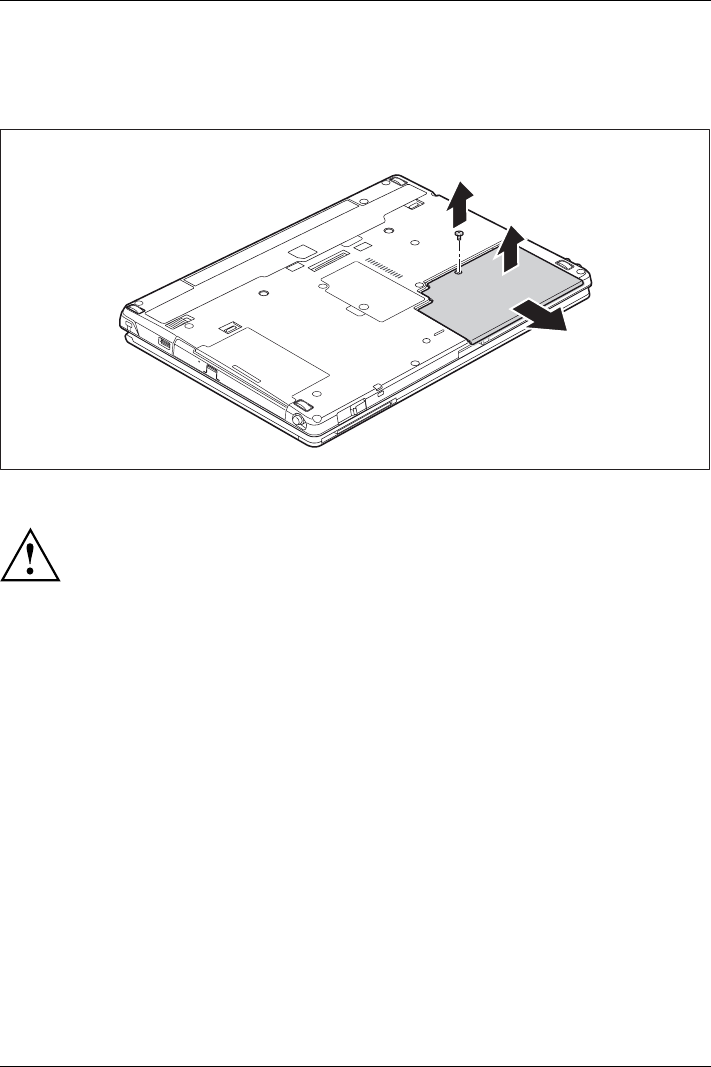
Removing and installing components during servicing
Removing and installing the harddisk
Remove the cover
2
1
3
►Remove the screw (1).
Keep the screw in a safe place. If you are removing more than one component at
the same time, store the screws for the individual components separate from each
other. If you install the wrong screws, components may be damaged.
►Slide the cover in direction of the arrow (2).
►Lift the cover off the notebook (3).
Fujitsu 85
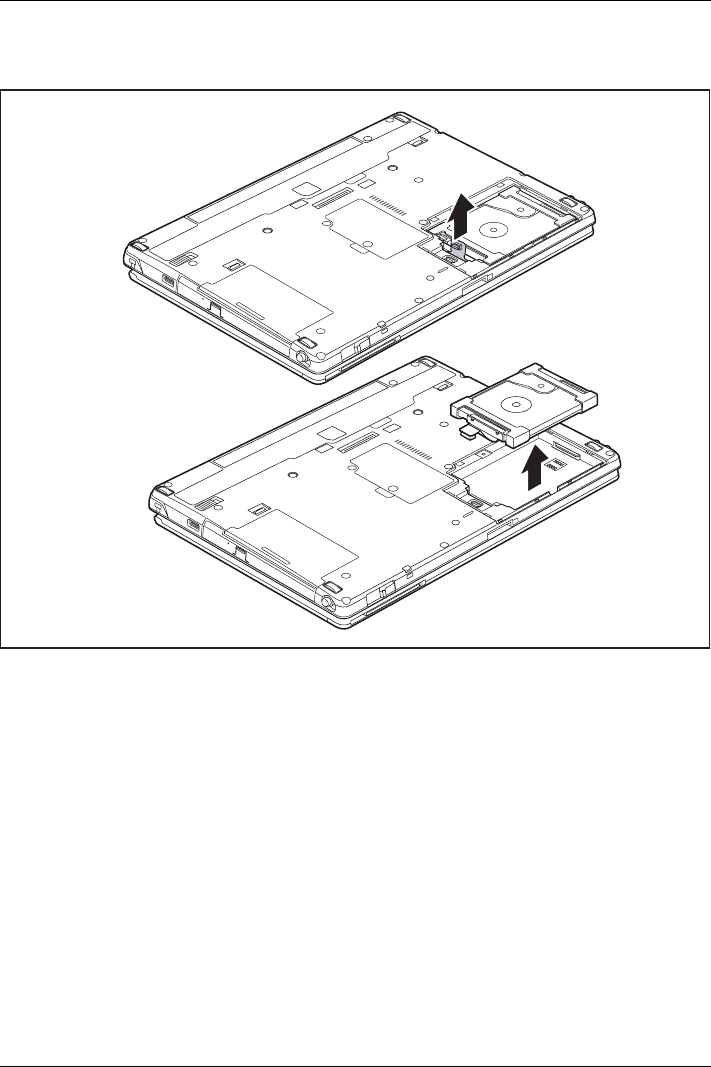
Removing and installing components during servicing
Removing the hard disk
1
2
►Unfasten the hard disk fastening (1).
►Remove the hard disk from the hard disk compartment (2).
86 Fujitsu
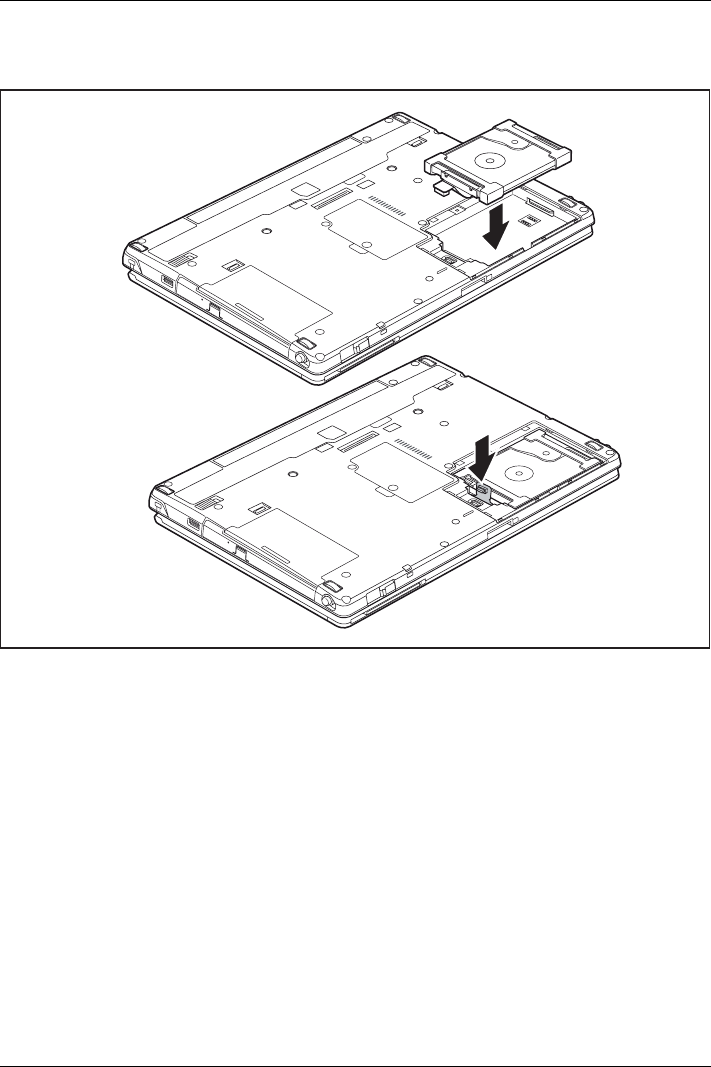
Removing and installing components during servicing
Installing a hard disk
1
2
►Place the hard disk into the hard disk compartment (1).
►Attach the retainer for the hard disk (2).
Fujitsu 87
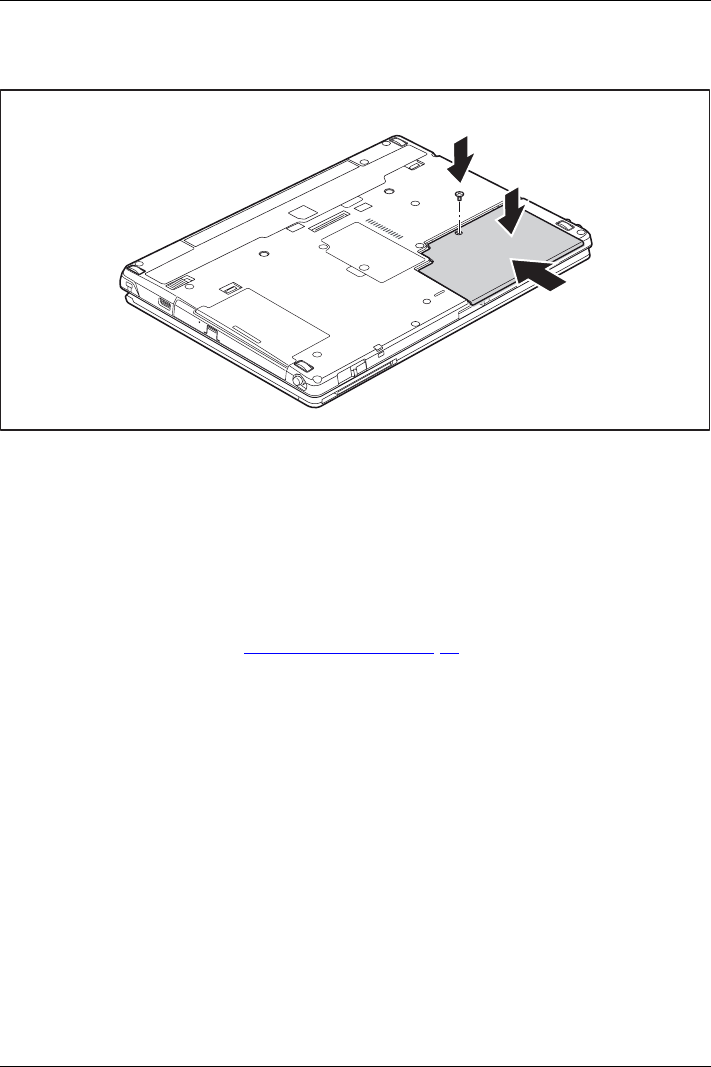
Removing and installing components during servicing
Attaching the cover
2
1
3
►Place the cover in the correct location (1).
►Slide the cover in the direction of the arrow (2).
►Tighten the screw (3).
Finishing component removal
After you have removed or changed the system components as required, please
prepare your device for operation again as follows:
►Install the battery again, see "Installing a battery", Page 49.
►Turn the notebook the right way up again and place it on a flat surface.
►Reconnect the cables that were previously disconnected.
88 Fujitsu

Settings in BIOS Setup Utility
Settings in BIOS Setup Utility
BIOSSetupUtilitySystemsettings,BIOSSetupUtilityConfiguration,BIOSS etupUtilitySetupConfiguringsy stemConfiguring hardware
The BIOS Setup Utility allows you to set the system functions and the hardware
configuration for the notebook.
When a notebook is delivered, the factory default settings are effective. You can change
these settings in the menus of the BIOS Setup Utility. Any changes you make take
effect as soon as you save and exit the BIOS Setup Utility.
The BIOS Setup Utility program contains the following menus:
About Displays information relating to the BIOS, processor and notebook
System Advanced system settings
Advanced Configuration of various hardware components, such as mouse, keyboard,
processor
Security Password settings and security functions
Boot Configuration of the start-up sequence
Exit Exits the BIOS Setup Utility
Starting the BIOS Setup Utility
►Reboot the device (switch off/on or reboot the operating system).
BIOSSetupUtility
Depending on the setting for Fast Boot in the BIOS-Setup-Utility, the following
notification may appear on the screen during start-up:
<F2> BIOS Setup <F12> Boot Menu
►Press the function key F2 .
►If a password has been assigned, enter the password and press the Enter key.
If you have forgotten the password, contact your system administrator
or contact our customer service center.
The BIOS Setup Utility starts.
Fujitsu 89

Settings in BIOS Setup Utility
BIOS Setup Utility operation
BIOSSetupUtility
Press the F1 key to display help about operation of the BIOS Setup Utility. The description
of the individual settings is shown in the right-hand window of the BIOS Setup Utility.
With the F9 key you can load the default settings of the BIOS Setup Utility.
►Use the cursor keys ←or →to select the menu you wish to access to make changes.
The menu is displayed on the screen.
►Select the option you want to change with the cursor keys ↑or ↓.
►Press the "Enter" key.
►Press the ESC key to exit the selected menu.
►For future reference, make a note of the changes you have made (for example, in this manual).
90 Fujitsu

Settings in BIOS Setup Utility
Exiting BIOS Setup Utility
BIOSSetupUtility
You need to select the desired option in the Exit menu and activate it by pressing the Enter key:
Exit Saving Changes - save changes and exit BIOS Setup Utility
►To save the current menu settings and exit the BIOS Setup Utility,selectExit Saving Changes and Yes.
The notebook is rebooted and the new settings come into effect.
Exit Discarding Changes - Reject changes and
exit BIOS Setup Utility
►To discard the changes, select Exit Discarding Changes and Yes.
The settings in place when BIOS Setup Utility was called remain effective. BIOS
Setup Utility is terminated and the notebook is rebooted.
Load Setup Defaults – load default values
►To copy the standard entries for all menus of the BIOS Setup Utility,
choose Load Setup Defaults and Yes.
Discard Changes - Discard Changes without
exiting BIOS Setup Utility
►To discard the changes you have made, select Discard Changes and Yes.
ThesettingsinplacewhenBIOS Setup Utility was called remain effective.
You can now make additional settings in the BIOS Setup Utility.
►If you want to exit the BIOS Setup Utility withthesesettings,selectExit Saving Changes and Yes.
Save Changes - save changes without exiting
the BIOS Setup Utility
►To save the changes, select Save Changes and Yes.
The changes are saved. You can now make additional settings in the BIOS Setup Utility.
►If you want to exit BIOS Setup Utility with these settings, choose Exit Saving Changes and Yes.
Save changes and power off
►To save the changes and switch off your device, select Save Changes and Power Off and Yes.
The changes are saved. Your device is shut down.
Fujitsu 91

Troubleshooting and tips
Troubleshooting and tips
TroubleshootingTipsFaultProblemsolving
If a fault occurs, try to correct it as described. If you fail to correct the problem, proceed as follows:
►Make a note of the steps and the circumstances that led to the fault. Also
make a note of any error messages displayed.
►Switch the notebook off.
►Please contact the Hotline/Service Desk.
You can contact Fujitsu Service and Support in the following ways:
• Toll free phone: 1-800-8Fujitsu (1-800-838-5487)
• Website: "http://solutions.us.fujitsu.com/www/content/support/contact/index.php"
Before you place the call, have the following information ready so that the customer
support representative can provide you with the fastest possible solution:
• The model name and serial number of the notebook. The serial number is
located on a sticker on the underside of the notebook.
• Notes with the messages that appeared on the screen and
informationonaco
ustic signals.
• Any changes you have made to the hardware or software since
receiving the notebook.
• Any changes you have made to the BIOS Setup settings after receiving the notebook.
• Your system configuration and all peripheral devices connected to your system.
• Your sales contract.
Our notebooks have been designed primarily with mobile applications in mind.
This means that considerable effort has been made to optimize components and
equipment in terms of weight, space and energy requirements. Depending on the
particular configuration you have purchased, it is possible that functionality may be
slightly reduced compared to a desktop PC if you are running processor-intensive
gaming software, e.g. games with intensive 3D graphics. Updating your hardware with
drivers which have not been approved by Fujitsu may result in performance losses,
data losses or malfunction of the equipment. A list of approved drivers and current
BIOS versions can be downloaded from: "http://solutions.us.fujitsu.com"
Help if problems occur
Should you encounter a problem with your computer that you cannot resolve yourself:
►Note the ID number of your device. The ID number is found on the type rating
plate on the back or underside of the casing.
►For further clarification of the problem, contact the Fujitsu Service Desk. When you do
this, please have ready the ID number and serial number of your system.
Recovering your Factory Image
In the event you need to restore your original Factory Image, please refer to
the appendix of this Operating Manual.
92 Fujitsu
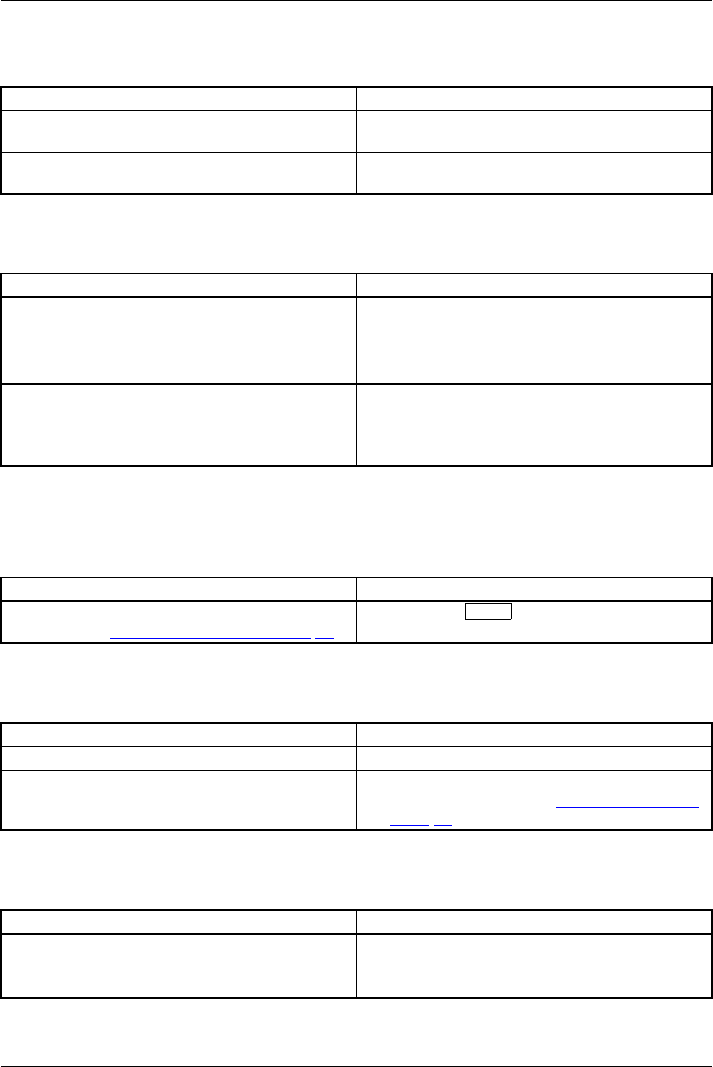
Troubleshooting and tips
The notebook’s date or time is incorrect
Incorrecttim eTime notcorrectWrongdate/timeDatenotcorrect
Cause Troubleshooting
Time and date are incorrect. ►With the BIOS-Setup-Utility,you can set the
date and time in the Main menu.
Date and time are still set incorrectly after
switching on the notebook.
►Please contact your sales outlet or our
hotline/service desk.
Battery indicator does not illuminate
Cause Troubleshooting
The battery is not installed correctly. ►Switch the notebook off.
►Check whether the battery is installed
correctly in its compartment.
►Switch the notebook on.
The battery is not being charged. ►Connect the Tablet PC to the AC voltage
using the AC adapter.
Note: The battery will only be charged again
when the battery capacity is less than 90%.
When certain characters are entered on the
keyboard, only numerals are written
Cause Troubleshooting
The virtual number keys of your device are
activated, see "Virtual number keys", Page 42
►Press the Num button.
The notebook’s LCD screen remains blank
LCDscreenBlankLCDscreen
Cause Troubleshooting
Screen is switched off. ►Press a key or touch the touchpad.
External monitor or television set connected. ►Press the key combination for changing over
the screen output, see "Key combinations",
Page 43.
The LCD screen of the notebook is diffcult to read
LCDscreenLCDscreen
Cause Troubleshooting
Reflected glare ►Turn the notebook or alter the tilt of the LCD
screen.
►Increase the brightness of the screen.
Fujitsu 93

Troubleshooting and tips
The external monitor remains blank
Monitor
Cause Troubleshooting
Monitor is switched off. ►Switch the external monitor on.
Power saving has been activated (monitor is
blank).
►Press any key to continue.
Brightness is set to dark. ►Adjust the brightness of the monitor.
Screen output is set to the notebook’s LCD
screen
►Press the key combination for changing over
the screen output, see "Key combinations",
Page 43.
The external monitor’s AC cable or data cable is
not connected properly.
►Switch off the external monitor and the
notebook.
►Check whether the AC cable is plugged
properly into the external monitor and into
the power outlet.
►Check whether the data cable is properly
connected to the notebook and the external
monitor (if it is plugged in with a connector).
►Switch on the external monitor and the
notebook.
The external monitor is blank or the image is unstable
MonitorMonitor
Cause Troubleshooting
The wrong external monitor has been selected
or the wrong screen resolution has been set for
the application program.
►Terminate the application program under
Windows by pressing Alt +F4 .Ifthe
error persists after terminating the program,
use the key combination for switching the
screen output (see "Key combinations",
Page 43), in order to switch to the LCD
screen of the notebook.
Change the following setting:
►Set the screen resolution: Set the screen
resolution as described in the documentation
foryouroperatingsystem.
►Select monitor: Select monitor 1 or 2 as
described in the documentation for your
operating system.
94 Fujitsu

Troubleshooting and tips
The cursor does not correctly follow the
stylus movements
Cause Troubleshooting
Stylus incorrectly calibrated. ►Calibrate the stylus as shown under
Hardware and Sound / Tablet PC Settings
in the Control Panel, see "Adjusting the
stylus", Page 36 and "Calibrating the stylus",
Page 36.
Stylus input not working
Cause Troubleshooting
Incorrect driver installed. ►If your device is one which can only be
operated using the stylus, install the driver
for the standard model.
or
►If your device is one which can be
operated using the stylus and by finger,
install the driver for the "Dual Digitizer"
model.
The notebook does not start after switching it on
Notebook
Cause Troubleshooting
The battery is not installed correctly. ►Check whether the battery is installed
correctly in its compartment.
►Switch the notebook on.
The battery is dead. ►Charge the battery.
or
►Insert a charged battery.
or
►Connect the AC adapter to the notebook.
The AC adapter is not connected properly. ►Check whether the AC adapter is properly
connected to the notebook.
►Switch the notebook on.
Fujitsu 95

Troubleshooting and tips
The notebook stops working
NotebookEnding
Cause Troubleshooting
The notebook is in energy saving mode. ►End energy saving mode.
An application program has caused the
malfunction.
►Close the application program or restart
the notebook (by restarting the operating
system or switching the device off and back
on again).
The battery is dead. ►Charge the battery.
or
►Insert a charged battery.
or
►Connect the AC adapter to the notebook.
The printer does not print
Printerdoesnot print
Cause Troubleshooting
The printer is not switched on. ►Make sure that the printer is switched
on and ready for operation (refer to the
documentation supplied with the printer).
The printer is not connected correctly. ►Check that the data cable connecting
the notebook to the printer is properly
connected.
The printer driver is faulty or not correctly
installed, or it is the wrong printer driver.
►Check whether the correct printer driver is
loaded (refer to the printer documentation).
The wireless connection to a network does not work
Thewirelessconnectiont oanetwork doesnotwor k
Cause Troubleshooting
The wireless component is switched off. ►Switch the wireless component on (see
"Switching the wireless components on and
off", Page 59).
The wireless component is switched on. Despite
this, the wireless connection to a network does
not work.
►Check whether the wireless connection is
enabled by the software.
►Further information on using the wireless
component can be found in the help files.
96 Fujitsu

Troubleshooting and tips
The battery discharges too quickly
Battery
Cause Troubleshooting
The battery is either too hot or too cold. In this
case the battery indicator flashes.
►Move the notebook so that its temperature
returns to within the normal range.
►If the operating time of the battery life is
extremely short, the battery is probably too
old. Replace the battery if necessary.
You may have an application running that
consumes a great deal of power due to frequent
accessing of the hard disk or optical drive.
►Use the AC adapter whenever possible.
The maximum brightness may have been set
for the screen.
►Set the screen slightly darker with the
key combination for Decreasing the screen
brightness in order to reduce the amount of
power being drawn.
Smart Card reader is not recognized
Cause Troubleshooting
Smart Card inserted incorrectly. ►Make sure you have inserted your Smart
Card into the Smart Card reader with
thechipfacingup
wards / downwards
(device-dependent).
►Check whether the Smart Card you are
using is supported. Your Smart Card must
comply with the ISO standard 7816-1, -2,
-3 and -4.
Smart Card PIN forgotten
Cause Troubleshooting
PIN forgotten ►If you are working in a network, contact your
system administrator, who can unlock your
notebook with a Supervisor PIN.
Smart Card lost
Cause Troubleshooting
Smart Card lost. ►If you are working in a network, contact your
system administrator, who can boot your
notebook with a Supervisor Smart Card.
Fujitsu 97

Troubleshooting and tips
User and/or supervisor Smart Card lost
Cause Troubleshooting
User and/or Supervisor Smart Card lost. ►If you have lost your user Smart Card, you
can continue working with the Supervisor
Smart Card and initialize a new user Smart
Card.
►If you have lost the Supervisor Smart Card,
you can also continue working, but you no
longer have all rights and cannot initialize
another Supervisor Smart Card.
►If you have lost both Smart Cards, you
cannot boot your system. Please contact our
customer service center. You must provide
proof of ownership for the device. The
customer service center will then refer you
to our service partner, who will unlock your
device (for a charge).
Acoustic warning
Acous tic wa rnin gs
Errors
Cause Troubleshooting
A beep sounds every few seconds.
The battery is almost dead.
►Charge the battery.
98 Fujitsu

Troubleshooting and tips
Error messages on the screen
Errormessages onthescr eenErrors
This section describes the error messages generated by the BIOS Setup. Error messages displayed
by the operating system or programs are described in the documentation for these programs.
If the error message appears repeatedly despite troubleshooting measures,
contact the place of purchase or our customer service center.
Error message/cause Troubleshooting
CMOS Battery Bad
If the error message occurs repeatedly, the
back-up battery in the notebook is dead.
►Contact your sales outlet or our customer
service center.
System CMOS checksum bad - Default configuration
used
The system configuration information is
incorrect.
►Switch the notebook off.
►Switch the notebook on.
►Press the function key F2 to access the
BIOS Setup.
►In the BIOS Setup, select the Exit menu.
►Select the entry Load Setup Defaults.
►Select OK and press the Enter key.
Extended memory failed at offset: xxxx Failing Bits:
zzzz zzzz
When testing the extended memory. an error
has resulted at the address xxxx.
►Check whether the additional memory
module has been inserted correctly.
Failure Fixed Disk n
The settings of the hard disk drive are incorrect.
►Start the BIOS Setup (Primary Master
submenu) and select the correct settings.
Keyboard controller error ►Switch off the notebook with the ON/OFF
button.
►Wait 3 - 5 seconds and switch on the
notebook again.
Keyboard error If you use an external keyboard:
►Check the connection and reboot the
notebook.
nn Stuck key ►Make sure that no key is pressed.
Operating system not found ►Check in the BIOS Setup whether your hard
disk has been set correctly.
►Make sure that the operating system is
installed on the corresponding drive.
Press <F1> to resume, <F2> to SETUP
This error message appears if an error occurs
during the self-test before starting the operating
system.
►Press the F1 function key to start the
operating system.
►Press the function key F2 to access the
BIOS Setup.
Fujitsu 99

Troubleshooting and tips
Error message/cause Troubleshooting
Previous boot incomplete - Default configuration
used Default values have been set for certain
settings because of an error which occurred in
the previous system boot. Check the settings in
the BIOS Setup.
►Press the F1 function key when prompted
to do so.
Real time clock error ►Contact your sales outlet or our customer
service center.
nnnnK Shadow RAM failed at offset: xxxx Failing
Bits: zzzz ►Contact your sales outlet or our customer
service center.
System battery is dead - Replace and run SETUP ►Contact your sales outlet or our customer
service center.
System cache error - Cache disabled ►Contact your sales outlet or our customer
service center.
System timer error ►Contact your sales outlet or our customer
service center.
100 Fujitsu

Technical data
Technical data
Notebook
General
Processor 6th Generation Intel® Core™ with vPro™
Technology (vPro optional, depending on
configuration)
Main memory (SO DIMM) Maximum 20 GB DDR4
1fixed slot with 4 GB (soldered)
1slotfor2GB,4GB,8GBor16GBmodules
Electrical data
Protection class III
Maximum power draw (when the notebook is
switched on and the battery is charged): 80 W (with and without connected port replicator)
LCD screen
Size 31.75 cm / 12.5" TFT HD
Resolution 1366 x 768 (HD), 16 million colors
Pixel class II
Brightness control 12 levels
Technology Wide-View High-Bright HD Display with LED
background lighting
Digitizer and glass panel • Dual Digitizer
• Matt touchscreen
• Hardened glass
Webcam Full HD camera (1080 p), with status indicator
Display adapter
Chip Intel® HD Graphics 520
Maximum resolution of external monitor: 1920 x 1200 subpixels, 16 million colors
on port replicator:
• VGA: 1920 x 1200 subpixels
• DVI: 1920 x 1200 subpixels
• Display Port: 2560 x 1600 subpixels
Dimensions
Width x Depth x Height 12.43 inches x 14.76 inches x 1 - 1.23 inches /
316 mm x 233 mm x 25.4 - 31.3 mm with rubber
feet
Weight depending on configuration from 3.84 lbs / 1.74 kg
Input devices
Keyboard 85 buttons, splashproof
Touchpad 2 keys
Fujitsu 101

Technical data
Tablet buttons 1 Windows button, Volume-Up button,
Volume-Down button
Stylus 1 freely programmable rocker button / eraser
Slots
Memory card slot 1xSDCard
SmartCard reader 1x
Ports
External monitor port (VGA) 15-pin socket
HDMI port 1 x
LAN port Socket, RJ45
Microphone port/LineIn 3.5mmstereominijack
Headphones port/Line Out 3.5mmstereominija
ck
Docking port 100-pin socket
USB (Universal Serial Bus) Total: 3 x USB (1 x USB 3.0 with charging
function (Anytime USB charge), 2 x USB 3.0)
Security Lock 1x
Ambient conditions
Environment class DIN IEC 721 7K1
Mechanism class DIN IEC 721 7M2
Operating temperature 5℃.... 35℃/41°F .... 95°F
Transport temperature (2K2) -15°C .... 60°C / 5°F .... 140°F
WLAN specifcations
Type of network Intel® Dual Band Wireless-AC 8265
11a/b/g/n/11ac, Wi-Fi based*
Transfer rate (Automatic switching) IEEE802.11 a and g: 54
Mbps max. data rate; IEEE802.11n: 300 Mbps
max. data rate, IEEE802.11ac: 867 Mbps max.
data rate
Active frequency • 802.11n: 2.4 GHz or 5 GHz
• 802.11b/g: 2400~2473 MHz
• 802.11a: 4900~5850 MHz
• 802.11a: 2.4 GHz / 5 GHz
102 Fujitsu

Technical data
Typical operating distances** • 802.11a: 40 ft. (12 m) @ 54 Mbps; 300 ft.
(91m)@6Mbps
• 802.11ac: 40 ft. (12 m) @ 54 Mbps; 300
ft.(91 m) @ 6 Mbps
• 802.11b: 100 ft. (30 m) @ 11 Mbps; 300 ft.
(91m)@1Mbps
• 802.11g: 100 ft. (30 m) @ 54 Mbps; 300 ft.
(91m)@1Mbps
• 802.11n: Estimated double the operating
distance of 802.11g and 802.11a in their
respective frequencies
Number of channels • 802.11a: 8 independent channels
• 802.11b/g: 11 channels, 3 non-overlapping
channels
• 802.11n: Channel bonding takes two of
the non-overlapping 20MHz channels and
combines it into one 40MHz channel. It is
actually 12 non-overlapping channels with
channel bonding and 24 without. Also it is 1
non-overlapping channel in 2.4GHz when
channel bonding is used.
• 802.11ac: 5 independent channels
Security Encryption types: compatible with WEP, TKIP,
AES***, WPA 1.0 and WPA 2.0
Encryption key, lengths supported: 64 bits and
128 bits
Maximum recommended number of computers
to be connected over wireless LAN (during ad
hoc connection)
10 units or less ****
* “Wi-Fi based” indicates that the interconnectivity test of the organization which guarantees the
interconnectivity of wireless LANs (Wi-Fi Alliance) was passed.
** The operating distances given above increase or decrease depending on factors such as the
number of walls, reflecting material or interference by external RF sources.
*** Network key encryption (WEP) occurs with the number of bits given above, after deduction of
the fixed length of 24 bits the user may however also set 40 or 104 bits.
**** Depending on the particular practical application, the number of computers which can be
networked is reduced if necessary.
Fujitsu 103
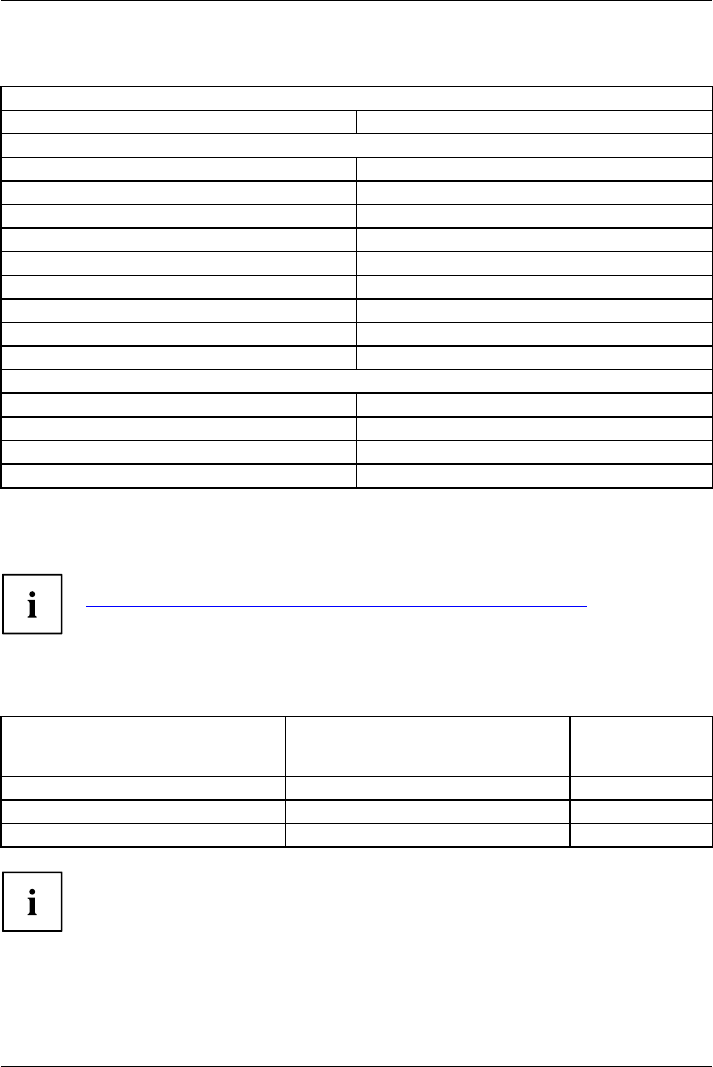
Technical data
Port replicator (optional)
Electrical data
Protection class III
Ports
VGA monitor port 15-pin socket
DVI-D monitor port 25-pin socket
Display Port 2 x
LAN port RJ45
USB (Universal Serial Bus) 4 x USB 3.0
eSATA port 1x
Audio Headphones and microphone port
Docking port 100-pin
Security Lock 1x
Ambient conditions
Environment class DIN IEC 721 7K1
Mechanism class DIN IEC 721 7M2
Operating temperature 5℃.... 35℃/ 41°F .... 95°F
Transit temperature –15°C .... 60°C / 5°F .... 140°F
Rechargeable battery
For information on the batteries used in your device, please see
"http://solutions.us.fujitsu.com/www/content/support/contact/index.php".
In addition to the main battery, you can order an optional battery which is inserted in the module slot.
All rechargeable batteries are 6-cell batteries.
Main battery
Optional battery
(f ttinginthe
modular bay)
Rated voltage 11.25 V 10.8 V
Rated capacity 72 Wh 28 Wh
Rated power 6400 mAh 2600 mAh
The operating time depends on the device configuration, the active
applications and the energy saving settings.
104 Fujitsu

Technical data
AC adapter for use with notebook and port replicator
The following technical data applies to the AC adapter included in the scope of
delivery of the notebook and the optionally available port replicator.
Primary
Rated voltage 100 V to 240 V (automatic)
Rated frequency 50 Hz to 60 Hz (automatic)
Max. rated current 0.7 A to 1.2 A
Secondary
Rated power 90 W
Rated voltage 19 V
Max. rated current 4.74 A
An additional AC adapter or AC cable can be ordered at any time.
Fujitsu 105

Manufacturer’s notes
Manufacturer’s notes
Disposal and recycling
Notes
You can find information on this subject on your Tablet PC or on our website
("http://solutions.us.fujitsu.com/www/content/products/trade-in_program/").
Recycling your battery
Over time, the batteries that run your mobile computer will begin to hold a charge for a
shorter amount of time; this is a natural occurrence for all batteries. When this occurs, you
may want to replace the battery with a brand new one*. If you replace it, it is important
that you dispose of the old battery properly because batteries contain materials that
could cause environmental damage if disposed of improperly.
Fujitsu is very concerned with environmental protection, and has enlisted the services of the
Rechargeable Battery Recycling Corporation (RBRC)**, a nonprofit public service organization
dedicated to protecting our environment by recycling old batteries at no cost to you.
RBRC has drop-off points at many convenient locations throughout the United States and Canada.
To find the location nearest you, go to "www.RBRC.org" or call 1-800-822-8837.
If there are no convenient RBRC locations near you, you can also go to the EIA Consumer
Education Initiative website "http://EIAE.org/ " and search for a convenient disposal location.
Remember – protecting the environment is a cooperative effort, and you should
make every effort to protect it for current and future generations.
* To order a new battery for your Fujitsu mobile computer, go to the Fujitsu shopping site
at "www.shopfujitsu.com" in the US or "www.fujitsu.ca/products/notebooks" in Canada.
** RBRC is an independent third party to which Fujitsu provides funding for
battery recycling; RBRC is in no way affiliated with Fujitsu.
DOC (Industry CANADA) Notices
DOC(INDUSTRYCANADA)NOTICES
Radios and Television
This Class B digital apparatus meets all requirements of Canadian Interference-Causing Equipment
Regulations.
CET appareil numérique de la class B respecte toutes les exigence du Réglement
sur le matérial brouilleur du Canada.
106 Fujitsu
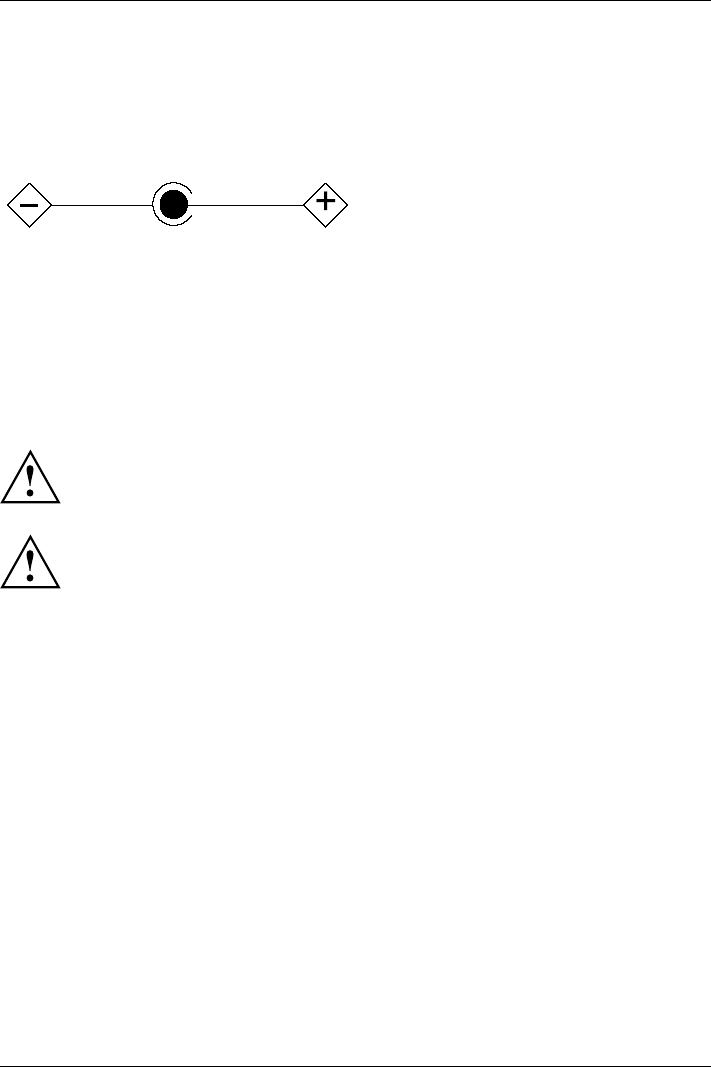
Manufacturer’s notes
UL Notice
IMPORTANT SAFETY INSTRUCTIONS
This unit requires an AC adapter to operate. Only use UL Listed I.T.E. adapters with an output rating
of 19 VDC, with a minimum current of 3.42A (65W). The correct output rating is indicated on the
AC adapter label. Refer to the illustration below for the correct AC adapter output polarity:
When using your notebook equipment, basic safety precautions should always be followed to
reduce the risk of fire, electric shock and injury to persons, including the following:
• Do not use this product near water for example, near a bathtub, washbowl, kitchen
sink or laundry tub, in a wet basement or near a swimming pool.
• Use only the power cord and batteries indicated in this manual. Do not dispose of batteries in a
fire. They may explode. Check with local codes for possible special disposal instructions.
SAVE THESE INSTRUCTIONS
For Authorized Repair Technicians Only
CAUTION:
For continued protection against risk of fire, replace only with the
same type and rating fuse.
WARNING:
Danger of explosion if Lithium (CMOS) battery is incorrectly replaced. Replace only
with the same or equivalent type recommended by the manufacturer.
Dispose of used batteries according to the manufacturer’s instruction.
Fujitsu 107

Manufacturer’s notes
ENERGY STAR Compliance
Your Fujitsu system is an ENERGY STAR qualified mobile PC. By
choosing a computer with the latest energy-saving technology, you’re
helping to preserve our environment for future generations. ENERGY
STAR is a joint program of the U.S. Environmental Protection Agency,
U.S. Department of Energy, Natural Resources Canada, and other
governments around the world helping us save money while protecting
the environment through energy efficient products and practices. With
energy costs and global warming top-of-mind for consumers, Fujitsu is
committed to offering solutions that help consumers conserve energy
and improve the quality of our environment.
Sleep mode:
You will notice that your computer is initially set so that the display turns off after 10 minutes of
user inactivity, and the computer goes into Sleep mode after 30 minutes of user inactivity. When
going into Sleep mode, the computer also reduces the speed of any active Ethernet network
links. To “wake” the computer from Sleep mode, press the Suspend/Resume Button.
Energy saving benefts:
Fujitsu ENERGY STAR qualified mobile PCs use about half as much electricity as standard
equipment – saving half in utility costs. But more than that, ENERGY STAR also makes a difference
for the environment. Did you know that the average house can be responsible for twice the
greenhouse gas emissions as the average car? That’s because every time you flip on a light
switch, run your dishwasher, or turn on your PC, you use energy, which means more greenhouse
gas emissions from power plants. So the more energy we can save through energy efficiency,
the more we help to reduce greenhouse gases and the risks of global warming.
To learn more about the important ENERGY STAR program, visit:"www.energystar.gov".
To read about how Fujitsu is supporting Sustainable Management along with
several other environmental activities, visit the Fujitsu Corporate Citizenship page at:
"http://www.computers.us.fujitsu.com/www/content/aboutus/environmental/environment.php".
108 Fujitsu
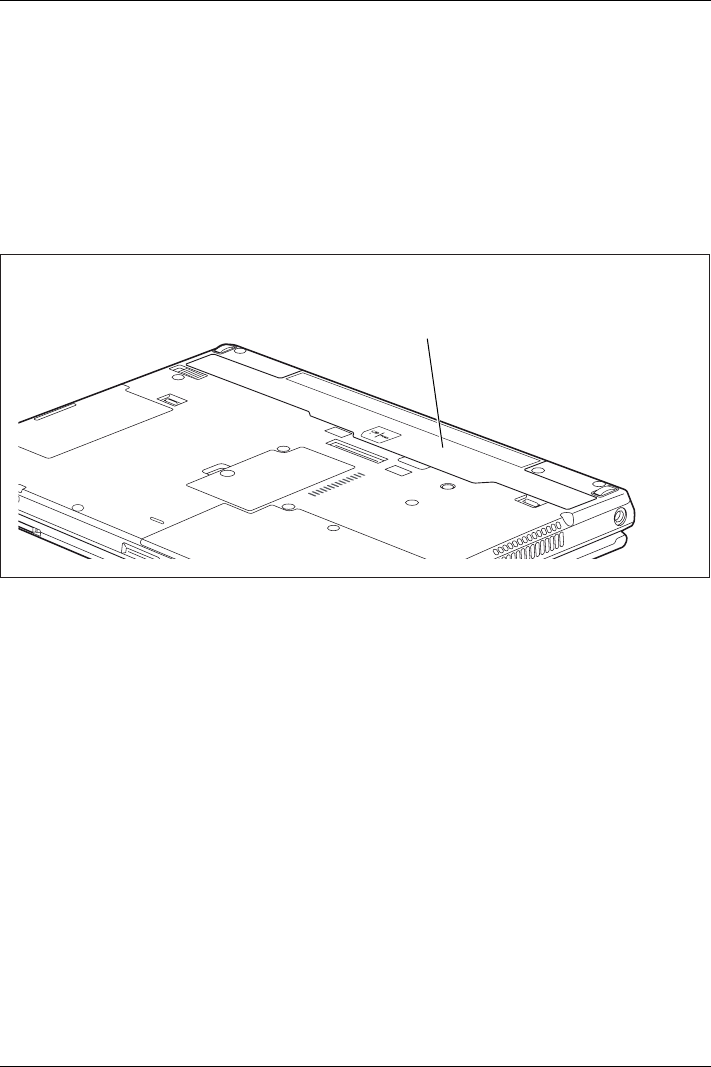
Declarations of conformity
Declarations of conformity
Declarationsof conformity
This device complies with Part 15 of the FCC Rules. Operations are subject to the following two
conditions: (1) This device may not cause harmful interference, (2) this device must accept any
interference received, including interference that may cause undesired operation.
The FCC ID and IC ID Label information is available under the battery of the unit. To access the
label information, remove the battery as explained on page 48 "Removing the battery." To
reinstall the battery see page 49 "Installing the battery."
Fujitsu 109
FCC ID and IC ID label information
can be found under the battery.

FCC Regulatory Information
FCC Regulatory Information
Please note the following regulatory information related to the wireless LAN
device.
You are cautioned that changes or modifications not expressly approved by the
part responsible for compliance could void the user’s authority to operate the
equipment.FCC RF Radiation Exposure Statement:
1. This Transmitter must not be co-located or operating in conjunction with any
other antenna or transmitter.
2. This equipment complies with FCC RF radiation exposure limits set forth for
an uncontrolled environment.
This equipment should be installed and operated with a minimum distance of 20
centimeters between the radiator and your body. For body worn operation, this
tablet has been tested and meets FCC RF exposure guidelines when used with
an accessory that contains no metal and that positions the handset a minimum of
0 mm from the body.
Use of other accessories may not ensure compliance with FCC RF exposure
guidelines. This device complies with Part 15 of the FCC Rules. Operation is
subject to the following two conditions:
1. this device may not cause harmful interference and
2. this device must accept any interference received, including interference that
may cause undesired operation of the device.
Regulatory Notes and Statements
Wireless LAN, Health and Authorization for use
Radio frequency electromagnetic energy is emitted from Wireless LAN devices. The energy levels of
these emissions, however, are far much less than the electromagnetic energy emissions from wireless
devices such as mobile phones. Wireless LAN devices are safe for use by consumers because they
operate within the guidelines found in radio frequency safety standards and recommendations. The
use of Wireless LAN devices may be restricted in some situations or environments, such as:
• On board an airplane, or
• In an explosive environment, or
• In situations where the interference risk to other devices or services is
perceived or identified as harmful.
In cases in which the policy regarding use of Wireless LAN devices in specific environments is
not clear (e.g., airports, hospitals, chemical/oil/gas industrial plants, private buildings), obtain
authorization to use these devices prior to operating the equipment.
110 Fujitsu

FCC Regulatory Information
Regulatory Information/Disclaimers
Installation and use of this Wireless LAN device must be in strict accordance with the instructions
included in the user documentation provided with the product. Any changes or modifications made
to this device that are not expressly approved by the manufacturer may void the user’s authority to
operate the equipment. The manufacturer is not responsible for any radio or television interference
caused by unauthorized modification of this device, or the substitution or attachment of connecting
cables and equipment other than those specified by the manufacturer. It is the responsibility of the
user to correct any interference caused by such unauthorized modification, substitution or attachment.
The manufacturer and its authorized resellers or distributors will assume no liability for any damage
or violation of government regulations arising from failure to comply with these guidelines.
This device must not be co-located or operated in conjunction with any other antenna or transmitter.
For IEEE 802.11a Wireless LAN: For operation within 5.15~5.25 GHz frequency range, it is
restricted to indoor environments, and the antenna of this device must be integral.
Federal Communications Commission and Industry
Canada statement:
This device complies with Part 15 of FCC Rules.
Operation is subject to the following two conditions: (1) This device may not cause
interference, and, (2) This device must accept any interference, including interference
that may cause undesired operation of this device.
FCC Interference Statement
This equipment has been tested and found to comply with the limits for a Class B digital
device, pursuant to Part 15 of the FCC Rules. These limits are designed to provide reasonable
protection against harmful interference in a residential installation. This equipment generates,
uses, and can radiate radio frequency energy. If not installed and used in accordance with
the instructions, it may cause harmful interference to radio communications. However, there
is no guarantee that interference will not occur in a particular installation.
If this equipment does cause harmful interference to radio or television reception, which
can be determined by turning the equipment off and on, the user is encouraged to try and
correct the interference by one or more of the following measures:
1. Reorient or relocate the receiving antenna.
2. Increase the distance between the equipment and the receiver.
3. Connect the equipment to an outlet on a circuit different from the one the receiver is connected to.
4. Consult the dealer or an experienced radio/TV technician for help.
Fujitsu 111

FCC Regulatory Information
FCC Radio Frequency Exposure statement
The available scientific evidence does not show that any health problems are associated with
using low power wireless devices. There is no proof, however, that these low power wireless
devices are absolutely safe. Low power wireless devices emit low levels of radio frequency
energy (RF) in the microwave range while being used. Whereas high levels of RF can produce
health effects (by heating tissue), exposure to low-level RF that does not produce heating
effects causes no known adverse health effects. Many studies of low-level RF exposure have
not found any biological effects. Some studies have suggested that some biological effects
might occur, but such findings have not been confirmed by additional research.
The wireless LAN radio device has been tested and found to comply with FCC radiation
exposure limits set forth for an uncontrolled equipment and meets the FCC radio frequency
(RF) Exposure Guidelines in Supplement C to OET65.
The exposure standard for wireless devices employs a unit of measurement known as the
Specific Absorption Rate, or SAR. The SAR limit set by the FCC is 1.6W/kg.
This device is compliant with SAR for general population /uncontrolled exposure limits in ANSI/IEEE
C95.1-1992, and had been tested in accordance with the measurement methods and procedures
specified in OET Bulletin 65 Supplement C. This device has been tested, and meets the FCC,
IC RF exposure guidelines when tested with the device operating conditions.
Export restrictions
This product or software contains encryption code which may not be exported or transferred
from the US or Canada without an approved US Department of Commerce export license.
This device complies with Part 15 of FCC Rules, as well as ICES 003 B / NMB 003 B.
Operation is subject to the following two conditions: (1) this device may not cause harmful
interference, and (2) this device must accept any interference received, including interference
that may cause undesirable operation. Modifications not expressly authorized by Fujitsu
America, Inc. may invalidate the user’s right to operate this equipment.
The highest FCC SAR value is 1.163 W/Kg (Body SAR).
Restrictions concernant l’exportation
Ce produit ou logiciel contient du code de chiffrement qui ne peut être exporté ou transféré du
Canada ou des États-Unis sans un permis d’exportation du département du commerce des
États-Unis. Ce matériel est conforme à la Partie 15 des règlements de la FCC, ainsi qu’à la
norme ICES 003 B/NMB 003 B. Son fonctionnement est soumis aux deux conditions suivantes
: (1) cet appareil ne doit pas causer d’interférence nuisible; (2) cet appareil doit accepter
toutes les interférences reçues, y compris celles pouvant causer un mauvais fonctionnement
de l’appareil. Toute modification n’ayant pas été expressément approuvée par la société Fujitsu
America Incorporated peut annuler le droit de l’utilisateur de se servir du matériel.
La valeur FCC SAR la plus élevée est de 1,163 W / Kg (SAR Body).
112 Fujitsu

Canada, Industry Canada (IC)
Canada, Industry Canada (IC)
This Class B digital apparatus complies with Canadian ICES-003 and RSS-247. This device
complies with Industry Canada licence-exempt RSS standard(s).
Operation is subject to the following two conditions:
1. This device may not cause interference, and
2. This device must accept any interference, including interference that may
cause undesired operation of the device.
IC RF Radiation Exposure Statement:
For body worn operation, this device has been tested and meets RF exposure guidelines when used
with an accessory that contains no metal and that positions the device a minimum of 0 mm from the
body. Use of other accessories may not ensure compliance with RF exposure guidelines.
Cet appareil numérique de classe B est conforme à la norme NMB-003 et
RSS-247. Le présent appareil est conforme aux CNR d’Industrie Canada applicables
aux appareils radio exempts de licence.
L’exploitation est autorisée aux deux conditions suivantes:
1. l’appareil ne doit pas produire de brouillage, et
2. l’utilisateur de l’appareil doit accepter tout brouillage radioélectrique subi, même si le
brouillage est susceptible d’en compromettre le fonctionnement.
Déclaration de l’exposition aux radiations RF:
Pour le fonctionnement du corps, ce téléphone a été testé et répond aux directives
d’exposition RF lorsqu’il est utilisé avec un accessoire qui ne contient pas de métal et
qui place le combiné d’un minimum de 0 mm du corps. Utilisation d’autres accessoires
peut ne pas assurer le respect des directives d’exposition RF.
Canadian Notice
The device for the 5150 - 5250 MHz band is only for indoor usage to reduce the potential
for harmful interference to co-channel mobile satellite systems.
The maximum antenna gain of 6 dBi permitted (for devices in the 5250 - 5350 MHz, 5470 - 5725
MHz and 5725 - 5825 MHz bands) to comply with the e.i.r.p. limit as stated in RSS-247.
In addition, users are cautioned to take note that high power radars are allocated as primary
users (meaning they have priority) of 5250 - 5350 MHz and 5650 - 5850 MHz and these
radars could cause interference and/or damage to LE-LAN devices.
Fujitsu 113

Canada, Industry Canada (IC)
Avis pour le Canada
Le matériel destiné à un usage sur la bande 5 150 - 5 250 MHz doit être utilisé
uniquement à l’intérieur afin de réduire les risques de brouillage nuisible causé aux
systèmes mobiles par satellite fonctionnant sur un même canal.
Un gain d’antenne de 6 dBi est autorisé (pour le matériel utilisant les bandes 5 250 - 5 350
MHz, 5 470 - 5 725 MHz et 5 725 - 5 825 MHz), conformément à la limite p.i.r.e. maximale
permise selon l’annexe A9.2 afférent aux périphériques RSS-247.
En outre, les utilisateurs doivent prendre garde au fait que les radars de grande puissance
sont considérés comme des utilisateurs principaux (ce qui signifie qu’ils sont prioritaires) des
bandes 5 250 - 5 350 MHz et 5 650 - 5 850 MHz et qu’ils pourraient causer des interférences
et/ou des dommages aux appareils de réseau exempts de licence.
114 Fujitsu

Appendix
Appendix
Before Using the Optional Wireless LAN
This manual describes the procedures required to properly set up and configure the optional
integrated Wireless LAN Mini-PCI device (referred to as "WLAN device" in the rest of the
manual). Before using the WLAN device, read this manual carefully to ensure its correct
operation. Keep this manual in a safe place for future reference.
Wireless LAN Devices Covered by this Document
This document is applicable to systems containing the following device:
• Intel® Dual Band Wireless-AC 8265 – 11a/b/g/n/11ac
Characteristics of the WLAN Device
• The WLAN devices are PCI Express Mini cards attached to the main board of the mobile computer.
• The WLAN devices operate in license-free RF bands, eliminating the need to procure
an FCC operating license. The WLAN operates in the 2.4GHz Industrial, Scientific,
and Medical (ISM) RF band and the lower, middle, and upper bands of the 5GHz
Unlicensed National Information Infrastructure (UNII) bands.
• The WLAN devices are capable of five operating modes, IEEE802.11a, IEEE802.11ac,
IEEE802.11b, IEEE802.11g, and IEEE802.11n.
• The WLAN device is Wi-Fi certified and operates (as applicable) at the maximum data
rate of 450 Mbps in IEEE802.11n mode (300 Mbps in this configuration); 54 Mbps
in IEEE802.11g mode; and 11 Mbps in IEEE802.11b mode.
• The WLAN devices support the following encryption methods - WEP,
TKIP, CKIP, and AES encryption.
• The Wireless LAN devices are compliant with the following standards: WPA,
WPA2, CCX1.0, CCX2.0, CCX3.0, and CCX4.0.
Fujitsu 115
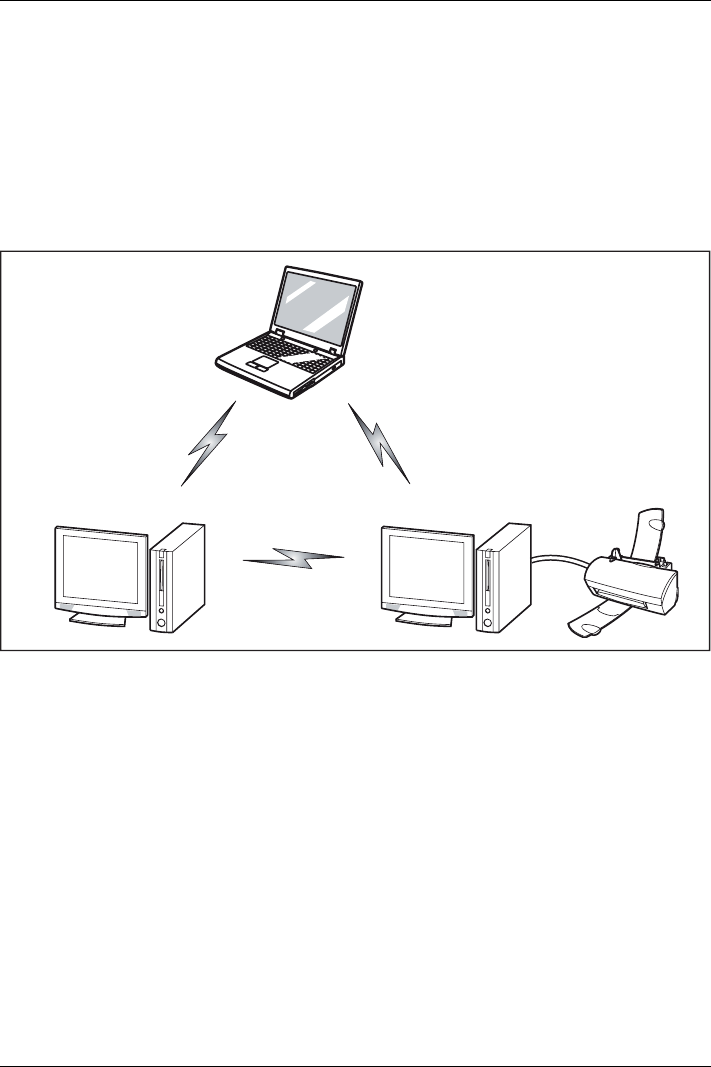
Appendix
Wireless LAN Modes Using this Device
Ad Hoc Mode
"Ad Hoc Mode" refers to a wireless network architecture where wireless network connectivity
between multiple computers is established without a central wireless network device, typically
known as Access Point(s). Connectivity is accomplished using only client devices in a peer-to-peer
fashion. That is why Ad Hoc networks are also known as peer-to-peer networks. Ad Hoc
networks are an easy and inexpensive method for establishing network connectivity between
multiple computers. Ad Hoc mode requires that the SSID, network authentication, and encryption
key settings are identically configured on all computers in the Ad Hoc network.
116 Fujitsu
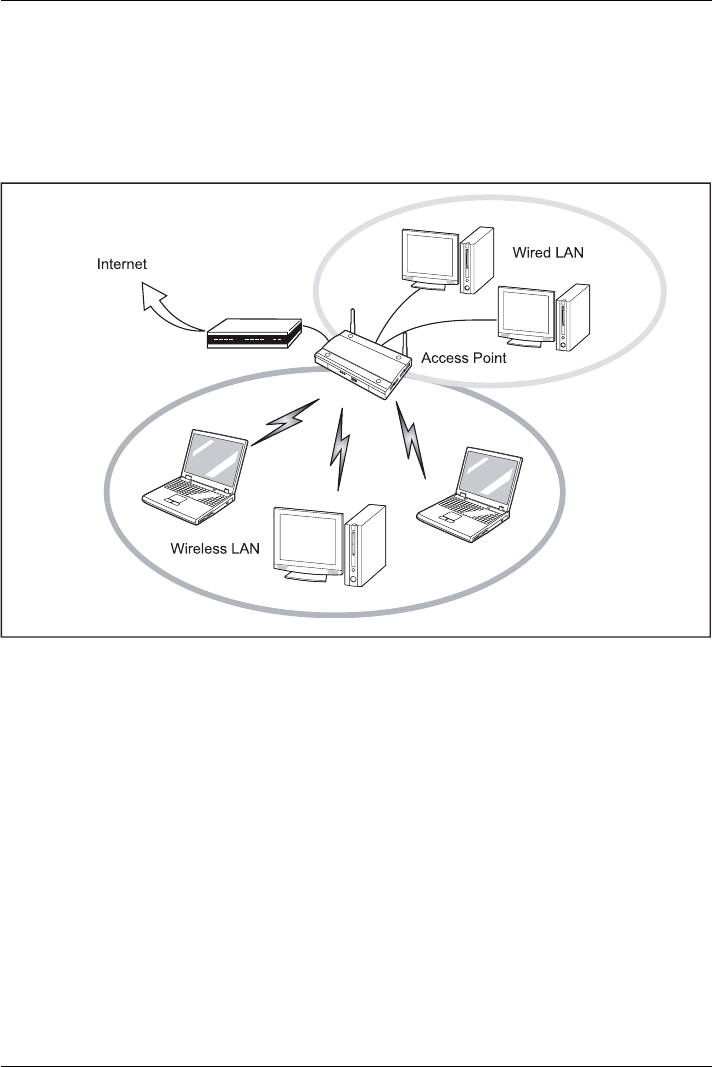
Appendix
Access Point (Infrastructure) Mode
Infrastructure mode refers to a wireless network architecture in which devices communicate with
wireless or wired network devices by communicating through an Access Point. In infrastructure
mode, wireless devices can communicate with each other or with a wired network. Corporate
wireless networks operate in infrastructure mode because they require access to the WLAN in
order to access services, devices, and computers (e.g., file servers, printers, databases).
**
*
* = An optional hub for a wired LAN may
be required depending upon the type
of access point used.
** = ADSL modem, cable modem, or similar
Fujitsu 117

Appendix
How to Handle This Device
The WLAN device is an optional device that may come pre-installed in your mobile computer. Under
normal circumstances, it should not be necessary for you to remove or re-install it. The Operating
System that your mobile computer comes with has been pre-configured to support the WLAN device.
• Integrated Intel Centrino wireless LAN devices support IEEE802.11a,
IEEE802.11b, IEEE802.11g, and IEEE802.11n.
• The WLAN device operates in the 2.4 GHz ISM band and the 5 GHz
lower, middle, and upper UNII bands.
• Microwave ovens may interfere with the operation of WLAN devices since they operate in the
same 2.4 GHz frequency range as IEEE802.11b/g/n devices. Interference by microwaves
does not occur with IEEE802.11a radio which operates in the 5 GHz RF band.
• Wireless devices that transmit in the 2.4 GHz range may interfere with operation of WLAN
devices in IEEE802.11b/g/n modes. Symptoms of interference include reduced throughput,
intermittent disconnects, and many frame errors. It is HIGHLY recommended that these
interfering devices be powered off to ensure proper operation of the WLAN device.
Deactivating/Disconnecting the WLAN Device
Disconnecting the WLAN device may be desired in certain circumstances (to extend battery
life) or where certain environments require it (i.e. hospitals, clinics, airplanes, etc.). The
WLAN device can be disconnected in Windows using the WLAN icon in the system tray
(Note that disconnecting via the icon in the system tray does not turn off the radio; it
continues to transmit and receive even though it’s not connected.)
118 Fujitsu

Appendix
Confguring the Wireless LAN
The optional WLAN device can be configured to establish wireless network connectivity
using the software that is built into Windows. Support for most industry standard
security solutions is contained in this software.
Pre-defined parameters will be required for this procedure. Please consult with
your network administrator for these parameters:
Confguring the WLAN Using Windows
The WLAN device can be configured to establish wireless network connectivity using
the software that is built into Windows Vista. Support for most industry standard
security solutions is contained in this software.
Pre-defined parameters are required for this procedure. Consult your network
administrator for these parameters:
1. From the Modern Start screen, press Windows +X, then select Control Panel from the menu.
2. If the Control Panelis not in Classic View, select Classic View from the left panel.
Double-click the Network and Sharing Center icon.
3. Select Setup a new connection or network.
4. Depending upon what type of connection you would like to make, make a selection. For
an infrastructure network, select Manually connect to a wireless network.
5. Enter the required information. It may be necessary to consult with your network
administrator for some of the information.
6. In the event you require assistance, go to the Network and Sharing Center window (Control
Panel > Network and Sharing Center), and type in relevant keywords in the Search box.
Connection to the network
After you have configured your computer, you can connect to an active network
by performing the following steps:
1. Click on the WLAN icon in the system tray.
2. Select Connect to a network.
3. Select a network from the list that appears, and click the Connect button.
Fujitsu 119

Appendix
Troubleshooting the WLAN
Causes and countermeasures for troubles you may encounter while using your
wireless LAN are described in the following table.
Problem Possible Cause Possible Solution
Incorrect network name (SSID)
or network key
Ad hoc connection: verify that
the network names (SSID’s)
and network keys (WEP) of
all computers to be connected
have been configured correctly.
SSID’s and WEP key values
must be identical on each
machine.
Access Point (Infrastructure)
connection: set the network
name (SSID) and network key
to the same values as those of
the access point.
Set the Network Authentication
value identically to that of the
Access Point. Please consult
your network administrator for
this value, if necessary.
Unavailable network connection
Weak received signal strength
and/or link quality
Ad hoc connection: Retry
connection after shortening
the distance to the destination
computer or removing any
obstacles for better sight.
Access Point (Infrastructure)
connection: Retry connection
after shortening the distance to
the access point or removing
any obstacles for better sight.
120 Fujitsu

Appendix
Problem Possible Cause Possible Solution
The WLAN device was
deactivated or is disabled Check if the wireless switch
is turned On. Go to Start >
Control Panel, and doubleclick
on Windows Mobility Center.If
the wireless network is off, click
the Turn wireless on button.
The computer to be connected
is turned off Check if the computer to be
connected is turned ON.
Incorrectly configured network
settings Recheck the configuration of
your network settings.
RF interference from Access
Points or other wireless
networks
The use of identical or
overlapping RF channelscan
cause interference with the
operation of the WLAN device.
Change the channel of your
Access Point to a channel
that does not overlapwiththe
interfering device.
Wireless network authentication
has failed Re-check your Network
Authentication, Encryption,
and Security settings.
Incorrectly configured
security settings such as
an incorrectly typed WEP
key, a mis-configured LEAP
username, or an incorrectly
chosen authentication method
will cause theLANdeviceto
associate but not authenticate
to the wireless network.
Unavailable network connection
(continued)
Incorrect IP address
configuration This only applies to networks
using static IP addresses.
Please contact your network
administrator for the correct
settings.
Fujitsu 121

Appendix
Using the Bluetooth Device
Bluetooth is integrated into the Wireless LAN module. The Bluetooth capabilities are Bluetooth
Basic, EDR and Bluetooth Low Energy (BT v4.0) operational modes.
What is Bluetooth
Bluetooth technology is designed as a short-range wireless link between mobile devices, such
as laptop computers, phones, printers, and cameras. Bluetooth technology is used to create
Personal Area Networks (PANs) between devices in short-range of each other.
Proceed as follows to individually enable or disable wireless LAN or Bluetooth devices:
1. In the screen Modern Start, select the option Charms > Settings
> Change PC Settings > Wireless.
2. Under Wireless > Wireless Devices, click on the switch Bluetooth to switch on Bluetooth.
Where to Find Information About Bluetooth
For additional information about Bluetooth Technology, visit the Bluetooth
Websiteat: "www.bluetooth.com".
FCC Radiation Exposure Statement
This system complies with the FCC limit values for radio frequency radiation in an uncontrolled
environment. The Bluetooth antenna is located at the top edge of the LCD screen and is exempt
from the criteria for minimum distance because of its low power consumption.
The transmitter used in this system must not be operated together with other antennas or transmitters.
Canadian Notice
To prevent radio interference to licensed services, this system is designed for use in indoor spaces
/ in buildings and not directly at window openings, to allow a maximum shielding.
Warranty
Users are not authorized to modify this product. Any modifications invalidate the warranty.
This equipment may not be modified, altered, or changed in any way without signed
written permission from Fujitsu. Unauthorized modification will void the equipment
authorization from the FCC and Industry Canada and the warranty.
122 Fujitsu

Appendix
Image Backup and Recovery Procedures
The following instructions cover separate Backup and Recovery Procedures for Windows®
7 and Backup and Recovery Procedures for Windows 10. Please follow instructions
that are applicable to your system’s operating system.
Windows® 7 Procedures
It is very important that you create DVD copies of your Recovery Image and
Bootable Disc before beginning to use your system.
It is also important that you create a copy of essential software to external writable
media or an external drive. Follow the instructions in the "“Creating a Backup of the
System-Specific Software Drivers”"section to create the copy.
Creating a Backup of Bootable Disc and Recovery
Image for Windows 7
When you purchased your new system, a copy of the recovery image was loaded into a
hidden partition on your hard disk drive. Having a copy of the recovery image available to
you means that in the event of system failure, you will be able to restore it.
Tomakeacopyofth
e recovery image to DVD discs, you will need three or four blank
discs to create the copy. After creating the copy, be sure to label the discs and keep
them in a safe place to ensure they do not get damaged.
Note: If your system does not have an internal writable DVD drive, connect your system
to an external drive* before beginning the following steps.
* DEPENDING UPON YOUR OPTICAL DRIVE AND MEDIA FORMAT USED, SOME MEDIA
TYPES MAY BE INCOMPATIBLE FOR CREATING IMAGE BACKUPS.
1. Launch System Restore and Recovery from the desktop icon. It will allow you to create
the Bootable Disc and the Recovery Image Disc Set.
2. On Step 1: Select the Bootable Disc from the list:
a. Select a media type.
b. Notice the number of discs that are needed for the set.
c. Click Next to proceed.
3. On Step 2: Confirm your Recovery Disc,clickNext.
4. On Step 3:follow the on-screen instructions to make the disc or disc set, then click Start.
It takes approximately 20 minutes to make one disc.
5. On Step 4, when the disc creation is completed, a message appears.
Click Finishto exit the program.
6. RepeatStep 1: Select Recovery Disc from the list and repeat the above
steps 2(a), 2(b), 2(c), 3, 4 and 5.
Fujitsu 123

Appendix
Creating a backup of the System-Specifc Software Drivers
We recommend you to create a backup of the content of the C:\Drivers on your system
to writable media or an external drive. System-specific software drivers are also
available for download through the Fujitsu support site.
WINDOWS 7 RECOVER YOUR SYSTEM WHEN THE
HARD DRIVE IS STILL ACCESSIBLE
Using the Recovery and Utility Tools
The Recovery and Utility tools consist of a variety of tools that will help you recover your
recovery image and system images, and delete the data from your hard drive.
Methods for accessing the utilities
Recovery and Utility Tools are preinstalled in a hidden partition by the factory, or
they can be accessed by using the bootable disc.
Note: The Recovery and Utility tools may be deleted from your hard disk drive if you modify the
partitions. If that occurs, you will not be able to use the hidden partition for booting to Recovery
and Utility Tools, but you will still be able to boot from the Bootable Disc.
Determining whether Recovery and Utility is pre-loaded
1. Turn on or reboot your system. When the Fujitsu logo appears, press the F12 key.
2. Use the Tab key to get to the Application Menu.
3. Check whether the Recovery and Utility option is present. If it is not present, it means that
the utility must be used from the Bootable Disc. Proceed to the "“Running Recovery and
Utility from the Bootable Disc”"section if Recovery and Utility is unavailable.
Running Recovery and Utility from hard disk
1. Turn on or reboot your system. When the Fujitsu logo appears, press the F12 key.
2. Use the Tab key to get to the Application Menu.
3. Move the cursor down to Recovery and Utility and press the Enter key.
4. Choose your language, if necessary. Select Recovery and Utility to proceed.
5. Three tool options appear: Diagnostics,Recovery, and Utility (refer to the" Recovery and
Utility tools "section below for instructions on how to use these tools).
6. If this was successful please skip the next step and go to the "Recovery and Utility tools" section.
7. If this was NOT successful, please go to the next step.
Running Recovery and Utility from the Bootable Disc
Note: If your system does not have an internal writable DVD drive, connect
your system to an external drive.
To verify/change the boot-up priority (rather than booting-up from the hard drive or
an external media drive), perform the following steps:
1. Power on your system. When the Fujitsu logo appears on the screen, press the F12 key.
2. Insert the bootable disc into the drive tray.
3. Highlight the CD/DVD option from the Boot menu, then press Enter .
124 Fujitsu

Appendix
4. Click OK.
5. Select CD/DVD boot mode: UEFI Mode, if applicable then press Enter . While the
files are being loaded from the disc, the Fujitsu logo screen will appear followed
by a progress bar at the bottom of the screen.
Recovery and Utility tools
Note: Recovery and Utility tools may not be available on your system depending
on the region from which the system was shipped.
Diagnostics tool: The Diagnostics tool is designed for use by IT professionals. It is not likely you
will need to use this tool. If you should need to use this tool, perform the following steps:
1. Press the Diagnostics Toolbutton to start the Diagnostics tool.
2. Read the note, and then click OK.
3. Choose one or more of the following options for diagnostics on the Fujitsu Hardware Diagnostics
Tool window: CPU, Memory, Display, Hard Disk, CD/DVD/BD, Floppy Disc, Keyboard, and Mouse.
4. Click the Option buttonintheTool menu to specify how many times the tool
should run diagnostics on each selected component.
5. Press Execute to start the Diagnostics tool.
6. After the execution is completed, the selected components are circled in red to indicate that they
have been diagnosed and the result dialog window opens. Click Close to close the window.
7. Click End to close the Diagnostics tool, and then click Yes to confirm the end of diagnostics session.
Recovery tool: The Recovery tool contains two options:
•Restore C Drive: Restore recovery image (only C: drive)
•Restore Full Hard Drive: Restore recovery image (full hard drive).
You can use these tools to restore the Recovery Image from the hidden partition, and perform a full
hard drive recovery. Please refer to instructions above for details on how to create a Recovery Image.
Restore the Recovery Image from the Hidden Partition
1. Click Restore C: drive from the Recovery and Utility tools.
2. The progress bar is followed by Restore Recovery image (only C: drive) screen confirming
that the image will be restored to the C: drive. Click Next.
3. Read the instructions screen and select Agree, then click Next.
4. Click OK to acknowledge the warning message to restore recovery image to the C: drive.
5. When the progress bar appears, wait for the process to complete.
6. Click Finishwhen the process completes; the computer will restart to Windows.
Fujitsu 125

Appendix
RECOVER YOUR SYSTEM WHEN THE HARD DRIVE
IS NOT BOOTABLE FOR WINDOWS 7
Restore the Recovery Image for Full Hard Disk
Follow the steps in the "Recovering your Recovery Image using Recovery and Utility
(for new hard drive or non-bootable hard drive)"section. You will need the Bootable
Disc and the Recovery Disc Set for this task.
Utility tool: If applicable for your region, the Utility tool contains two options:
Hard Disk Data Delete and Partition Creation.
•TheHard Disk Data Delete utility is used to delete all data on the hard disk
and prevent the data from being reused.
NOTE: Do not use the Hard Disk Data Delete utility unless you are absolutely certain
that you want to erase your entire hard disk, including all partitions.
To delete hard disk data:
a. Click the Hard Disk Data Delete button. The progress bar appears, followed
by the End User License Agreement (EULA) screen.
b. Agree to the EULA and click Next.
c. Choose the hard disk from which the data should be deleted in the
list of hard disks and click Next.
•ThePartition Creation utility is used to change the C: and D: drive partition sizes.
WARNING: It is highly recommended that you send your product to Fujitsu Service to replace a
hard drive. A mistake could possibly destroy your computer, your new hard drive or both.)
126 Fujitsu

Appendix
Recovering Your Recovery Image Using Recovery and Utility
(for new hard drive or non-bootable hard drive)
If you have installed a new hard drive or your hard drive is not bootable, perform the following steps.
Note: You will need the Bootable disc and Recovery Image disc set for this recovery.
1. Power on your system. When the Fujitsu logo appears on the screen, press the F12 key.
2. Insert the bootable disc in your DVD drive, then click OK.
3. Highlight the CD/DVD option from the Boot Menu and press Enter .
4. Select CD/DVD boot mode: Select UEFI Mode, if applicable and press Enter .
While the files are being loaded from the disc, the Fujitsu logo screen appears
followed by a progress bar at the bottom of the screen.
5. Choose your language, if necessary.
6. Three tool options appear: Diagnostics,Recovery and Utility. Select Recovery.
• Select Restoring the Factory Image (full hard drive recovery).
7. Click Next to confirm full hard drive restoration. All data on the hard disk drive will be deleted.
8. Agree to the EULA by selecting the Agree option and clicking Next.
9. Click Next on the Recovery Disc. Check screen to verify that the bootable
disc has been inserted into the optical drive.
10. The Checking for Recovery Disc screen appears followed by the prompt to insert the
first disc. Click OK to continue. Repeat this step for all discs. After all recovery discs
have been checked and the check has been completed, click Next.
11. Follow the prompt to reinsert the first recovery disc and click Next.
12. Click OK when you receive the final warning informing you that all data on hard
diskdrive C will be lost. This starts the recovery process.
13. Follow the prompts to insert the next recovery discs and click OK.
14. After the copying of the image to the hard disk drive completes the restore
process is complete, click Finish to restart the system. The computer will restart
automatically and then go through the firstbootprocess.
Fujitsu 127

Appendix
Installing the Software after the Recovery Image is Restored
Note: The following steps are needed only if you restore the image from the
DVD Recovery Disc Set that you purchased.
Installation of essential access software
1. Insert the bootable disc in your DVD drive.
2. Open the Drivers folder in the disc, and follow the steps in readme.txt. If there is not a Drivers
folder in the Bootable Disc, the computer does not need the essential access software.
The recovery image already has the essential access software installed.
3. You can now connect to the Internet and download FSDM (Fujitsu Software Download
Manager) from the support site and download all the software applicable to the
model and OS using FSDM if they are not downloaded yet.
Auto Installation support for the software downloaded from support website
1. Download FSDM (Fujitsu Software Download Manager) from the support site and download all
the drivers applicable to the model and OS using FSDM if they are not downloaded yet.
2. When the software packages are downloaded from the web, it is important to
download the Auto Installer Software package and the model/language-specific
Readme file if you prefer to auto install the software.
3. It is important to have the extracted Auto Installer software package folder
and Readme file in the same location as other software folders. Otherwise
auto-installation of the software will not be supported.
4. Inside the Auto Installer software package, launch FjAutoinstall.exe as administrator.
5. Click Yes on the User Account Control dialog box. This will take some time to
process the software packages. A message will be displayed during this time
stating Please wait while the content is being processed.
6. If the EULA is displayed for the Fujitsu Software Auto Installer, accept
the EULA, otherwise continue.
7. The Fujitsu Software Auto Installer user interface will be launched providing the ability
to auto install the software downloaded from support site.
8. It is recommended that you install all the software in the listed order. You can
Select All, to install the software in the order listed.
9. Click the Install button to start the installation.
10. After installing all the selected drivers, the Installation Results window is displayed. Click OK.
11. The You must restart the system for the settings to take effect. Do you wish to
reboot now? message appears. Select Yes.
12. The system will now reboot.
128 Fujitsu

Appendix
Windows® 10 Procedures
It is very important that you create your Recovery Drive before beginning to use your system.
It is also important that you create a backup of the content of the C:\Drivers on your
system to writable media or an external drive. System-specifcsoftwaredriversare
also available for download through the Fujitsu support site.
Note: Most of the information below comes from the Microsoft® page
"http://windows.microsoft.com/en-us/windows-10/windows-10-recovery-options" .
Please refer to it for more details.
Creating a recovery drive
A recovery drive can help you troubleshoot and fix problems with your PC, even if it
won’t start. To create one, all you need is a USB flash drive. Windows will inform you
ofthesizetheUSBflash drive needed to hold the required data.
1. From the taskbar, search for Create a recovery drive and then select it. You may be
asked to enter an administrator password or confirm your selection.
2. When the tool opens, make sure Backup system files to the recovery drive
is selected and then select Next.
3. Connect a USB drive to your PC, select it, and then select Next - Create. A large number of
files need to be copied to the recovery drive, so this could take some time.
4. When it’s done, select Finish.
Note:
If you chose not to back up the system files when you created your recovery drive on
Windows 10, you won’t be able to use it to reinstall Windows.
Recovery options in Windows 10
If your PC isn’t running as quickly or reliably as it used to, try one of these recovery
options. The following table can help you decide which one to use.
Problem Try this
Your PC isn’t working well and you recently
installed an app, driver, or update. Restore from a system restore point
Your PC isn’t working well and it’s been a while
since you installed anything new. Reset your PC
Your PC won’t start and you’ve created a
recovery drive. Useare
covery drive to reinstall Windows
Your PC won’t start and you haven’t created a
recovery drive. Use installation media to reinstall Windows
Restore from a system restore point
This option takes your PC back to an earlier point in time, called a system restore point. Restore
points are generated when you install a new app, driver, or Windows update, and when you
create a restore point manually. Restoring won’t affect your personal files, but it will remove
apps, drivers, and updates installed after the restore point was made.
Fujitsu 129

Appendix
1. Right-click (or press and hold) the Start button, and then select Control Panel.
2. Search Control Panel for Recovery.
3. Select Recovery -Open System Restore - Next.
4. Choose the restore point related to the problematic app, driver, or update,
and then select Next -Finish.
Note: If you don’t see any restore points, it could be because the system protection isn’t turned
on. To check, go to the Control Panel,searchforRecovery, and then select Recovery - Configure
System Restore - Configure and make sure Turn on system protection is selected.
Reset your PC
Option What it does
Keep my files This reinstalls Windows 10, but keeps your personal files and any
apps that came with your PC. It removes:
• Changes you made to settings
• Apps and drivers you installed
Remove everything This reinstalls Windows 10 and any apps that came with your PC.
It removes:
• Personal files
• Changes you made to settings
• Apps and drivers you installed
If you’re planning to donate, recycle, or sell your PC, use this option
and choose to fully clean the drive. This might take an hour or
two, but it makes it harder for other people to recover files you’ve
removed.
Use a recovery drive to reinstall Windows
Note: This process utilizes the USB Recovery Drive that you created in the
previous section "Create a Recovery Drive".
1. Connect the recovery drive and turn on your PC.
2. On the Choose an option screen, select Troubleshoot - Reset this PC, and then
choose the reset option that’s best for you.
If that doesn’t fix the problem, try Troubleshoot - Recover from a drive. This will remove your personal
files, apps and drivers you installed, and changes you made to settings. If you repartitioned the
drive Windows is installed on, note that this will restore the drive’s default partitions.
Use installation media to reinstall Windows
If you have installation media, like a Recovery DVD that you purchased from
Fujitsu, you can use it to reinstall Windows. You will need to install additional
drivers and applications after reinstalling Windows.
To reinstall Windows, follow the steps below:
1. Power on your system. When the Fujitsu logo appears on the screen, press the F12 key.
2. Insert the bootable disc in your DVD drive.
3. Highlight the CD/DVD option from the Boot Menu and press Enter .
130 Fujitsu

Appendix
4. Follow the on-screen instructions to restore the image.
• Select the language.
• At the Windows Setup dialog window, enter your OS, language and other
preferences and click Next to continue.
• Click Install now to proceed with reinstalling Windows.
• At License terms, check on I accept the license terms and click Next.
•AtWhich type of installation do you want, click on Custom: Install Windows only (advanced).
• Delete all partitions on the drive and click Next. Installation of Windows will start. This will
take some time so please wait until the installation is finished and the system restarts.
5. When the system restarts, perform all set-up steps to arrive at the Desktop.
6. Connect to the Internet.
7. Use the Backup of the contents of the C:\Drivers to install needed drivers and
applications to your system. If it is not available, download the software from the
Fujitsu Support Site, as described below in the "Auto Installation support for the
software downloaded from support website" section below.
Installation of essential access software
1. Insert the bootable disc in your DVD drive.
2. Open the Drivers folder in the disc, and follow the steps in readme.txt. If there is not a Drivers
folder in the Bootable Disc, the computer does not need the essential access software.
The recovery image already has the essential access software installed.
3. You can now connect to the Internet and download FSDM (Fujitsu Software Download
Manager) from the support site and download all the software applicable to the
model and OS using FSDM if they are not downloaded yet.
Auto Installation support for the software downloaded from support website
1. Download FSDM (Fujitsu Software Download Manager) from the support site and download all
the drivers applicable to the model and OS using FSDM if they are not downloaded yet.
2. When the software packages are downloaded from the web, it is important to
download the Auto Installer Software package and the model/language-specific
Readme file if you prefer to auto install the software.
3. It is important to have the extracted Auto Installer software package folder and
Readme file in the same location as the other software folders. Otherwise
auto-installation of the software will not be supported.
4. Inside the Auto Installer software package, launch FjAutoinstall.exe as administrator.
5. Click Yes on the User Account Control dialog box. This will take some time to
process the software packages. A message will be displayed during this time
stating Please wait while the content is being processed.
6. If the EULA is displayed for Fujitsu Software Auto Installer, accept the EULA, otherwise continue.
7. The Fujitsu Software Auto Installer user interface will be launched providing the ability
to auto install the software downloaded from the support site.
8. It is recommended that you install all the software in the listed order. You can
Select All, to install the software in the order listed.
9. Click the Install button to start the installation.
10. After installing all the selected drivers, the Installation Results window is displayed. Click OK.
Fujitsu 131

Appendix
11. You must restart the system for the settings to take effect. Do you wish to reboot
now? message appears. Select Yes.
12. The system will now reboot.
Downloading driver updates
To ensure that you always have the most current driver updates related to your system,
you should occasionally access the Fujitsu Software Download Manager (FSDM) utility.
The FSDM utility is available from the Fujitsu Support site. FSDM will allow you to view
and download the most current drivers, utilities and applications to determine whether
you have the latest versions. To download the FSDM utility, go to the support site:
"http://support.fujitsupc.com/CS/Portal/support.do?srch=DOWNLOADS".
132 Fujitsu

Index
Index
A
AC adapter
connecting 21
Set up 21
Acoustic warnings 98
Activate
keyboard backlight 43
Anti-theft protection 70
Audio connections 80
B
Back tab 44
Backspace 40
Backspace key 40
Battery 47
battery charge 55
Caring for and maintaining 47
charge level 47
Charging 47
Discharges too quickly 97
see Rechargeable battery 47
Self-discharge 47
Service life 47
Storing 47
battery charge meter 47
BIOS Setup Utility
, protecting with password 71
calling 89
exiting 91
operation 90
Settings 89
Blank LCD screen 93
Bluetooth
switching module off 59
switching module on 59
Bluetooth, Safety notes 16
Boards 81
Bonus Apps 22
C
Caps Lock 41
Caps Lock key 41
CD/DVD
Manual emergency removal 54
CD/DVD indicator 53
Charge capacity, battery 47
Choose a location 21
Components
Installing/Removing 81
Configuration, BIOS Setup Utility 89
Configuring hardware 89
Configuring system 89
Connecting audio devices 80
Connecting headphones 80
Connecting microphone 80
Cursor control 41
Cursor keys 41
D
Date not correct 93
Deactivate
keyboard backlight 43
Declarations of conformity 109
Display orientation
select 29
DOC (INDUSTRY CANADA) NOTICES 106
Drive
Removing 51
E
Emergency removal of optical disk 54
Ending
energy saving mode 96
Energy
Energy consumption 55
Energy saving 16
Energy saving functions 55
Enter 40
Enter key 40
Error messages on the screen 99
Errors
Acoustic warnings 98
Screen messages 99
ESD 81
Ethernet LAN 62
F
Fault
Elimination 92
Fingerprint sensor 69
configuring 69
First-time setup 20
Fn + F10 44
Fn key 41
Fn+F2 43
Fn+F3 43
Fn+F4 43
Fn+F5 43
Fn+F6 43
Fujitsu 133

Index
Fn+F7 43
Fn+F8 43
Fn+F9 43
G
Getting started 20
H
HDMI port 77
I
Important notes 15
In case of service 81
Incorrect time 93
Information,
safety 15
Instructions
Boards 81
K
Kensington Lock Cable 70
Keyboard 39
keys 39
L
Landscape format
display 29
LCD screen
Decrease brightness 43
difficult to read 93
Notes 33
reflected glare 93
Remains blank 93
Line feed 40
M
Main memory
see memory expansion 82
Making ready to use 21
Manual removal of optical disk 54
Mechanical security 70
Memory card
handling 56
inserting 56
removing 56
Memory expansion
installing 84
removing 83
Memory module
Important notes 82
installing 84
removing 83
Memory removal
see memory expansion 82
Microphone 57
Mobile operation 17
Modular bay 51
Modular bay device
Removing 51
Modules 51
Monitor
connecting 76
no image 94
remains blank 94
unstable image 94
Monitor port
see VGA socket 76
N
Notebook
before traveling 17
does not start 95
not working 96
operating 23
switching off 31
transporting 17–18
Notebook: switching on 26
Notes 15
disposal / recycling 106
Energy saving 16
LCD screen 33
Transport 17
Num Lock
indicator 42
Number keypad 39
Numeric keypad 39
see Virtual number keys 42
O
Operating system
activating system protection 72
cancel system protection 72
Protecting with password 72
Operation, notebook 23
Optical disk
Inserting 53
Removing 53
Optical disks
Handling 52
Optical drive 52
134 Fujitsu

Index
P
Packaging 20
Password
changing 71
entering 71
removing 72
Password protection 70
Port replicator
Connecting a notebook 64
Ports 63
Portrait format
display 29
Ports
Port replicator 63
Power saving 16
Power-on indicator 26
Printer does not print 96
Problem solving 92
R
Radio components
Safety notes 16
Rechargeable battery
see battery 47
Return 40
S
Safety information 15
Screen brightness
Decrease 43
Increase 43
Security functions 67
Smart Card 73
SystemLock 73
Self-discharge, battery 47
Service life, battery 47
Set up
Device 21
Setup
see BIOS Setup Utility 89
Shift 41
Shift key 41
Shift+Tab 44
SlotMemory cards 56
Speaker 57
Status indicators 23
Supervisor password
change 71
entering 71
removing 72
Switch between screen outputs 44
Switch off
speakers 43
Switch on
speakers 43
Switchingonforthefirst time 22
Symbols
Indicators 23
System expansion 82
see memory expansion 82
System settings, BIOS Setup Utility 89
T
Tab key 40
The wireless connection to a network
does not work 96
Time not correct 93
Tips 92
Touchpad 38, 43
buttons 38
dragging items 39
executing commands 38
Move pointer 38
selectinganitem 38
turn off 43
Touchpad button 43
TPM 74
Transport 17–18
Damage during transportation 20
Traveling, notebook 17
Troubleshooting 92
Trusted Platform Module 74
U
UMTS 61
antenna 61
USB charging function 78
USB ports 77
User password
change 71
entering 71
removing 72
Using the security lock 70
V
VGA socket 76
Virtual number keys 42
Volume
increase 43
reduce 43
Volume control 57
Fujitsu 135
